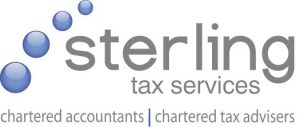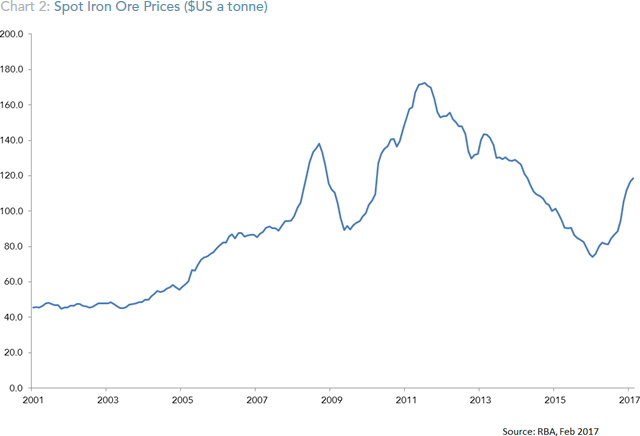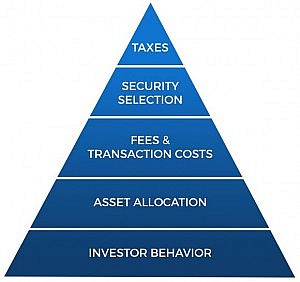Author Archives: Cathy
Why Use a Financial Adviser When Investing

A financial advisor can provide the perspective investors need to tune out the daily noise and stay focused on a long-term plan. Check out this video about why using a financial planning professional can give you peace of mind and ensure you stay on track to achieve your goals, and not be distracted by the ups and downs of the stock markets and media hype around the economy.
Click the link below for the video
The Difference the Right Financial Advisor Makes (dimensional.com)
SHARE THIS POST
Six Simple Mind Tricks For Dealing With Uncertainty

It may feel like we are living in extremely uncertain times, and that we now lack control over many important things in our lives, but is it still possible to be happy?
Here are six tips from experts in psychology and neuroscience on how to better manage the uncertainty in your life during these unprecedented times.
https://www.bbc.com/reel/video/p08bmr62/six-simple-mind-tricks-for-dealing-with-uncertainty
SHARE THIS POST
Compound Interest: What Every Investor Needs to Know

Compound interest is one of the most important things that an investor can understand. In this video, financial journalist NORMA COHEN explains how fundamental the concept is to successful investing – as well as the potential drawbacks that investors need to be aware of.
https://www.evidenceinvestor.com/compound-interest-what-you-need-to-know/
© The Evidence-Based Investor MMXXIV
SHARE THIS POST
Why work with a REAL Financial Planning adviser? And how do you know who to choose?

Many people think they need to have a large lump sum of money to invest before seeking advice from a financial adviser, however, this is not necessarily true!!
There are many types of financial advisers – investment adviser, mortgage adviser, insurance adviser, all coming under the name of ‘Financial Adviser’, so be sure you understand what their expertise is, before you engage their services – they need to fit with what you want and need.
When it comes to PLANNING however, where you want someone who has experience in a whole range of financial matters that we come across in our lives, such as paying off debt alongisde investing too, saving for your children’s future and your own retirement, where to invest your money (property, shares or both), how to ensure you have the right ownership structures in place (individually, jointly, in a Trust or your business), safeguarding your wealth and income with the best personal insurance and ACC solutions, and protecting your hard earn assets through Wills, Enduring Powers of Attorney and Trusts, you need the expertise of a FINANCIAL PLANNER.
A FINANCIAL PLANNER, especially a Certified Financial Planner CFPcm , is an expert who has the skills, qualifications and experience to cross all these arenas and provide you with holistic advice and ongoing guidance, giving you peace of mind, security, and someone you can use as sounding board when times are tough. They want to know who you really are and what’s important to you, so they can help you make informed decisions on how to ‘get ahead’ and save you from making any big mistakes that may ‘set you back’ financially.
Look for a Certified Financial Planner CFPcm who enjoys working across all areas of your financial life and wants to build a long term relationship with you, loves sharing knowledge and ideas yet will challenge you when needed, and will keep you on track to living your best life!
Jane Benton & Charlene Overell
G3 Financial Freedom Ltd
Certified Financial Planners CFPcm / Acredited Investment Fidudiaries AIF®
SHARE THIS POST
Let’s Talk Legacy: Engaging the Family in Financial Planning for the Next Generation

We hope this message finds you well and in good spirits as we approach the holiday season. As we gather together to celebrate our shared traditions, we wanted to propose a meaningful conversation that goes beyond the usual festive cheer.
We believe it’s time for us all to come together and discuss something equally important—our family’s financial future. It’s a topic that may not have been in the forefront of our conversations, but addressing it collectively could make a significant impact on the generations to come.
Here are a few thoughts on how we can all engage in meaningful financial planning discussions:
- Family Financial Gathering: Consider organising a family financial gathering during the holidays or another convenient time. This could be an informal get-together where everyone can share their individual financial goals, challenges, and dreams. Creating an open space for conversation can be enlightening and foster a sense of shared responsibility.
- Educational Sessions: To ensure that everyone is on the same page, why not arrange for educational sessions on financial planning. These sessions could cover topics like budgeting, investing, saving for education, and retirement planning. Bringing in a financial planning professional to guide everyone through these discussions could provide valuable insights tailored to your family’s unique needs.
- Setting Family Financial Goals: Collectively set financial goals for your family. Whether it’s saving for a significant event, creating an emergency fund, or planning for future generations, having clear objectives will guide your financial decisions and create a sense of purpose.
- Teaching Financial Literacy: Consider incorporating financial literacy into your family traditions. For instance, this could involve the younger members in budgeting discussions or sharing stories about financial successes and lessons learned. By instilling financial literacy early on, we empower the next generation to make informed decisions.
- Legacy Planning: Discussing your family legacy can be a powerful motivator for financial planning. Whether it’s passing down financial values, creating a family foundation, or ensuring a smooth transition of assets, planning for our financial legacy can bring a sense of continuity and purpose.
- Celebrate Milestones: Acknowledge and celebrate financial milestones within the family. Whether it’s paying off a significant debt, achieving a savings goal, or making a wise investment, recognising and celebrating these achievements fosters a positive financial culture within the family.
- Encourage Questions and Involvement: Create an environment where everyone feels comfortable asking questions and actively participating in financial discussions. By fostering an open dialogue, we can collectively learn from each other and make informed decisions.
We believe that by engaging in these conversations, we can lay the foundation for a financially secure and thriving family. Let’s embark on this journey together and make financial planning an integral part of our family legacy.
Please feel free to reach out to us if you’d like assistance with you and your family considering any of these ideas.
Charlene Overell
G3 Financial Freedom Ltd
SHARE THIS POST
“Cooking Up Success: Crafting Your Financial Recipe for a Prosperous Future”

Just as a chef meticulously selects ingredients to create a masterpiece in the kitchen, achieving financial success requires careful planning and a strategic recipe. In the realm of personal finance, consider yourself the chef, and your financial goals the delectable outcome. In this article, we will explore the key ingredients and steps to concocting your financial recipe for a prosperous future.
- Define Your Financial Goals: Just as a chef starts with a vision of the dish they want to create, begin your financial journey by clearly defining your goals. Whether it’s purchasing a home, retiring comfortably, or starting a business, having a clear picture of your objectives is the first step in crafting your financial recipe.
- Create a Budget – The Foundation of Your Recipe: A budget is the financial foundation upon which success is built. Similar to measuring ingredients in a recipe, create a detailed budget that outlines your income, expenses, and savings goals. Knowing where your money is going allows you to make intentional decisions about how to allocate resources.
- Save and Invest – The Building Blocks of Wealth: Just as a chef carefully selects premium ingredients, be intentional about saving and investing. Set aside a portion of your income for savings and explore investment opportunities that align with your goals. Investments act as the building blocks of wealth, providing returns that can grow over time.
- Diversify Your Portfolio – Mix it Up: In the world of finance, diversification is akin to mixing different flavours to create a balanced dish. Diversify your investments across various asset classes to spread risk and enhance potential returns. A well-mixed portfolio can weather economic fluctuations and provide stability.
- Debt Management – Balancing Flavors: Just as a chef balances flavours in a dish, managing debt is about finding the right equilibrium. Prioritize high-interest debts and work towards paying them off. Consider consolidating or refinancing to achieve a more favourable balance in your financial flavours.
- Continuous Learning – The Seasoning of Success: Successful chefs are always learning and experimenting with new techniques. Similarly, financial success requires continuous learning. Stay informed about market trends, financial tools, and opportunities. This ongoing education adds seasoning to your financial recipe, enhancing its flavour over time.
- Emergency Fund – The Safety Net: Every chef has a contingency plan in case something goes wrong. Similarly, build an emergency fund as your financial safety net. Having three to six months’ worth of living expenses set aside provides peace of mind and ensures you can weather unexpected financial storms.
- Insurance – Protecting Your Recipe: Just as chefs use lids and covers to protect their creations, insurance safeguards your financial recipe. Ensure you have adequate health, life, and property insurance to protect against unforeseen events that could potentially disrupt your financial stability.
- Review and Adjust – Taste Testing Your Recipe: Successful chefs taste their creations throughout the cooking process. Similarly, regularly review your financial recipe. Assess your progress towards goals, adjust your budget as needed, and reallocate resources based on changing circumstances. This active involvement ensures your financial recipe stays on track.
- Seek Professional Advice – Consulting the Master Chef: Just as aspiring chefs seek guidance from master chefs, consider consulting with a financial planning adviser. A seasoned professional can provide insights, strategies, and guidance tailored to your unique financial palate, especially when you may only have time to create small parts of the financial dish yourself, needing an expert who can add their creative knowledge to better the end result.
Conclusion:
Creating a financial recipe for success is an art that requires patience, dedication, and careful planning. By defining your goals, budgeting, saving, and investing wisely, you can craft a recipe that leads to a prosperous and fulfilling financial future. Much like a well-prepared dish, your financial success will be the result of thoughtful preparation, attention to detail, and a dash of creativity. Bon appétit!
Charlene Overell
G3 Financial Freedom Ltd
SHARE THIS POST
Investing During Inflationary Times – Does A Term Deposit Really ‘Cut It’

So, what is inflation? Investopedia describes it as “a rise in prices, which can be translated as the decline of purchasing power over time”.
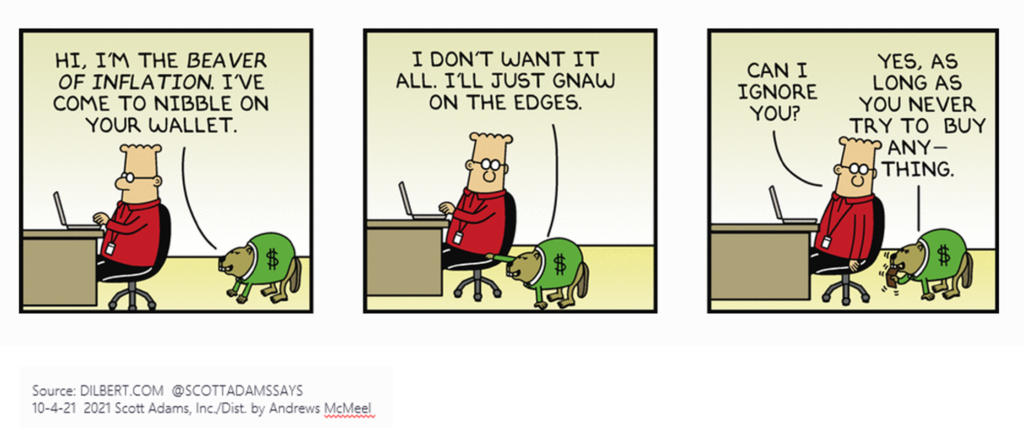
Let’s have a look at the price of a cup of black filter coffee over time:
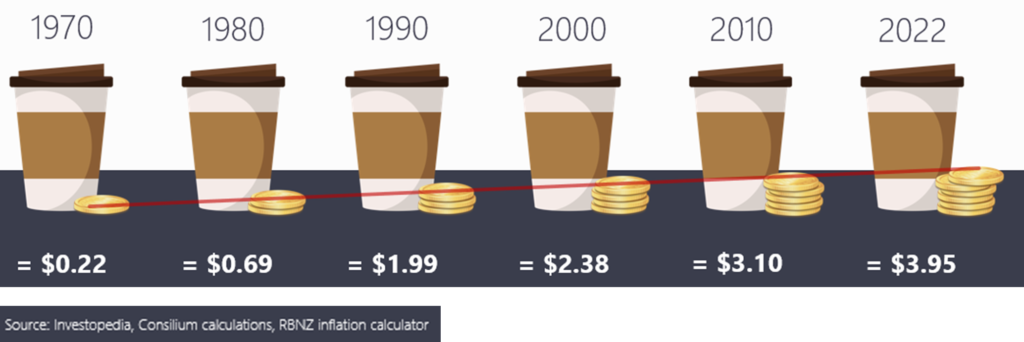
And the price of milk back in 1913 was $0.09 for 1 litre, which in 1963 would have bought you 1 small glass and today in 2023, would buy you 2 tablespoons!!
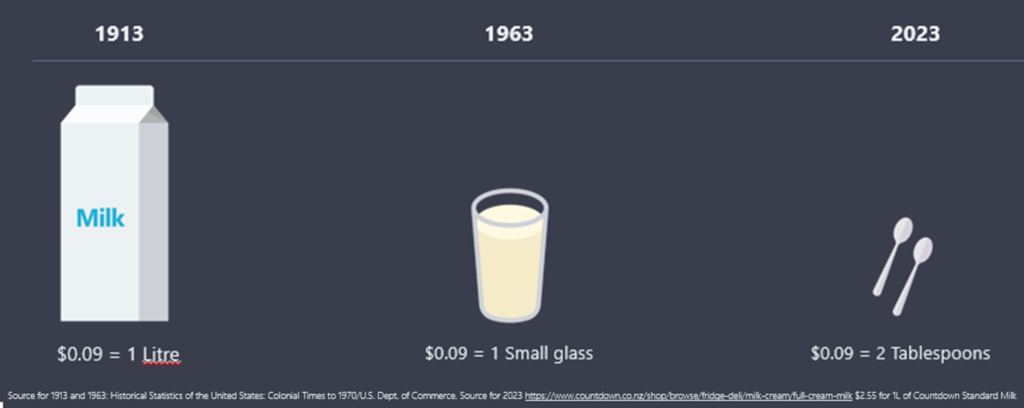
The inflation tax, by Warren Buffet:
“It makes no difference to a widow with savings in a 5% (term deposit) whether she pays 100% income tax on her interest income during a period of zero inflation or pays no income tax during years of 5% inflation. Either way, she is ‘taxed’ in a manner that leaves her no real income whatsoever. Any money she spends comes right out of capital. She would find outrageous a 100% income tax but doesn’t seem to notice that 5% inflation is the economic equivalent”.
Inflation erodes cash’s value
It appears that now, whilst bank savings interest rates are higher than they were a few years ago, there is a view by some people, that leaving money in cash in the bank, maybe within a term deposit account, is the best option to help grow their money, or at least leave it there whilst they feel the share markets or the economy will get better. Unfortunately this is a misconception. Whilst cash is good for short term savings for specific items, maybe a holiday, car, wedding or home deposit, and especially for emergency purposes, cash is not ideal for growing wealth for the long term. One of the most significant drawbacks of investing in cash is that it fails to keep pace with inflation
If we can receive a term deposit rate of say 6% pa (gross, so before tax), and inflation is running at 7%, then we have already lost 1% of its value in a year, meaning what we can buy today for our money, we will not be able to buy next year. If we are paying tax at the 30% rate too for example, then the rate after tax (net) is 4.2%. Turning this into dollars, if we invest $100,000 in that same term deposit account, then after 30% tax the interest earned at the year end is $4,200. However, whilst we still have the $100,000 in our account, as inflation was 7%, and we only earned 4.2% after tax, then this capital value has gone backwards in real terms to $97,200……..meaning that what we could have bought for $100,000 the previous year, is going to cost us $102,800 this year.
If we continue to invest in cash with the illusion that our capital will remain intact, then whilst on paper it will, in real terms it will not. Just compound the above example over many years and we can see how the value is being eroded year on year by inflation.
Diversification reduces risk
Thinking about what we want from our money in life, now, and over the medium and longer term, is the key, and then having our money allocated to different ‘buckets’ will support our spending needs throughout the rest of our life.
So yes, whilst cash is good for the short term savings we need for specific items and for a ‘rainy day’, having a well-diversified portfolio of shares and bonds will help to keep pace with inflation, grow wealth, and ensure there will be enough to pay the bills and enjoy the life we want over the next 10+ years.
Historically, the average annual return on the stock market, adjusted for inflation, has been significantly higher than the return on cash investments. Shares have the potential to provide us with the capital appreciation needed to grow wealth and maintain its value in the face of rising prices.
Investing solely in cash exposes our wealth to significant risks, such as economic downturns, changes in interest rates, and unexpected expenses that erode the value of our cash. Building a well-diversified portfolio, which typically includes shares and bonds from various industries, sectors and across the world, will reduce this risk. Diversifying worldwide also helps protect our investments from the impact of a single company’s poor performance or a specific economic downturn. Even during market fluctuations, the broader market tends to recover over time, reducing the risk of losing our entire investment.
Property vs shares
Property, like shares, is a growth asset and has historically shown to outperform cash over the longer-term too. However, whilst investing in property provides a rental income for those wanting income, or a potential capital growth in the future, we need to be careful that this income return is actually a good one for the risk we take, after taking account of all expenses for running the property and tax we have to pay. A capital gain can be achieved, however, we need to be mindful of what this gain may be after taking account of all costs during the term of holding it.
The downside of property is that if we need money for a specific spend, then we cannot ‘carve’ a lump sum of cash off of the side of our property, meaning it is illiquid. We would have to wait to sell it to release the cash value, or be forced to sell it (which may be not ideal depending upon property values). Holding a well-diversified quality share portfolio means we can release money when we need it, as this is liquid and shares/bonds can be sold pretty much straight away. Having a combination of both property and shares may be ideal depending upon your goals.
Conclusion
Whilst cash has its place in a well-rounded financial strategy, relying on it solely as an investment vehicle can hinder your long -term financial goals. The erosion of purchasing power due to inflation, limited returns, and the absence of compounding, makes cash less than ideal for wealth creation.
If you come into wealth suddenly, through the sale a property, a business, or an inheritance, then of course put this into cash in the bank temporarily – this will give you time to breath and to seek independent financial planning advice from an expert adviser who can carefully consider your risk tolerance and tailor a plan to suit your goals and tax position. Although shares come with their own set of risks, a well-managed portfolio can help you build wealth and achieve your financial objectives over time.
Charlene Overell 16.09.23
SHARE THIS POST
UK Supreme Court Delivers Milestone Judgement On A Bank’s Duty To Follow Customer Instructions

The United Kingdom’s Supreme Court has delivered an important judgement holding that where a customer has unequivocally authorised and instructed its bank to make a payment, the bank must do so and is not under any obligation to make further enquiries. This article from Bell Gully shares how they expect this judgment to be influential on New Zealand courts.
Sophie East and Jack Worthington
The United Kingdom’s Supreme Court has delivered an important judgment holding that where a customer has unequivocally authorised and instructed its bank to make a payment, the bank must do so and is not under any obligation to make further inquiries1.
This provides a refinement of what was previously referred to as the ‘Quincecare’ duty. In making this finding, the Supreme Court provides a helpful analysis of the agency relationship between a bank and a customer, and makes special mention of the scholarship of New Zealand academic, Professor Peter Watts. We expect the judgment to be influential on New Zealand courts.
Facts
The case concerned a couple, Dr and Mrs Philipp, who fell victim to a type of fraud known as “authorised push-payment” (APP) fraud. This is when an individual authorises their bank to send a payment of monies to a bank account that is controlled by a fraudster. In this case, Dr and Mrs Philipp were contacted by an individual claiming to working for the Financial Conduct Authority in conjunction with the National Crime Agency. Through a series of communications, Dr and Mrs Philipp were led to believe that they needed to move their money to a “safe account” to protect their funds. Acting on the advice of the fraudster, the Philipps went to a branch of Barclays Bank where they gave instructions for an international payment to be made from their bank account to an account in the United Arab Emirates. As a result of the fraud, a total of GBP700,000 in two payments were made to the fraudster’s bank account, and was unable to be recovered by the bank.
Mrs Philipp brought proceedings against Barclays for what she claimed was a breach of the duty of care that the bank owed her as a customer. In reliance on what is known as the Quincecare duty of care, Mrs Philipp argued that the bank was under an implied common law duty to refrain from executing her instructions as it had reasonable grounds for believing that the order was an attempt to misappropriate her funds. In reply, Barclays applied for summary judgment that the claim be dismissed on the basis that the bank did not owe Mrs Philipp such a duty.
The High Court agreed with the bank, and summary judgment was awarded in favour of Barclays. This decision was then successfully appealed by Mrs Philipp to the Court of Appeal. The Court of Appeal found that the bank does owe a contractual duty to its customers, as outlined in Quincecare, and whether such a duty exists on the facts in this case was to be decided at trial. In turn, Barclays appealed this decision to the Supreme Court.
What is the Quincecare duty?
The Quincecare duty, from the judgment of Steyn J in Barclays Bank plc v Quincecare Ltd2, requires a bank to make inquiries about the validity of a customer’s instruction if it has reasonable grounds for believing that the instruction is induced by fraud and would result in the misappropriation of the customer’s funds. This duty, which has been cited positively by New Zealand courts3, had previously only applied to cases where agents were engaging with the bank purportedly on the instructions of a customer. However, the English Court of Appeal in the Philipp case found that the duty also extended to circumstances where the bank has received instructions from the customer directly. That was the issue on appeal to the UK Supreme Court.
UK Supreme Court judgment
The Supreme Court rejected the argument that the Quincecare duty should extend to cases where a customer has given direct instructions to the bank to make a payment. On behalf of the Court, Lord Leggatt highlighted the basic and strict duty of a bank under its contract with a customer to make payments from the customer’s account in compliance with the customer’s instructions. In other words, “it is not for the bank to concern itself with the wisdom or risks of its customer’s payment decisions.”4 In emphasising the strict nature of this duty conferred on banks, the Court cited Westpac New Zealand Ltd v MAP & Associated Ltd where the New Zealand Supreme Court found that even when a bank has reasonable concerns that it might incur legal liability by carrying out a customer’s payment instructions, this is not enough to afford the bank a defence to a refusal to carry out instructions (rather, the bank must show it would have actually incurred liability)5. For Dr and Mrs Philipp, because they gave direct instructions to the bank to make the two payments totalling GBP700,000, there is no question as to the validity of the instruction that was given to Barclays. Any refusal by the bank to carry out this instruction would be a breach of duty by the bank.
Thus, the UK Supreme Court in Philipp confined the Quincecare duty on banks to make inquiries to a specific type of situation (where instructions are made via an agent and give grounds for suspicion), but held this does not apply to direct instructions from a client itself (which the bank is obligated to carry out).
What is particularly interesting about the Supreme Court judgment is its discussion of the role of the court versus the legislature. The Supreme Court acknowledges that the type of fraud that Dr and Mrs Philipp fell victim to is a growing social problem. However, it states that “whether victims of such frauds should be left to bear the loss themselves or whether losses should be redistributed by requiring banks which have made or received the payments on behalf of customers to reimburse victims of such crimes is a question of social policy for regulators, government and ultimately for Parliament to consider.”6
Comment
In New Zealand, our Supreme Court has already held in Westpac v MAP that banks are under a strict duty to comply with legitimate payment directions made by their customers. Absent a provision in the bank’s terms that permits some other approach, banks generally do not have a discretion as to whether or not to make a payment. This gives customers confidence that their directions will be followed, and allocates responsibility firmly with the customer that gives the instruction. The Philipp case is likely to be a further barrier to claims in New Zealand against banks by customers (or others) seeking to recover losses arising from the execution of legitimate payment directions.
If you have any questions about the matters raised in this article, please get in touch with the contacts listed at the start of this article or your usual Bell Gully adviser.
[1] Philipp v Barclays Bank UK PLC [2023] UKSC 25.[2] Barclays Bank plc v Quincecare Ltd [1992] 4 All ER 36.[3] See, e.g., Tandem Group Limited v ASB Bank Limited [2021] NZHC 51 at [31] to [37].[4] Philipp at [3].[5] Westpac New Zealand Ltd v MAP & Associated Ltd [2011] NZSC 89, [2011] 3 NZLR 751.[6] Philipp at [6].
SHARE THIS POST
There’s No Time Like The Present – The Importance Of Wills And Enduring Powers Of Attorney

Wills and Enduring Power of Attorney documents are among the most important legal documents, but are often overlooked. Everyone from as young as eighteen should have these documents for the reasons set out below.
Wills
Why is a Will important
A Will sets out a person’s wishes after they die and appoints a person or persons called executors to be legally responsible for carrying out these wishes. It often comes as a surprise to New Zealanders that if you do not leave a Will recording how you would like your assets to be distributed, then the Administration Act 1969 (“the Act”) will decide for you.
What happens if you die without a Will
Someone (generally a family member) then must apply for Letters of Administration if the estate is valued over $15,000 and ask to be the administrator of the estate. This process can be more costly in comparison to that involved when the deceased has left a valid Will.
The application is made to the High Court and can take some time to be processed. The administrator then has full authority to distribute the assets in accordance with the Act which dictates who is to receive the deceased’s personal chattels and balance of assets. The Act’s order of priority may not align with your wishes. By way of example, in the case of a surviving spouse and children:
- the spouse receives:
- All of the deceased’s personal belongings.
- A set dollar amount which is currently $155,000, plus one-third of the rest of the deceased’s estate (i.e. home, KiwiSaver, personal bank account balances).
- The children receive the other two-thirds of the deceased’s estate in equal shares.
Matters to consider
If you do not have a Will or have not updated your Will for some time, you should consider the following:
- Who would I trust to be responsible for my assets when I pass?
- Who do I want to ensure is looked after when I pass?
- Do I have any special items that I want to give to particular people?
- Do I want to set up a Trust when I pass or gift money or property to an existing Trust?
- Do I want to support a charity or community organisation?
- What is to happen with my Māori Land interests?
- Who will look after my infant children when I pass?
- What funeral arrangements would I prefer?
Enduring Power of Attorney
What is an Enduring Power of Attorney
Enduring Power of Attorney (“EPA”) documents are equally as important as Wills. They protect you and your family in the event that you lose mental capacity (which could be as a result of an accident or medical condition). These documents authorise particular persons to step in and manage your affairs during your lifetime.
There are two types of EPA:
- EPA in respect to property – Management of your personal finances and property.
- EPA in respect to personal care & welfare – Decisions round wellbeing including where you live and how you will be cared for.
You require two documents (one for each type of EPA) in order to cover all circumstances.
What happens if you lose mental capacity without having EPA documents in place
In the absence of EPAs, your loved ones would be faced with having to apply to the Family Court for the appointment of a property manager and welfare guardian. This can be a lengthy and costly process for loved ones who are already in a stressful situation.
Matters to consider
- Who do I trust to make decisions in respect to my wellbeing?
- Who do I trust to manage my personal finances and assets?
- Who do I wish to appoint as a back-up attorney?
- Do I want my attorney to consult another person or persons?
- Do I want my attorney to provide another person or persons with information?
- Do I want to impose any conditions?
Next Steps
Holland Beckett Law can assist with all of your estate planning needs. There is no time like the present, so please reach out to get your estate planning underway.

Brittany Ivil
Associate
07 928 7098
Brittany.Ivil@hobec.co.nz
SHARE THIS POST
What Does The New Trustee Tax Rate Mean For You?

As part of the Budget earlier this year, the Government surprised us with an announcement that it would raise the tax rate on Trusts from 33% to 39%, effective from 1 April 2024. For a Budget which was badged as having ‘no major tax changes’, this felt like a major change for the 400,000 Trusts registered in New Zealand.
This change brings the trustee tax rate into alignment with the highest personal income tax rate; and in line with Australia, Canada, the United Kingdom, and the United States who all align their trustee tax rates with top personal tax rates.
The rationale was a spike in the amount of income being put through Trusts, rising by $5.7b, or almost 50% from $11.4 in the 2020 tax year to $17.1b in 2021. The Government expects to raise a further $350m in tax per year following this change.
Will this change impact all Trusts?
Many Trusts will be used solely to own a family home and possibly a bach, so will be inactive for tax purposes and not affected at all.
The target for this increased Trust tax rate is wealthy individuals who invest, earn and retain wealth within Trusts which currently pay a flat 33% tax on income generated.
In the middle are many family Trusts that generate income from money invested in bank deposits, fixed interest, shares, and property investments. For those trusts that distribute the income to beneficiaries on lower tax rates, there will be no change. However, those that reinvest earnings within the Trust are likely to suffer collateral damage and will end up paying the higher tax rate.
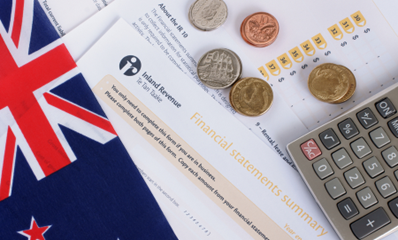
Each year, accountants review income generated by Trusts and beneficiaries to determine how best to treat the income – either a) allocate it to beneficiaries and pay tax at their personal rates, or b) retain it within the Trust and pay tax at the trustees tax rate.
In making this decision, accountants and trustees consider various factors including:
- actual distributions made during the last year
- payments expected in the year ahead
- tax credits available
- expenses or losses to be claimed, as well as
- the best treatment for tax purposes
To illustrate, here is a simplified example:
ABC Trust has an investment portfolio and two main beneficiaries, Mr and Mrs Smith. Gross taxable income generated during the year was as follows:
- ABC Trust $ 15,000.00
- Mr Smith $ 30,000.00
- Mrs Smith $ 55,000.00
At the end of the tax year, the trustees can choose how to allocate that income. Each option results in different levels of tax payable on that income, as illustrated below:
- Retain the income with the Trust = $15,000.00 x 33% = $5,000.00 tax
(This would rise to $5,850.00 under the new 39% trustee tax rate)
- Distribute the income to Mr Smith = $15,000.00 x 17.5% = $2,625.00 tax
- Distribute the income to Mrs Smith = $15,000.00 x 30% = $4,500.00 tax
In the above example, the most tax effective option would be to allocate and distribute income to Mr Smith as he has the lowest taxable income and marginal tax rate (17.5%).
Are there any exceptions?
While many Trusts will be impacted by the above rules, there are some situations where income may not be taxed at 39% despite being retained in the Trust. For example:
- Deceased estates and disabled beneficiary Trusts will be exempt from this new top tax rate
- Trusts which have tax losses or deductible expenses that can be offset against income
- Income earned within a PIE (or Portfolio Investment Entity) which has elected a 28% PIE tax rate, making such investments more attractive for Trusts
- Company earnings for shares owned by Trusts, where income is retained in the company and not paid out as a dividend
- Charitable Trusts, which do not pay tax on income generated
Is there still value in having a Trust?
The answer to this question is … it depends. Determining the value of having a Trust should always come back to it’s purpose and what benefit it provides to beneficiaries, both the original settlors and future generations; now and in the future. In our view, there are still valid asset protection reasons for Trusts, including:
- Succession and estate planning
- Providing financial support for specific people
- Creditor protection for self-employed or business owners
- Family asset protection
- Separating assets from matrimonial and relationship property
- Protection from any future estate or death duties
What should you do?
With the higher tax rate and increased scrutiny of Trust activity, trustees need to balance the administration costs and tax obligations with the overall purpose of the Trust and the benefits it provides for beneficiaries. Trusts are not for everyone, however, there are clear benefits available in the right circumstances. The increased trust tax rate is just another factor for trustees to consider when determining the appropriateness of the Trust.
The G3 team has extensive experience in working with Trusts and considering the tax implications of investing as a part of broader financial planning advice. Please get in touch if you would like to discuss your situation.
Disclaimer: The above information is of a general nature only. The information in this article does in no way constitute legal or taxation advice and all readers should contact a professional for advice relating to their specific circumstances.
SHARE THIS POST
Scam Watch

It seems there are more sophisticated investment scams that regulators both here and in Australia are aware of. Australians lost $3.1 billion in scams last year, an 80% increase on the 2021 total (Targeting Scams Report, Australian Competition and Consumer Commission, 17 April 2023). Here in New Zealand, regulators estimate one in five Kiwis have now been targeted by scammers (Real Life Scam Stories, Financial Markets Authority, 31 May 2023).
Check out these two links from the New Zealand Financial Markets Authority (FMA) to ensure you protect yourself and are aware of how scammers are targeting consumers Scam Basics and FMA warning of interest rate comparison site scam
Scam basics | Financial Markets Authority (fma.govt.nz)
Also check out, You’ve Been Scammed By Nigel Latta, a four-part televison series that looks at how criminals prey on human weaknesses – love, greed, fear and trust – to scam us out of our hard-earned cash. This begins on TVNZ 1 on Monday 3rd of July at 8pm.
SHARE THIS POST
What Is The Success Rate Of Actively Managed Funds?

As our clients know, we prefer to refer to evidence around how best to invest money, and there are many studies showing that this ‘evidenced based’ approach proves the best solution over the longer term, and trying to predict where to invest for the future is futile. This article is proof that this approach is still the best solution, and is why we do not subscribe to investing in funds that are classified as ‘active’

What is the Success Rate of Actively Managed Funds?
Over a 20-year period, 95% of large-cap actively managed funds have underperformed their benchmark.
The above graphic shows the performance of actively managed funds across a range of fund types, using data from S&P Global via Charlie Bilello.
Missing the Mark: Actively Managed Funds
Several factors present headwinds to actively managed funds.
- Trading costs: First, fund managers will trade more often than passive funds. These in turn incur costs, impacting returns.
- Cash holdings: Additionally, many of these funds hold a cash allocation of about 5% or more to capture market opportunities. Unlike active funds, their passive counterparts are often fully invested. Cash holdings can have the opposite effect than intended—dragging on overall returns.
- Fees: Active funds can charge up to 1-2% in investment manager fees while funds that tracked an index passively charged just 0.12% on average in 2022. These additional costs add up over time.
Below, we show how active funds increasingly underperform against their benchmark over each time period.

As we can see, 51% of all large-cap active mutual funds underperformed in a one-year period. That compares to 41% of small-cap value funds, which had the best chance of outperforming the benchmark annually. Also, an eye-opening 88% of real estate funds underperformed.
For context, Warren Buffett’s firm Berkshire Hathaway has beat the S&P 500 two-thirds of the time. Even the world’s top stock pickers have a hard time beating the market’s returns.
2020 Market Crash: A Case Study
How about active funds’ performance during a crisis?
While the case for actively managed funds is often stronger during a market downturn, a 2020 study shows how they continued to underperform the index.
Overall, 74% of over 3,600 active funds with $4.9 trillion in assets did worse than the S&P 500 during the 2020 market plunge.

In better news, roughly half underperformed through the recovery, the best out of any market condition that was studied.
The Bigger Impact
Of course, some actively managed funds outperform.
Still, choosing the top funds year after year can be challenging. Also note that active fund managers typically only run a portfolio for four and a half years on average before someone new takes over, making it difficult to stick with a star manager for very long.
As lower returns accumulate over time, the impact of investing in active mutual funds can be striking. If an investor had a $100,000 portfolio and paid 2% in costs every year for 25 years, they would lose about $170,000 to fees if it earned 6% annually.
Published on May 4, 2023
By
What is the Success Rate of Actively Managed Funds? (visualcapitalist.com)
SHARE THIS POST
Helping Loved Ones Through Rising Rates

Are you, your children or loved ones, concerned about their mortgage as a result of the sudden rise of interest rates? Perhaps you may be concerned that there is a need to help someone financially when their interest rates reset?
If you’ve had those thoughts you’re not alone. Some investors are thinking the same. The sudden movement of rates is having an impact on society. And perhaps the most significant impact is on new homeowners who purchased their first home or upsized their mortgage on a new home right after COVID when rates were at historically low levels.
In May of 2020, just as the full impact of COVID was being felt and many of us were in lockdown, the Reserve Bank of New Zealand dropped the Official Cash Rate (OCR) to 0.25%. There was talk at the time of deflation and negative interest rates such as Europe has experienced. As it happened, the OCR stayed low for well over a year until about October 2021 when it began to rise all the way to 4.75% where the rate sits at the start of April 2023.
While our saver clients will certainly be relieved, if not happy, that they can once again earn a reasonable level of interest on their cash, bonds, and term deposits; for borrowers it is a different story. In May 2020 you could secure a loan for as little as 2.25% or slightly more for longer terms. Now those loans are starting to roll off the books and are being reset at much higher rates.
ANZ is currently offering a rate of 6.54% for borrowers with 20% equity and an ANZ transaction account. Other borrowers are looking at 7.14% for one year[1].
The impact of higher mortgage interest rates is substantial. Imagine in May 2021 you secured a two-year rate at 2.50% on a new home borrowing $800,000 for 30 years. Your fortnightly payments would be $1,458. Once you borrow at 7%, your payment increases to $2,455[2] a fortnight. That extra $1,000 per fortnight is a huge expense for many borrowers.
So, what can be done?
The key here is planning. Below we offer some real suggestions that we’d encourage any of our clients or their loved ones to consider and the sooner the better.
- Contact a professional and get the facts. Not all mortgage brokers are of the same quality. If you’re not sure who to speak to, contact us and we’ll put you in touch with someone. With or without a professional, find out what you owe, what you’ll likely be reset to and get a sense for how much additional interest you’ll pay per month or per fortnight. Use online calculators like the one on sorted https://sorted.org.nz/tools/mortgage-calculator.
- Act now as if you’ll need to cover that expense. For example, if you’ll have another $1,000 to cover each fortnight and you get paid fortnightly, take $1,000 immediately out of your account and place it in a special savings account. Now act for next two weeks as though the money isn’t there. Doing this allows you to simulate what it will be like to live without that money. Can you do it? If not then you’ll need to pull out your budget, leading to our next point.
- Budget. You’ll need to get a handle on exactly what your discretionary expenses are. For many of us they are holidays, eating out, streaming, gym memberships, even (gasp) coffee. You don’t want to give up any of those, but doing so may be a better trade off to not being able to make your payments. Sorted has a good budgeting tool if you need a place to start https://sorted.org.nz/tool/budgeting-tool
It’s possible after simulating your extra mortgage payment, you can’t make ends meet no matter what you do. There are other options to explore.
4. Negotiate with your employer. Often salary gets reviewed and updated in April. This may be the right time to talk to
your employer about a raise to keep up with inflation or better. Don’t just come asking for money though. Do some
research. If you know there’s more money available at other employers then bring that into the conversation. Ensure
you’ve written down your accomplishments. Don’t expect your employer to know them off hand. Ensure they know
you believe in the company and its direction and that you’re a team player, be confident and put your request in
writing.
5. Negotiate with the bank. With your mortgage broker, you can explore many different options. The sooner you
speak with the bank, the more options you’ll find available to you. Other banks may offer more competitive rates,
consider moving. Banks may be willing to offer you to pay interest only for a year or at most two years. Or perhaps
you can extend the term of the loan back to 30 years.
6. Consider other ways to raise money. If you’ve just bought a house and you have a spare room, there are people willing to rent especially in university towns. This could mean several hundred dollars a month which would make all the difference.
The point is, once you notice a short coming you can plan to do something about it.
Of course, the best way to deal with an unexpected financial downside is with unexpected financial upside. For example:
- When you’re on the other end and you renegotiate rates lower, keep the same payment.
- When you get a raise, top up your mortgage payment by the same percentage as your raise.
- When you get an unexpected bonus, use a pre-planned percentage of it to pay down your mortgage.
Using the upside to pay off debt more quickly, you create a buffer for the downside. If borrowers had been using these rules for a few years, they’d be in a better position to absorb the increased rates, perhaps without even changing their payment.
The main takeaway from this article is simple, if you have reason to be concerned about the impact of rising interest rates on yours, or a loved one’s financial situation or even emotional health, please share this article and let them know that there is help available. As advisers we’re willing to speak with the loved ones of our clients and we have connections to help point them in the right direction. With planning we can help get our homeowners through this difficult period.
[1] https://www.anz.co.nz/personal/home-loans-mortgages/loan-types/fixed/
[2] https://sorted.org.nz/tools/mortgage-calculator
SHARE THIS POST
Retirement Ready

It wasn’t so long ago that ‘retirement’ meant a hard stop in people’s lives. They would quit work, pick up the gold watch and head for the bowling green. These days, people don’t ‘retire’ so much as redirect their energy to any number of activities, including paid work, creative pursuits, volunteering or looking after grandkids. Getting ready for this major life change obviously involves having a financial plan to ensure you have sufficient income to do the things you want to do. But it also means being prepared for the emotional adjustment that comes with the end to full-time paid employment.
Having a Plan
A financial plan is only part of the preparation for retirement. An often overlooked area is thinking about how you will use all that additional time. Australian financial website Firstlinks surveyed their readers on what advice they would give those thinking about retirement. There are some useful ideas here.
A Retirement Checklist
Your retirement plan can be simple or complex. It’s up to you. But some things it should include are the timing of the transition, lifestyle and priorities, income and living costs and future living arrangements. Whilst the following may comment on some Aussie centric benefits, most of the Australian Securities and Investment Commission (ASIC) MoneySmart checklist items, apply to us in NZ too.
The Emotional Adjustment
If you’ve depended overwhelmingly on your professional career for your sense of self-worth, retirement can be something of a wrench. This is why making positive plans for how you will spend your time is so important. As this article explains, learning new skills and making new friends can be part of the plan.
Source: Jim Parker – Dimensional
SHARE THIS POST
The Year That Wasn’t

Jim Parker
Vice President – Dimensional
As an eventful year in markets nears its close, analysts are being asked about their
expectations for 2023. The media uses these surveys to generate eye-catching headlines,
but rarely does anyone go back to look at what they forecast last year.
Speculative articles about the future can be an entertaining diversion. But however
educated the guesses in these articles may be, these are still guesses and subject to
random and unpredictable events. Recent history has proved that repeatedly.
In January 2020, none of the dozens of forecasters interviewed by newswire Bloomberg
had a global pandemic on their bingo card of what might move markets that year. (1) In the
equivalent survey in January 2022, virtually no-one cited a land war in Europe. (2)
Back in late 2021, the enthusiasm for cryptocurrencies was a big story. Market leader
Bitcoin had reached record highs above $US68,000. One investment bank predicted it
was headed for $150,000 as it competed with gold as an alternative currency. (3)
The fortunes apparently on offer in cryptocurrencies were no more evident than in
coverage of up-and-coming crypto exchange owner Sam Bankman-Fried, hailed by one
publication in late 2021 as “the world’s youngest mega-billionaire”, at just 29. (4)
Less than a year later, however, Bankman-Fried’s $32 billion empire had collapsed with
his own substantial personal wealth almost entirely wiped out. (5) Bitcoin was down near
$20,000 and regulators were calling for greater scrutiny of the sector. (6)
Economic and interest rate forecasting is a tough business as well, and one that does not
appear to be getting any easier, judging by last year’s predictions.
Each year, the academic website ‘The Conversation’ asks a panel of esteemed Australian
economists for their individual forecasters for key economic and market variables for the
year ahead. (7)
The big debate this time a year ago was what would happen to official cash rates in 2022,
with inflation rising around the world.
Even so, two thirds of the 24-member forecasting panel expected the Reserve Bank of
Australia to leave cash rates at historically low levels, near zero, at least until the first quarter of 2023. Some did not expect any move until 2024, as the RBA itself had said.
Of course, we now know that inflation kept rising, confounding the expectation of central
banks that it would be transitory. As a result, the RBA began raising cash rates in May
2022 and did so another handful of times over the year, while warning of more to come.
As forecasting errors go, this was remarkable.
But it didn’t stop there. Perhaps reflecting their bad call on cash rates, the economists’
panel was convinced that underlying inflation, the measure targeted by the Reserve
Bank, would stop short of the top of its 2-3% target band in 2022.
As it turned out, however, inflation kept on rising and by the September quarter was
above 6% in underlying terms, twice as high as the economists’ year-end target. (8)
On currencies, the forecasters saw the Australian dollar staying roughly where it was back
in late 2021 in the low 70s against the US dollar. Wrong again, unfortunately. The AUD
kept falling through 2022, as the USD rose, hitting lows near 62c in mid-October.
On bonds, the panel was fairly sanguine, expecting Australian government 10-year bond
yields to edge up slightly over the year to 2.5% from 1.7%. Another miss here, too, as
yields kept rising through the year to reach around 4.2% by mid-October.
On the share market, macro economists tend to avoid making forecasts and about a third
of the panel declined to make a prediction. But of those who did there was a significant
dispersion in individual calls for the S&P/ASX 200 index, ranging from a gain of 10% to a
loss of 45%! The local market was down about 3% as of late-November.
On the economy generally, the economic forecasters were too pessimistic. Few of the
panellists expected Australia’s unemployment rate to fall much below its then historic
lows of 4.2%. But by mid-2022, the jobless rate had plunged to around 3.5%. (9)
None of this is intended to disparage the skills or professional standing of these
economists. Many are highly respected in the field. But they would be the first to admit
there is little science in forecasting financial markets or economies.
One can make assumptions about the future. But as we have seen many times over the
years, unexpected things can happen – wars, pandemics, inflation, recessions – that mess
up even the most carefully considered projections.
For the ordinary investor, the lessons here are familiar. The future is inherently uncertain.
Not even the experts are particularly good at predicting it. This means that basing your
investment strategy on somebody’s opinion, hunch or wish about what might happen
next year or the year after is not a sustainable or reliable approach.
The good news is you don’t need the powers of prediction to have a good investment
experience. You just need a financial plan that’s made for you and your goals, one that is
highly diversified and that makes allowances for periods like we have seen in 2022.
We know that over the long term, the share market has delivered a reasonable rate of
return, but it is not the same every year. Some years are much worse, some years are
much better. So to get that average you need to stick with it.
Humanity faces some challenges, it is true. But the flipside of challenge is opportunity
and the chance to create innovative solutions to the problems we face. Being a longterm
investor gives you the chance to share in the wealth created by innovation.
And you can do all of that without making a forecast.
- ‘Here’s (Almost) Everything Wall Street Expects in 2020’, Bloomberg, 2 Jan 2020.
- ‘Here’s (Almost) Everything Wall Street Expects in 2022’, Bloomberg, 3 Jan 2022.
- ‘Bitcoin Surges to Record High of More than $68,000’, The Guardian, 9 Nov 2021.
- ‘Inside the Hectic Life of Sam Bankman-Fried’, Business Insider, 17 Dec 2021.
- ‘FTX Collapse Being Scrutinized by Bahamas Authorities’, Reuters, 13 Nov 2022.
- ‘FTX Collapse Exposed Weaknesses in Crypto: Janet Yellen’, Yahoo Finance, 14 Nov 2022.
- ‘Top Economists Expect RBA to Hold Rates Low in 2022’, The Conversation, 30 Jan 2022.
- Consumer Price Index, Australian Bureau of Statistics, 26 Oct 2022.
- Labour Force Survey, Australian Bureau of Statistics, 20 Oct 2022.
The information in this material is intended for the recipient’s background information and use only. It is provided in good faith and without any warranty or representation as to accuracy or completeness. Information and opinions presented in this material have been obtained or derived from sources believed by Dimensional to be reliable, and Dimensional has reasonable grounds to believe that all factual information herein is true as at the date of this material. It does not constitute investment advice, a recommendation, or an offer of any services or products for sale and is not intended to provide a sufficient basis on which to make an investment decision. Before acting on any information in this document, you should consider whether it is appropriate for your particular circumstances and, if appropriate, seek professional advice. It is the responsibility of any persons wishing to make a purchase to inform themselves of and observe all applicable laws and regulations. Unauthorized reproduction or transmission of this material is strictly prohibited. Dimensional accepts no responsibility for loss arising from the use of the information contained herein. This material is not directed at any person in any jurisdiction where the availability of this material is prohibited or would subject Dimensional or its products or services to any registration, licensing, or other such legal requirements within the jurisdiction.“Dimensional” refers to the Dimensional separate but affiliated entities generally, rather than to one particular entity. These entities are Dimensional Fund Advisors LP, Dimensional Fund Advisors Ltd., Dimensional Ireland Limited, DFA Australia Limited, Dimensional Fund Advisors Canada ULC, Dimensional Fund Advisors Pte. Ltd., Dimensional Japan Ltd. and Dimensional Hong Kong Limited. Dimensional Hong Kong Limited is licensed by the Securities and Futures Commission to conduct Type 1 (dealing in securities) regulated activities only and does not provide asset management services.Risks
Investments involve risks. The investment return and principal value of an investment
may fluctuate so that an investor’s shares, when redeemed, may be worth more or less than their original value. Past performance is not a guarantee of future results. There is no guarantee strategies will be successful.
This material is issued by DFA Australia Limited (incorporated in Australia, AFS License No. 238093, ABN 46 065 937 671). This material is provided for information only. This material does not give any recommendation or opinion to acquire any financial product or any financial advice product, and is not financial advice to you or any other person. No account has been taken of the objectives, financial situation or needs of any particular person. Accordingly, investors should, before acting on the advice, consider the appropriateness of the advice, having regard to the investor’s objectives, financial situation and needs. Investors should also consider the Product Disclosure Statement (PDS) and for the Dimensional Wholesale Trusts the target market determination (TMD) that has been made for each financial product or financial advice product either issued or distributed by DFA Australia Limited prior to acquiring or continuing to hold any investment. Go to dimensional.com/funds to access a copy of the PDS or the relevant TMD. Any opinions expressed in this material reflect our judgement at the date of publication and are subject to change.
SHARE THIS POST
It Will Never Happen To Me

According to recent articles, 3,400 people or more are injured on Christmas day – costing over $3million!!
New bikes, trampolines and other ‘toy’ incidents can be blamed for many of the incidents. Then there are the accidents involving one to many sherries on Christmas Day!! And of course, the obligatory slip of the knife events when carving the turkey. Dropping a turkey or ham on your foot is also something more than one of us does each year, apparently!
Politics aside, as we know our health system is under severe stress, we are fortunate in this country to have the safety net of ACC and being able to turn up to Accident & Emergency and be treated.
Beyond accidents though, there are many situations where personal insurances play an important role in ensuring that we can survive financially if we are unable to work through illness, to protect our family’s financial security if we die, or to get private treatment if needed and then to avoid having to set up a GoFundMe or Give A Little page to give us access to an unfunded drug.
Unfortunately, it could happen to you, so keeping on track of the level of personal insurance cover you need is important – we are here to help you manage the level and types of cover you need, affordably.
This Christmas though, stay safe – and don’t try any technical moves on the new trampoline!
Food, fun, and festive fumbles (acc.co.nz)
Christmas injury claims cost more than $1m over last decade (1news.co.nz)
SHARE THIS POST
Do You Know What Is Important To You And Why

A few times recently we’ve had the privilege to be part of a conversation with clients and friends over a coffee or glass of wine, about what is important to us in life and why.
This has brought up some very interesting topics and as you can imagine, this can go pretty deep!
Importantly though, this is about challenging ourselves to consider these deeper parts of ourselves, taking time to think about who we are, what we want in life, what our values are, what we would like our legacy to be etc.
As we are coming into summer and can hopefully give ourselves time to recharge our batteries before 2023 starts in earnest, we would like to share with you the Wheel of Life. You may have heard of this before, or even done this exercise several times throughout your life as we have. There are several variations of this if you google it, although we liked this one because of the many areas of life it covers, so this image below may be a good start for you.
If you score yourself in each segment, from 1 being low and 10 being high, then join the dots, it helps focus our minds on any ‘gaps’ in our lives. These ‘gaps’ and low scores may be fine and sit well with us, however, if not, and you wish to work on increasing your score in that area, you can do something about this if you want to.
As the new year approaches, instead of making new year resolutions many of us never keep for long, maybe use this Wheel of Life to start yourself on a journey to fill in those ‘gaps’ you want to work on, and do not be afraid of seeking support from friends, family and others where needed.
This can be confronting we know, however, if we change our internal dialogue from negative and fearful thoughts, to saying ‘hey, I’m really going to work on this so let’s go!”, maybe you will find out something amazing about yourself you never knew. And remember, as you do this, think deeply about your ‘why’ a certain area is important to you, as this helps us come to understand our core values in life, if you don’t already know them of course!
If you score yourself high in each area, then congrats, you’re in a great space right now!!

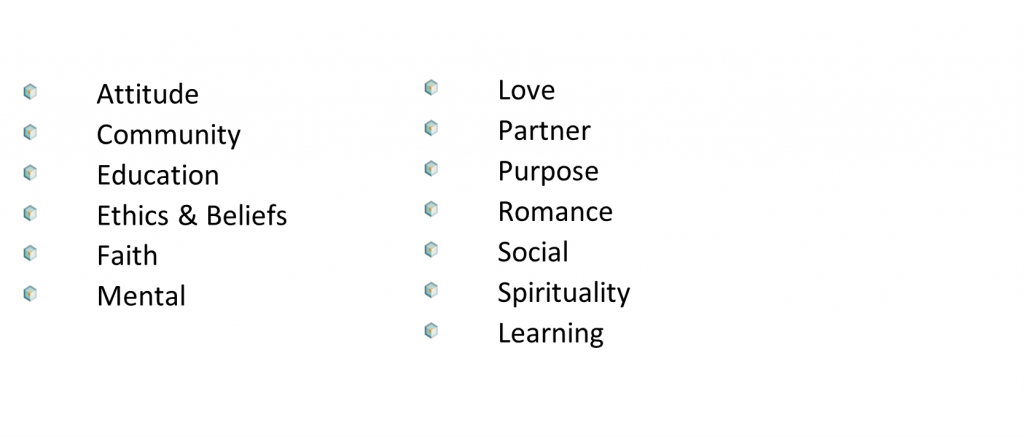
SHARE THIS POST
Five Ways To Combat Financial Stress During Uncertain Times

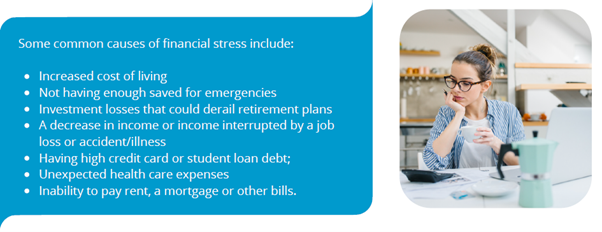
Here are five steps you can take to reduce financial
stress and get your financial health, wealth and
wellbeing back on track.
1. Take stock of your situation. One way to help
reduce financial stress is to fully understand how
much money you have, how much is coming in each
month, and what bills are due. To get a full view of
the month, try mapping it all out on a monthly
calendar. Mark the date or dates that you expect to
receive income, as well as the due dates for your rent
or mortgage, utilities, credit cards, tax payments or
other fixed expenses. This will help you understand
your cash flow. 
If most of your bills are due within a one-week period or concentrated during a particular time of the month, it may make sense to contact your creditors to see if you can change some of your due dates or get an extension and preserve your cash flow.
2. Track your spending. If money is tight, try tracking your spending for a month or two to see how you’re
spending it. Write down each purchase and each bill paid in a notebook or spreadsheet. After your tracking period is complete, go through the list and see which expenses can be cut and which are essential. From there, try developing a monthly budget and sticking to it
3. Don’t try to make financial decisions all at once.
It’s easy to get overwhelmed when faced
with mounting bills and not enough income
to cover them. Instead of looking at your
financial problems in the aggregate, try
tackling them one at a time and spreading
out your decisions.
4. Remember your goals. Just because money
seems tight right now, doesn’t mean your financial
and life goals are any less important. Besides saving,
what are some other ways you can stay
on track and make progress? Some people
find that doing freelance work, selling
unwanted possessions or relocating to a
less expensive home can help generate extra
cash for the future.
5. Seek the guidance of a financial advice
professional. Financial advice professionals
work with you to understand your goals and aspirations. They provide recommendations and advice relevant for your situation and ensure that you have the knowledge you need to help you make decisions at critical points in your life. Accessing quality financial advice will help you be better prepared for the future,
more comfortable with your financial position and confident in your financial decision-making. To find a
financial adviser in your area visit area visit
www.financialadvice.nz
SHARE THIS POST
Better Financial Behaviours By Those Who Receive Professional Financial Advice
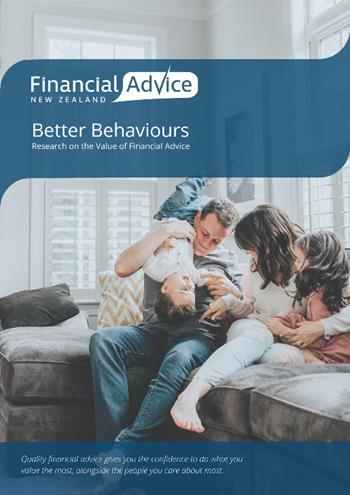
Kiwis who seek out and receive professional financial advice, exhibit good financial behaviours more often than unadvised Kiwis. According to Financial Advice New Zealand report 2021, advised Kiwis are more prepared for retirement, feel better about their finances and are more comfortable making big financial decisions.
Building on the research report from 2020, Trust in Advice, which clearly showed that financial advice and advisers are trusted and highly valued, the Better Behaviours report measures the extent of positive financial behaviours demonstrated by advised Kiwis compared to those who are unadvised.
The independent and comprehensive survey of 2,000 people repeated many questions from the 2020 survey to determine the 2021 Financial Advice NZ Wellbeing Index* and to compare it to the 2020 results. In addition to these questions, we asked Kiwis about their financial plans, what financial products they had, when they last reviewed aspects of each product, and if they made changes. It also asked if they thought those changes would make a long-term difference to their financial wellbeing.
The results are clear – advised Kiwis exhibit better financial behaviours:
– More than two thirds of advised New Zealanders say that advice has led to outcomes such as a better understanding of the risks of their financial plan (77%), a better understanding of how to achieve financial goals (74%), and they are better equipped to actually stick to these financial plans (70%).
– The vast majority of advised consumers say that their advice relationship is meeting their needs. When asked whether the service provided by their adviser met their needs, a strong majority (91%) said yes to at least some extent.
– More than two thirds of advised New Zealanders (67%) say that their financial security has improved at least slightly as a direct result of receiving financial advice. Further to this, sizeable proportions also say that advice has had a positive impact on their mental health (46%), family life (40%), and even on their physical health (25%).
The Better Behaviours results clearly illustrate that advised Kiwis are more likely to have a documented budget and financial plan, to review their financial products regularly, to understand risk vs return, and to take-up and cancel insurance products when appropriate. They are also more likely to have positive mortgage behaviours, setting themselves up to save interest and carve years off the life of their mortgages.
Across the board (mortgage advice, investment advice, insurance advice and financial planning), quality financial advice has given Kiwis the tools to think about their finances in a pro-active way, given them more financial confidence and control, and has had a significant effect on their sense of financial wellbeing.
Download the full report here , however, for a snapshot of the results:






Source: https://financialadvice.nz/better-behaviours-2/
SHARE THIS POST
20 Ways To Jump Start Your Financial Future

World Financial Planning Day is a global event to help raise awareness of the value of financial planning which takes place on 5 October. It’s the perfect opportunity for you to take positive steps to toward controlling your financial health, wealth, and wellbeing – now and in the future.
How can you improve your financial well-being on World Financial Planning Day? Following is a
comprehensive list that includes some starting points, as well as some more complex strategies for
those who want to make this year the start of a longterm commitment to financial success.
1. Improve your financial literacy. Don’t know
much about managing your money? Financial Advice
New Zealand and Sorted have some great articles,
tools and resources to help get your started.
2. Start a money journal. Explore your attitude
towards money, your hopes and fears and your
dreams for financial success. Doing so can help you
crystallise your long-term goals so you can make a
plan for the future.
3. Write down your long-term life and financial
goals. Include them in your journal, along with a
timeline for achieving them.
4. Reconcile your bank accounts. Check your bank
account debits against the payments you’ve made,
and make sure any pending bills are either paid or
scheduled.
5. Compare interest rates for savings accounts.
This is a perfect place to start building or expanding
your emergency fund. While you’re at it, commit to
saving a specific dollar amount or percentage of your
income each month.
6. Make an extra credit card payment. If you carry
a balance on your credit cards, use World Financial
Planning Day to start paying down the card with the
highest interest charge.
7. Determine your net worth. List your assets (what
you own), estimate what each is worth and add up
the total. Next, list your liabilities (what you owe), and
add up the outstanding balances. Subtract your
liabilities from your assets to determine your net
worth.
8. Estimate how much money you need to retire.
Wondering how much money you need to live
comfortably in retirement? Use a free online
retirement calculator to figure out a rough estimate.
One to try: sorted.org.nz/tools/retirement-calculator/.
Can you afford to bump up your contributions to
your KiwiSaver? Are you in the right fund? Seek
advice from a financial advice professional to get the
most from your KiwiSaver.
9. Organise your important household and
financial accounts. Would your loved ones know
how to run your household or understand your last
wishes if you became sick or injured, or died
suddenly? Use World Financial Planning Day to start
organising your important documents and accounts,
store them securely and share their location with a
family member, financial advice professional and/or
attorney.
10. Create a budget and track your spending. To
get a handle on where your money is going, try
creating a budget and tracking your spending.
11. Automate your savings. One of the least painful
ways to save is to automate the amounts you want to
set aside each month so you won’t be tempted to
spend them.
12. Put your money to work by investing
Term deposits, shares, property, KiwiSaver, managed
funds – sound intimidating? It’s really not. An
investment adviser can help you to determine your
investment goals and find the right balance (between
risk and return). Also, you don’t need to have a lot of
money to invest. Investing is for everybody!
13. Get insurance advice. Get the right insurance in
place to protect what you value most – your lifestyle,
your family your income, your business, your
mortgage, and/or your retirement – in the event the
unexpected happens. An insurance adviser can help
you choose the best protection plan for your needs.
14. Look for ways to lower your monthly bills. As
contracts for things like your mobile phone, cable
service or home security system expire, do some
comparison shopping to see if you can reduce your
monthly spend. You may even be able to negotiate a
lower rate with your current provider.
15. Make some extra money by selling unwanted
items. Looking for a way to reduce clutter and make
some quick cash? Explore the many online tools for
selling your unwanted items. Before doing so, be
sure to review secure ways to handle payment and
delivery, and research common scams.
16. Create a personal document retention policy.
Learn how long you should keep important
paperwork, such as contracts, loan documents, tax
returns or account statements. Create a system to
purge documents you no longer need, and scan and
save the ones you need to keep.
17. Talk money with your child. Does your child
understand the concept of saving money? Use World
Financial Planning Day to help your child open a
savings account and understand the basics of paying
bills and building credit.
18. Start an education/tertiary savings fund for
your child. If you are considering private education
for your child/children and want to help fund their
tertiary education, start a separate savings account
as early as possible, so when the time comes you
have a nice financial buffer to achieve this goal.
19. Create or update your will. If you have a will
already, use World Financial Planning Day to review
and update it as needed. If you need a will, use the
day to schedule an appointment with an attorney or
appropriate estate planning professional to create
one.
20. Make an appointment with a financial advice
professional. Those who get professional financial
advice are more likely to feel happy with their
financial position and better prepared for the future
than those who don’t. They feel more confident in
their financial decision making, in control, and clearer
about their finances. Visit financialadvice.nz to find a
financial advice professional in your area.
Source: Financial Advice New Zealand –
SHARE THIS POST
Meeting With Your Financial Advice Professional For The First Time?

Congratulations! You’ve decided to take control of your financial life. You’ve researched your options, asked a lot of questions, and found the right financial advice professional to help you plan for your financial future. As you prepare for your first meeting as a client, it’s likely you have even more questions, and if so, you’re not alone. Many clients of financial advice professionals aren’t sure what to expect, how much to divulge, or even what documents to bring to their first official meeting.
While every financial adviser and adviser practice is
different, most follow a common general framework
based on the six-step financial planning process. The
first step often involves something called a ‘discovery’
meeting, in which you and your financial adviser will
form a basis for your relationship. It’s an opportunity
to build trust, understand problems and priorities,
and establish a roadmap for progress toward your
financial and life goals.
Financial advisers and their business often have an
established process that includes providing a
checklist of required documents and information
they need to get an accurate picture of a your financial situation. While it may seem a bit
overwhelming to share your most important financial details with someone you don’t know well, it’s really no different than consulting with a physician on your health. When you engage a financial advice professional, you are working with someone who is placing your interests first.
THE BIG PICTURE
When your financial adviser conducts a discovery meeting, they will probably ask questions not only about your financial situation, but also about your personal interests, family and lifestyle. Often, a person’s interests, family or lifestyle can influence their financial goals and decision-making, so having a good understanding of your background may help the financial adviser understand your willingness to take on risk, or the triggers that will make you excited or spark your concern. The goal is to help you create a plan that will serve you well in good times or bad, so you always feel confident about reaching your goals.
Thorough financial advisers have a process to securely gather their clients’ information, analyse it, and integrate their findings into a set of recommendations. After receiving and discussing the recommendations from your financial adviser, you will discuss how the recommendations can be implemented, and the role each will play in carrying
out the plan. The more honest and direct you are at the beginning of the relationship, the better your financial adviser can help you create a sound, actionable plan to help
you reach your goals. Although you might be hesitant to discuss embarrassing financial mistakes you have made in the past, it’s important for you to share those so your financial adviser can address any consequences of those decisions.
PREPARE FOR YOUR FIRST MEETING
Before attending your first meeting with a financial adviser, take an hour or two to prepare yourself with answers to these potential questions:
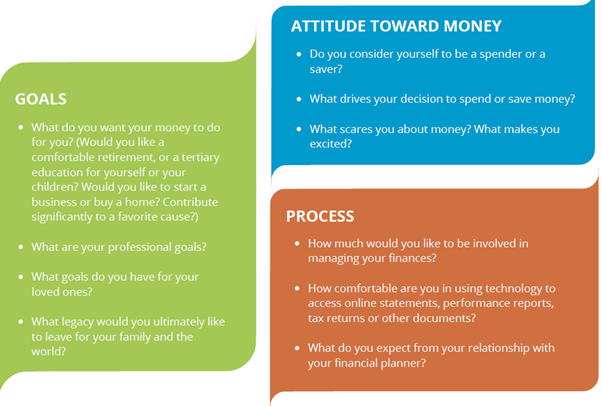
GET ORGANISED
Your financial adviser may also ask you to bring certain documents to your first meeting. Those
could include:
- Bank statements from the past year
- Other financial statements, such as loan documents
- Insurance policies
- Tax returns
- Pension or retirement savings account information
- Estate planning documents, such as a will or a trust
- Brokerage statements
A RELATIONSHIP FOR LIFE
Although it may seem like a significant time investment or an emotionally taxing experience, being well prepared for your first meeting sets the tone for a successful, trusting, long-term relationship with your financial adviser. The more your adviser knows about your history, your family, your interests and your financial situation, the better they can help you achieve the financial well-being you and your loved ones deserve.
Some financial advice practices provide a checklist with secure links to enable clients to upload their information prior to the meeting, but you may also bring the actual documents with you, depending on your comfort level. Whichever option you choose, be sure to label your documents and clarify any information that could be confusing.
SHARE THIS POST
Some good news for once!!

With all that is happening around the world, where media often focusses on the doom and gloom, it’s a refreshing change to hear the good news and to know there are some amazing advances going on in the world for the greater good!! Have a read of the latest round-up & check out the videos – some very inspiring stuff!
Source: Future Crunch https://futurecrun.ch/
Give a damn
We recently heard about a 90,000 person refugee camp in the Sahara, on the western border of Algeria, where residents are using machines to turn plastic waste into furniture and other useful products. The project is being run by Precious Plastic, an NGO who helped set it up after the UNHCR put out a call for solutions to help with waste challenges. They’re now recycling about 180kg of trash a day.
We gave them a call to see if we could help, and they said they really need a third machine that specializes in turning plastic trash into smaller products like buttons and jewellery, which residents can then sell. We’re sending them £3,376 to buy the machine, which is manufactured in the UK, and to pay for the shipping to Algeria, where it should arrive in the next month or two. Thanks to all our paying subscribers for making this possible!
Good news you probably didn’t hear about
Togo has become the third country in Africa to eliminate trachoma, the world’s leading cause of preventable blindness. Significant progress has been made across the continent, with infection rates falling from 189 million in 2014 to 116 million in 2021. WHO
The Central African Republic has officially abolished the death penalty, and Malaysia has banned it too, handing judges discretion to use a range of substitute sentences for serious crimes. 170 countries have now abolished or restricted the use of capital punishment.
Between 2013 and 2020 China’s air pollution dropped by 40%, which means the country reduced the same amount of pollution in seven years as America did in three decades. Since air pollution is the largest killer of people worldwide, this achievement equates to millions of lives saved. Bloomberg
The UN says every person on earth will be covered by early warning systems for extreme weather events within the next five years. Issuing a warning 24 hours before a storm or heatwave has been shown to reduce damage and loss of life by an average of up to 30%. EuroNews
A landmark ruling in Mexico has banned random immigration checks that target Indigenous or Afro-Mexicans who are often detained, harassed, or wrongfully deported. It’s an important victory for human rights groups who have spent years in court fighting for the change. HRW
Spain’s parliament has approved a bill that will make consent a determining factor in rape cases. The proposed legislation known as ‘only yes means yes,’ will free survivors of sexual assault from having to prove violence. The law includes measures such as creating a network of 24-hour crisis centres for survivors of sexual assault and their families. Guardian
From today, Spain is a freer, safer country for all women. We are going to swap violence for freedom, we are going to swap fear for desire.
Irene Montero, Spanish Minister for Equality

America’s inequality problem has improved for the first time in a generation. The poorest half of Americans now hold a bigger share of the nation’s wealth than they have at any point in the last 20 years. Some welcome news for 6.2 million workers in Germany too, who will receive up to €400 extra per month thanks to a national increase in the minimum wage.
Over the past decade Houston, the fourth largest city in the US, has reduced its homeless rate by 63% thanks to a radical ‘housing first’ approach that moves people into permanent accommodation rather than shelters. The city now has a $100 million plan in the works to cut homelessness by a further 50% by 2025. NYT
Thailand has become the first Asian country to legalise medicinal marijuana and allow people to grow the plant at home. While recreational use of the drug remains illegal, the government hopes the new law will boost the wellness and tourism industries. ABC
In the wake of the Uvalde shooting in Texas, Canada has implemented a national freeze on the sale and purchase of handguns. The new legislation is part of a gun control package that will also limit magazine capacities. While Canada’s gun homicide rate is less than a fifth of the US, it is higher than other wealthy countries. Reuters
For the first time in 60 years, China’s population is about to decrease. Over the past four decades the population swelled from 660 million to 1.4 billion, but in 2021 it increased by a record-low of 480,000, and is now on course to shrink in 2022. BBC
The number of young people being prosecuted in adult courts in the US has dropped from 8% in 2010 to 1% in 2020, giving tens of thousands of teens a second chance to turn their lives around. The ‘raise the age’ movement has contributed to the shift which deals with offenders under 18 years old through the juvenile justice system and community-based programs. AP
Regardless of what young offenders are charged with, what works is community-based intervention and letting communities lead reform efforts.
Naomi Smoot Evans, Executive Director of the Coalition for Juvenile Justice in Washington
Did you know that same sex marriage just took a big step closer to being legalized in both Thailand and Czech Republic?
Activists and MPs celebrate after Thai lawmakers gave initial approval to legalising same-sex unions.
The only home we’ve ever known
A community-led effort to protect turtles in Mohéli, one of the islands of the Indian Ocean nation of Comoros, has inspired the expansion of Comoros’s protected areas from one to six, including three new marine protected areas (MPAs). The country’s first MPA was created in 2001 and is now one of the largest nesting sites for green sea turtles in the Indian Ocean. Mongabay
Oil drilling in the Arctic’s National Wildlife Refuge is officially bad for business with three major oil companies cancelling leases and five of America’s big banks refusing to fund projects there. The 20 million-acre reserve provides critical habitat for the Southern Beaufort Sea’s remaining polar bears. WaPo
The ocean off Gaza is ‘crystal blue’ for the first time in years, after sewage treating facilities stepped up operations to stop untreated sewage flowing directly into the water. It’s good news for the 2.3 million Palestinians who can finally enjoy a swim this summer. Euro News
The Pacific Island state of Niue is creating a marine park to protect 100% of its ocean, an area the size of Vietnam spanning 317,500 km2. The island’s waters are a birthing ground for humpback whales and boast the world’s highest population of grey reef sharks and the katuali sea snake. Niue follows the lead of the Cook Islands which has also committed to 100% protection. Guardian
The ocean is everything to us. It’s what defines us. We have to ensure our reefs and corals remain to provide a healthy ecosystem and continue to create a food source for our people.
Dalton Tagelagi, Premier of Niue

The global war on waste is ramping up. India is about to kick off the largest plastic ban in the world, America just announced it will phase out single-use plastic in national parks by 2032, saving 14 million tonnes of plastic from ending up in the ocean, and in Australia, efforts to minimise plastic over the past six years have reduced coastal litter by 29%.
Living Lands and Waters, a 23-year old environmental non-profit in the United States, collected over half a million pounds of trash across seven rivers throughout the USA last year. 63% of that waste came out of the Ohio River, a main source of drinking water for more than five million Americans. Ground Truth Project
Big environmental win in California with the end of state-run pesticide programs on public, agricultural, wild lands, and private properties. The government has also announced a $40 million award to support regional initiatives that repurpose agricultural land in an effort to reduce water demand.
Five major nature recovery projects are underway in the UK to restore a whooping 99,000 hectares of land across the West Midlands, Cambridgeshire, the Peak District, Norfolk, and Somerset. The projects aim to tackle wildlife loss, climate change and improve people’s access to nature, especially in city areas. Guardian
Queensland will invest over $24 million into protecting koala populations and habitats.The koala is an endangered species in Queensland, New South Wales, and the Australian Capital Territory, mainly due to habitat loss. Guardian
A 25-year study of the monarch butterfly in North America, the largest and most comprehensive assessment of the breeding population to date, has overturned everyone’s worst fears and revealed that the species is actually doing alright, after an average annual increase of 1.36% per year. Global Change Biology
The endangered Bali mynah bird is making a comeback thanks to a surprising partnership between conservationists and local bird sellers. For the past decade approved breeders have been given licenses to breed and sell 90% of mynah offspring if the remaining birds are released at West Bali National Park. AP
A victory for wolverines in Montana, with a court reinstating additional protections for the species under the Endangered Species Act. Like other snow-dependent species, wolverines are facing habitat losses due global warming and the protections will help focus resources to save them. Biological Diversity
Today’s decision gives us hope that wolverines could once again roam Colorado’s high country, where high elevation, snowy habitat could help these elusive and fascinating animals survive in the face of climate change.
Megan Mueller, Conservation Biologist, Rocky Mountain Wild
A landmark ban on ivory in the UK has gone into effect. The Ivory Act is one of the toughest in the world, with offenders facing an unlimited fine or up to five years jail. It’s hoped the ban will help end the global ivory trade, which slaughters an estimated 20,000 elephants each year. UK Gov
New York has passed a bill that bans pet stores from selling animals supplied by abusive breeders or ‘puppy mills.’ Under the new law, pet shops are required to collaborate with animal shelters and encourage people to adopt rather than buy pets. California passed a similar law in 2017. NY Post
Brazil’s iconic golden lion tamarin, found only in the Atlantic Forest, has been saved from extinction with the population rebounding from 200 in 1977 to over 2,000 today. Local conservationists have worked tirelessly for 50 years to protect natural habitat and bolster the population through breeding programs. Work is now underway to protect the other three species — the black lion tamarin, golden-headed lion tamarin, and black-faced lion tamarin. Mongabay
.

Saving the world is cheaper than ruining it
Vladimir Putin has arguably done more to accelerate the clean energy transition than anyone in history. 19 European governments have now accelerated their decarbonisation plans, and under the latest national commitments, EU countries are aiming for 63% of renewables in electricity generation by 2030, up from 55% under previous commitments. Ember
The Greek government has adopted the country’s first national climate protection law, requiring all coal fired generation be closed by 2028, and renewables to account for up to 70% of electricity generation by 2030. This is insanely ambitious. The current share is around 40%. Renewables Now
Amidst the sound and fury surrounding the global conversation on energy, most journalists are still missing the most important point: solar, wind and batteries are on learning curves, and coal, oil, gas and nuclear aren’t. A new analysis of wind and solar farms in the United States for example, has shown that each time the total amount of wind installed doubles, the cost comes down by 15%, and for solar, by 24%.
Incredible things are quickly normalized by this kind of exponential growth. This battery storage site in Texas would have been by far the world’s largest five years ago. Today it’s just another project. It’s why almost nobody in America is building fossil fuel power plants any more…
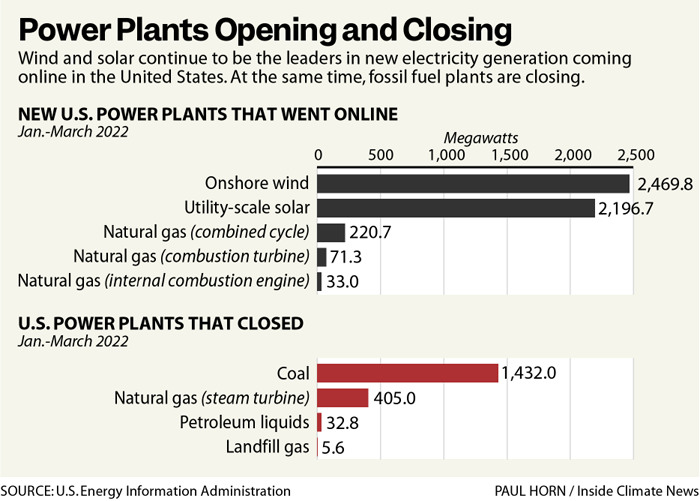
…and why nobody in the world wants to insure them either.
It’s why it’s no longer newsworthy that an industrialised nation just produced 100% of its electricity from wind for two days in a row. Or that another one has set the most ambitious climate goal in the world, aiming to reach net zero by 2035, and net negative – absorbing more CO2 than it emits – by 2040.
Samsung, South Korea’s largest conglomerate, is requiring all its financial subsidiaries to stop investing in coal companies, and Sompo, one of Japan’s biggest insurers, says it will stop underwriting new and existing coal around the world. Two really big market signals from where it matters most, southeast Asia.
Next Era, the largest power company in the United States, just announced a plan to achieve ‘real-zero’ by 2045, by building huge amounts of solar and hydrogen. No other utility to date has committed to near-total decarbonization without the use of offsets or carbon capture technology. WSJ
While everyone’s attention has been on the US federal government’s inability to pass climate legislation, states and governors have quietly notched up an astonishing list of energy and environment wins across the country. A powerful antidote to despair. LCV
China’s biggest dam builder says the nation will start construction on more than 200 pumped hydro stations with a combined capacity of 270GW by 2025. That’s more than the capacity of all the power plants in Japan, and will be enough to meet about 23% of China’s peak demand. Straits Times
Carbon Brief has a new report showing China’s carbon emissions fell by 1.4% in the first three months of 2022, making it the third quarter in a row of falling emissions. That’s the longest emissions decline in China for a decade. Previous declines have been followed by rapid rebounds, but this time could be different…

… because China is now building the equivalent of one coal plant of wind and solar every week. The country is on track to install 108GW of solar alone this year, almost double the 54 GW installed in 2021. Combined with 50GW of wind, that would generate the same amount of electricity as 52 coal plants. Bloomberg
Austria just passed legislation requiring all new or replacement heating systems to be renewable from next year. By 2035, all oil and coal heating systems must be replaced by renewable ones, and by 2040 all gas heating systems must also be replaced. People with low incomes will receive 100% of the costs. Kleine Zeitung
Vietnam, a country of almost 100 million people, is undergoing one of the biggest and fastest energy transitions in the world. In the four years to 2021, the share of solar increased from zero to nearly 11%, making it the world’s 10th largest solar power producer. Petrotimes
And the next time someone complains about the coming wave of toxic materials from solar panels, or says “what about recycling?” send them this.
Volvo has become the world’s first manufacturer to deliver a construction machine built using fossil-free steel to a customer. This articulated hauler was handed over on the 1st June 2022 – just nine months after the company unveiled the world’s first vehicle concept using fossil-free steel. Aggnet
Lawmakers in the European Parliament have voted to ban internal combustion engines in all new cars and vans by 2035. The legislation requires carmakers to reduce their fleetwide emission averages by 100% from 2035, with interim steps in 2025 and 2030. Politico
Buick, the iconic American automaker, says it will only sell electric vehicles by the end of this decade. And Chevy just slashed the starting price of its Bolt EV by 27% to $26,595, making it the cheapest electric vehicle in North America.
2023 Chevy Bolt EV: range: 414km | 0-100km/h in 6.5 seconds | 200hp | charging time: 160km in 30 minutes. Same price as a Honda Accord.
Source: Future Crunch https://futurecrun.ch/
SHARE THIS POST
Worried About Stocks? Why Long Term Investing Is Crucial

We are living in a time of extreme uncertainty and the anxiety that comes along with it. Against the backdrop of war, humanitarian crisis, and economic hardship, it’s natural to wonder what effect these world events will have on our long-term investment performance.
While these challenges certainly warrant our attention and deep concern, they don’t have to be a reason to panic about markets when you’re focused on long-term investing.
Imagine it’s 25 years ago, 1997:
- J.K. Rowling just published the first Harry Potter book.
- General Motors is releasing the EV1, an electric car with a range of 60 miles.
- The internet is in its infancy, Y2K looms, and everyone is worried about the Russian financial crisis.
A stranger offers to tell you what’s going to happen over the course of the next 25 years. Here’s the big question: Would you invest in the stock market knowing the following events were going to happen? And could you stay invested?
- Asian contagion
- Russian default
- Tech collapse
- 9/11
- Stocks’ “lost decade”
- Great Recession
- Global pandemic
- Second Russian default
With everything I just mentioned, what would you have done? Gotten into the market? Gotten out? Increased your equity holdings? Decreased them?
Well, let’s look at what happened.
From January of 1997 to December of 2021, the US stock market returned, on average, 9.8% a year.1
A dollar invested at the beginning of the period would be worth about $10.25 at the end of the period.2
These returns are very much in line with what returns have been over the history of the stock market. How can that be? The market is doing its job. It’s science.
Investing in markets is uncertain. The role of markets is to price in that uncertainty.
Investing in markets is uncertain. The role of markets is to price in that uncertainty. There were a lot of negative surprises over the past 25 years, but there were a lot of positive ones as well. The net result was a stock market return that seems very reasonable, even generous. It’s a tribute to human ingenuity that when negative forces pop up, people and companies respond and mobilize to get things back on track.
Human ingenuity created incredible innovations over the past 25 years. Plenty of things went wrong, but plenty of things went right. There’s always opportunity out there. Think about how different life is from the way it was in 1999: the way we work, the way we communicate, the way we live. For example, the gross domestic product of the US in 1997 was $8.6 trillion and grew to $23 trillion in 2021. (Read more about the merits of investing in innovation.)
I am an eternal optimist, because I believe in people. I have an unshakable faith in human beings’ ability to deal with tough times. In 1997, few would have forecast a nearly 10% average return for the stock market. But that remarkable return was available to anyone who could open an investment account, buy a broad-market portfolio, and let the market do its job.
Investing in the stock market is always uncertain. Uncertainty never goes away. If it did, there wouldn’t be a stock market. It’s because of uncertainty that we have a positive premium when investing in stocks vs. relatively riskless assets. In my opinion, reaping the benefits of the stock market requires being a long-term investor.
By investing in a market portfolio, you’re not trying to figure out which stocks are going to thrive, and which aren’t going to be able to recover. You’re betting on human ingenuity to solve problems.
The pandemic was a big blow to the economy. But people, companies and markets adapt. That’s my worldview. Whatever the next blow we face, I have faith that we will meet the challenge in ways we can’t forecast.
I would never try to predict what might happen in the next 25 years. But I do believe the best investment strategy going forward is to keep in mind the lesson learned from that stranger back in 1997: Don’t panic. Invest for the long term.
FOOTNOTES
- 1In US dollars. S&P 500 Index annual returns 1997–2021. S&P data © 2022 S&P Dow Jones Indices LLC, a division of S&P Global. All rights reserved.
- 2Data presented for the growth of $1 are hypothetical and assume reinvestment of income and no transaction costs or taxes. This value is for educational purposes only and is not indicative of any investment.
DISCLOSURES
The information in this material is intended for the recipient’s background information and use only. It is provided in good faith and without any warranty or representation as to accuracy or completeness. Information and opinions presented in this material have been obtained or derived from sources believed by Dimensional to be reliable and Dimensional has reasonable grounds to believe that all factual information herein is true as at the date of this material. It does not constitute investment advice, recommendation, or an offer of any services or products for sale and is not intended to provide a sufficient basis on which to make an investment decision. It is the responsibility of any persons wishing to make a purchase to inform themselves of and observe all applicable laws and regulations. Unauthorised reproduction or transmitting of this material is strictly prohibited. Dimensional accepts no responsibility for loss arising from the use of the information contained herein.
“Dimensional” refers to the Dimensional separate but affiliated entities generally, rather than to one particular entity. These entities are Dimensional Fund Advisors LP, Dimensional Fund Advisors Ltd., Dimensional Ireland Limited, DFA Australia Limited, Dimensional Fund Advisors Canada ULC, Dimensional Fund Advisors Pte. Ltd, Dimensional Japan Ltd. and Dimensional Hong Kong Limited. Dimensional Hong Kong Limited is licensed by the Securities and Futures Commission to conduct Type 1 (dealing in securities) regulated activities only and does not provide asset management services.
Risks
Investments involve risks. The investment return and principal value of an investment may fluctuate so that an investor’s shares, when redeemed, may be worth more or less than their original value. Past performance is not a guarantee of future results. There is no guarantee strategies will be successful.
This material is issued by DFA Australia Limited (AFS License No. 238093, ABN 46 065 937 671). This material is provided for information only. No account has been taken of the objectives, financial situation or needs of any particular person. Accordingly, to the extent this material constitutes general financial product advice, investors should, before acting on the advice, consider the appropriateness of the advice, having regard to the investor’s objectives, financial situation and needs. Investors should also consider the Product Disclosure Statement (PDS) and the target market determination (TMD) that has been made for each financial product either issued or distributed by DFA Australia Limited prior to acquiring or continuing to hold any investment. Go to au.dimensional.com/funds to access a copy of the PDS or the relevant TMD. Any opinions expressed in this material reflect our judgement at the date of publication and are subject to change.
Source: David Booth Executive Chairman and Founder Dimensional
SHARE THIS POST
The R Word – Resilience

By Romana Bell
Life is not always a sea of calm, but rather, at stages we will find ourselves in rough sea and challenged by what is thrown at us. These difficulties could come in the form of our relationships with others, speed bumps in our career path or physical and mental health ailments. We all experience such struggles at different points in our lives. However, recent research has found that one thing makes the difference between staying down when we are knocked down and giving up or working to overcome what life throws at us. This difference is resilience.
Resilience is the ability to adapt and perform well in the face of adversity. Those displaying higher levels resilience have an ability to embrace life and flourish in the face of such difficulties, are flexible, adapt to new circumstances and expect to bounce back. Simply put, resilient individuals create good luck out of situations that others tend to see as bad luck. Whilst some people are born with more resilience than others, resilience is a skill we can all benefit from cultivating to better deal with life’s challenges.
Simple actions to foster resilience:
1. Find meaning in difficulties:
When we experience adversity, it is important to try and find a something positive that has emerged out of the challenge. For example, did you have improved relationships with a certain individual or greater appreciation for life in the face of difficulty? When resilient people face difficulties, they are able to see the silver lining, even in the worst of situations. Whilst they still acknowledge the bad, they are able to challenge their brain to pay attention to the positive too. On the contrary, when not so resilient people face challenges in life, all their emotions turn negative. In turn, when things are bad, they feel terrible.
Our brain is hardwired to focus more on negative events than positive ones. And this is apparent as people find it harder to report positive events when facing adversity. However, in reality we actually experience positive events much more often than negative ones. Fostering resilience involves noticing those positive experiences whenever they are experienced. This can be done using a 3:1 ratio. For every negative experience, try and focus on three positive experiences. As our brain automatically responds to dramatic changes, we need to draw our attention to the positive events in our lives.
2. Choose Optimism:
Mindfulness techniques can be particularly useful for shifting one’s attention from negative rumination to a more positive and optimistic mindset. It is not possible to change the fact that life is full of stressful events, however, it is possible to learn how to change our responses to such events.
It has been found that mindfulness can increase resilience with the more mindfulness practiced, the more resilient brain. In fact, the same mindful practices adopted at yoga classes are used by the US military on soldiers before they are deployed to protect them from combat stress. After stressful events, the mind has a tendency to create negative stories that are not useful for flourishing. For example, after an argument with someone, it is likely your brain will continue replaying that argument inside your head the whole day, leading to decreased mood. However, engaging in mindfulness can both reduce this rumination we often engage in, and also change your brain so it is more resilient to future events. This is because mindfulness practices bring your attention to one thing in the present moment, as opposed to replaying a certain conversation in your mind. Integrating five minutes of mindfulness into your daily routine, such as using an app such as Calm or Headspace or simply going for a walk and paying particular attention to each of your senses are simple strategies for building resilience.
3. Accept Change and Adversity:
Change is a part of everyone’s life. Rather than pretending life will always follow a linear path, it is important to recognise and expect that adversity will occur at some point. Our goal is to cope in the best way we can with such challenges. Those who are resilient often see challenges as opportunities to grow. One way to cultivate a resilient mindset is to adopt a question thinking mindset. Such a mindset encourages you to ask, ‘what is this adverse situation trying to teach me?’ and ‘what is the solution to this problem?’ These questions prompt you to deal with the issue, rather than avoiding them.
Resilience is not something that will appear overnight, however, it is something that needs to be worked at through regular practice. With time and regular practice it is possible to improve your ability to deal with life’s challenges. Rather than languishing in difficulty, it is possible to flourish.
Source: The Flourishing Institute https://theflourishinginstitute.com/the-r-word-resilience/
SHARE THIS POST
The Cost Of Trying To Time The Market

Whilst the stock markets and your portfolios may be volatile, the usual story of just ‘stay in your seats’ and do nothing is all we continue to recommend. The reason is simple, trying to time when to buy and when to sell is pure chance and if you ‘get it wrong’, you could be missing out on many dollars of growth. It is ‘time in the market’ that is important, so do not let anyone, even other so-called experts, tell you that picking that next hot stock and timing the market of when to be in and when to be out is a worthwhile exercise. As this slide shows, putting your money is an index fund and letting the market ‘do its thing’, will provide you with a much better outcome than trying to buy and sell and missing out on some of the best investment return days.


SHARE THIS POST
Give Up On Perfect

When the world feels particularly uncertain, you can feel tempted to over-analyse everything in the hope of building a ‘perfect’ portfolio. But a better goal for investors, is to give up on perfection and build a portfolio that you feel you can live with, which is shared in this short video by Robin Powell Financial Journalist, and Carl Richards Certified Financial Planner and creator of Sketch Guy, appearing in The New York Times since 2010. Check out the video here
Source: Bloomsbury Wealth UK https://www.youtube.com/watch?v=b0YfAXHUN98
SHARE THIS POST
Markets Have Rewarded Discipline

Whilst there is always something happening around the world that feels like its in turmoil, when it comes to investing, do not let events cloud your judgement of investing for your own goals. We cannot ‘wait for things to settle’ as they never will, so just investing and leaving your money to grow for your future is what you can control. This slide demonstrates the power of letting the markets do what they do, and seeing the growth happen over the long term through all types of crisis. Think about your future, and how long you are potentially going to live and need your investments to work for you, irrespective of what is happening in the world around us.

SHARE THIS POST
Navigating Geopolitical Events

By Karen Umland, Senior Investment Director and Vice President, Dimensional. https://au.dimensional.com/

Recent conflict between Russia and Ukraine is an important reminder that geopolitical risk is a part of investing in global markets. Navigating geopolitical events requires expertise and flexibility. Dimensional’s systematic active approach is designed to adjust to new information in real time, including information about geopolitical events and their potential repercussions for markets.
Global Developments and Their Impact
Geopolitical events like military or economic conflicts can affect stock markets in many ways. These events are generally widely followed by investors. We believe current market prices quickly incorporate expectations about the effects of these events on economies and companies. Our investment approach centers on using information in current market prices rather than trying to outguess them. If markets stay open and continue to function normally, we generally continue investing our portfolios according to our usual process. We believe that the most effective way to mitigate the risk of unexpected events is through broad diversification and a flexible investment process. This philosophy applies to other crises, like natural disasters, social unrest, and pandemics.
However, geopolitical events may sometimes lead to restrictions on investors’ ability to trade in specific stocks or on certain exchanges. One way is through government sanctions. In recent days, the US and other Western governments have stated they would impose new sanctions on Russia. The exact nature of these sanctions and extent to which they would impact listed securities are uncertain. If imposed, they would add to sanctions on Russia that have been in place for a number of years.
In another recent example, the US issued executive orders in 2020 and 2021 that prohibited US persons from investing in certain Chinese companies. Like the ongoing situation in Russia and Ukraine, this period was marked by uncertainty. For weeks and months after the original order took effect in November 2020, fund managers sought clarity on the scope of the restrictions and the exact list of sanctioned stocks.
In some cases, geopolitical events have led to market closures, impacting all stocks in a certain market for a period of time. For example, on June 27, 2015, Greece closed its stock market after defaulting on its government debt. The Athens Stock Exchange stayed closed until August 3 of that year. During the Egyptian revolution of 2011, the Egyptian Stock Exchange closed after January 27 and remained closed for over a month. Unplanned market closures are not limited to emerging markets. In 2019, the Tokyo Stock Exchange closed for 10 days after Japanese Emperor Akihito abdicated the Chrysanthemum Throne. In 2001, the New York Stock Exchange closed until September 17 after the September 11 attacks on the World Trade Center.
These types of market events are not new, and the form that they take can vary. We’ve seen other examples over the decades during which we have managed portfolios, including currency repatriation restrictions in Malaysia in 1997, the introduction of capital controls in Argentina in 1999, and a successful coup d’état in Thailand that led to a market closure in 2006.
The Value of Flexibility
Flexibility is valuable in managing portfolios through these events. No two events are the same, but common themes are uncertainty and rapid change. The diversified nature of our portfolios is important in allowing us this flexibility. If we halt investing in a market or in certain stocks, we can continue trading across multiple other eligible countries and securities. Dimensional equity portfolios typically invest across thousands of stocks. If we divest from certain stocks or markets, we consider the costs and portfolio impact in our trading strategy.
Unlike traditional index funds, we are not constrained to follow the actions of a benchmark during these times. Deletions from benchmarks in the wake of geopolitical events typically follow a similar pattern as other index rebalances. The index provider announces the deletion date in advance, and funds seeking to mirror the holdings of that index must sell the deleted securities at the market close on that date. Seeking to track the index limits a manager’s options regarding what actions to take and over what time frame. It may also result in demanding liquidity in specific stocks at the same time as other managers who are also seeking to track the same index fund.
For example, on January 7, 2021, MSCI announced it would drop China Mobile, China Telecom, and China Unicom from certain benchmarks effective at market closing prices the following day as part of a larger set of moves by major index providers to remove sanctioned Chinese stocks from their indices. Together these stocks represented more than 0.5% of the MSCI Emerging Markets Index. Funds tracking that index would need to sell their entire positions in those stocks at the market close on January 8 if they wanted to minimize their tracking error vs. the index. In fact, on that date all three stocks traded at their lowest closing price for the week and closed higher every day in the week that followed. We divested from these stocks within portfolios for US investors for the same regulatory concerns that caused MSCI to drop them. However, because we have flexibility, we didn’t need to isolate our trading to a short period of a single trading day. Instead, we traded over several days during the week of MSCI’s announcement and the following week.
Planning for the Unexpected
Investors in global equity portfolios inevitably face periods of geopolitical tensions. Sometimes these events lead to restrictions, sanctions, and other types of market disruptions. We cannot predict when these events will occur or exactly what form they will take. However, we can plan for them by managing diversified portfolios and building flexibility into our process.
SHARE THIS POST
Sustainable Investing Strategies by Popularity

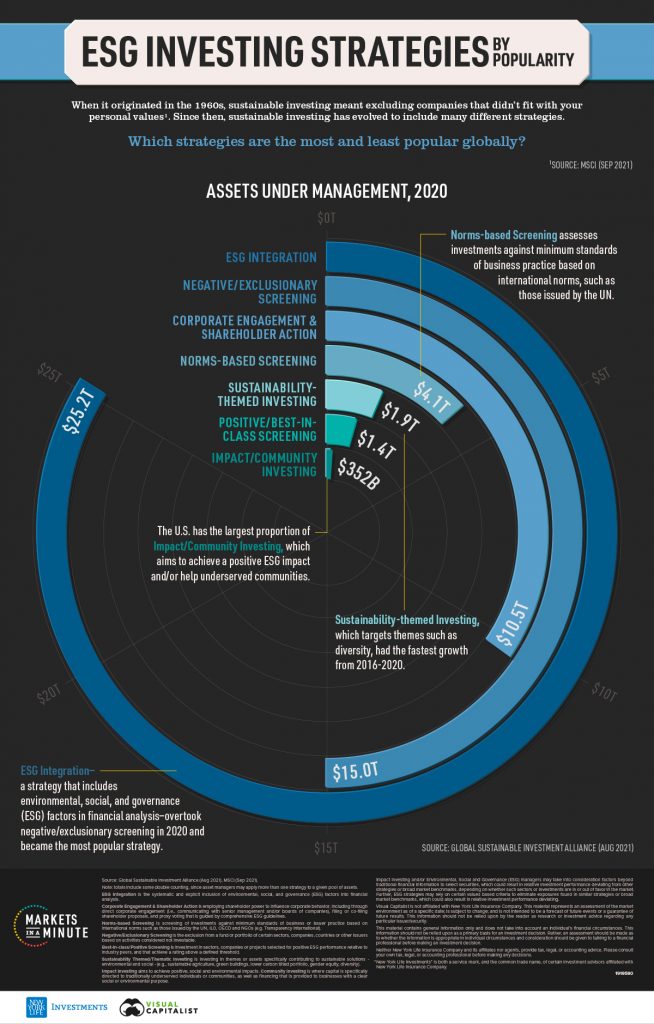
If you wanted to invest sustainably in the 1960s, your options were fairly limited. Sustainable investing strategies kicked off with socially responsible investing, where investors could exclude stocks or entire industries from their portfolio based on business activities. For example, if you didn’t agree with smoking you could exclude tobacco production companies.
Fast forward 60 years, and investors have many more approaches available to them. From exclusionary screening to ESG integration, which strategy is the most popular? This Markets in a Minute from New York Life Investments shows global assets under management for various sustainable investing strategies, to see which ones are used the most and the least globally.
The Types of Sustainable Investing Strategies
Before we dive into the numbers, it’s helpful to know the definitions of the various sustainable investing strategies. The Global Sustainable Investment Alliance, who put together this data, has classified sustainable investing into the seven core strategies below.
- ESG integration: The explicit inclusion of environmental, social, and governance (ESG) factors into financial analysis
- Negative/exclusionary screening: The exclusion of certain sectors, companies, or countries based on activities considered not investable
- Corporate engagement & shareholder action: Influencing corporate behavior through actions such as shareholder proposals
- Norms-based screening: Screening investments based on international norms, such as those issued by the UN
- Sustainability-themed/thematic investing: Investing in themes specifically contributing to sustainable solutions, such as diversity
- Positive screening/best-in-class: Investment in sectors, companies, or projects with positive ESG performance relative to industry peers
- Impact/community investing: Investing to achieve positive ESG impacts, and/or investing in traditionally underserved communities
While these sustainable investing strategies differ in their approaches, they all require investors to consider ESG factors as they build and manage portfolios.
Sustainable Investing Strategies by Global AUM
Below, we show the global assets under management (AUM) of the sustainable investing strategies in 2020. It should be noted that these numbers include some double counting, as asset managers may apply more than one strategy to a given pool of assets.
| Strategy | Global Assets Under Management (2020) |
|---|---|
| ESG integration | $25.2T |
| Negative/exclusionary screening | $15.0T |
| Corporate engagement and shareholder action | $10.5T |
| Norms-based screening | $4.1T |
| Sustainability-themed investing | $1.9T |
| Positive/best-in-class screening | $1.4T |
| Impact/community investing | $352B |
In 2020, ESG integration overtook negative/exclusionary screening to become the most popular of all sustainable investing strategies. Its rise can likely be attributed to having access to more specific data, such as ESG ratings, that make an inclusive approach easier to implement. In addition, many investors are beginning to understand that considering ESG factors alongside financial analysis may help manage investment risks and increase return potential.
Coming in at third place, corporate engagement and shareholder action has over $10 trillion in assets worldwide. A separate report found that the number of ESG-related campaigns went up in 2021, and the success of investor activist campaigns increased slightly year over year. In fact, 25% of surveyed U.S. boards say they have already tied executive compensation to ESG metrics or are planning to do so.
Impact/community investing has the least AUM globally. It is most popular in the U.S., where 60% of the strategy’s total assets are held.
Growth Rate by Strategy
Of course, the above data reflects that some strategies–like exclusionary screening–have been around for longer periods of time. In contrast, the idea of impact investing was spurred in 2009 after the Global Impact Investing Network was launched.
Another way of gauging each strategy’s popularity would be to look at its recent growth. Here’s the compound annual growth rate of the sustainable investing strategies from 2016-2020.

Sustainability-themed investing saw the highest growth. In 2020, it overtook positive/best-in-class screening to become the fifth most popular strategy. This growth mirrors the rise of thematic investing more broadly, as investors aim to capitalize on long-term structural shifts.
Norms-based screening was the only strategy to see negative growth, likely due to the way it is defined. Some standards falling under this strategy are now minimum and mandatory requirements by various national governments, especially in Europe where regulations have tightened. Because it is expected that these regulations are being followed, investors are least likely to say that norms-based screening is the strategy they use when they classify their sustainable investments.
Spoilt for Choice
Compared to the 1960s, today’s investors have many more sustainable investing strategies at their fingertips. However, with more options comes a new challenge: which strategies should investors consider?
The answer will depend on an investor’s objectives, but this data can give some insight on how other investors are approaching sustainable investing.
Source: https://advisor.visualcapitalist.com/sustainable-investing-strategies-by-popularity/
SHARE THIS POST
A Tribute to Financial Planning

If I could have just one more day
I’d remind myself again to play
For life is not about just toil
It’s more than planting money seeds in soil
For money trees, whilst it’s good if they grow
Give much more pleasure if you also enjoy the show
The seasons of your money tree, the changing colours, height, and shape
Can seem reasons to change your own personality cape
However, it’s often not what shows outside
While these pretty things can give a sense of pride
It’s more about the strength of heart and warmth within
These parts of life do not grow worn and dim
So, whilst you may be looking to find
The magic bean that Jack planted and climbed
Just remember, you likely already have your seed
You may just need some good advice to feed
This part of you that you wish to nurture
Wish to comfort, to strengthen, even to merger
And who must you seek on this journey to guide
Across waters which may seem always at wrong tide
To cast light on the path, and lead to safe harbour
A trusted adviser my friend, is the one to be your guide
And the best one to sit with along the ride
If I could have just one more day
I’d find a financial planner with whom to spend that day
Composed by Ellie Pickford – G3 Financial Freedom
SHARE THIS POST
Wall Street VS Main Street

What is the relation between the economy and the stock market?
Here is a comparison between S&P 500 returns and U.S. GDP growth since 1980, revealing that the two have a very complicated relationship

In 2020, the stock market and the economy had a very public break up. The Wall Street vs Main Street divide—the gap between America’s financial markets and the economy—was growing. By the end of the year, the S&P 500 Index closed at a record high. In contrast, 20 million Americans remained unemployed, up from 2 million at the start of the year.
Was 2020 an outlier, or does the performance of the stock market typically diverge from the economy? In this Markets in a Minute chart from New York Life Investments, we show U.S. economic growth and stock market performance over the last four decades, to see how closely the two relate.
GDP Growth and S&P 500 Returns
Here’s how annual GDP growth and S&P 500 Index returns stack up from 1980 to the second quarter of 2021. Both metrics are net of inflation.
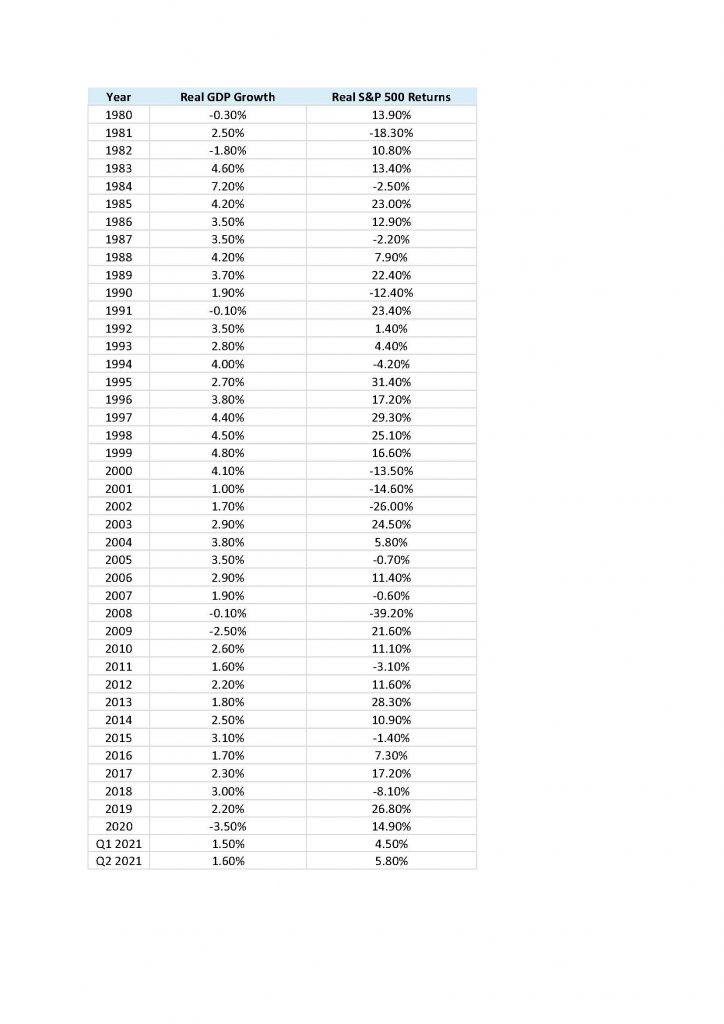
More often than not, GDP growth and S&P 500 Index returns have both been positive. The late ‘90s saw particularly strong economic activity and stock performance. According to the White House, economic growth was bolstered by cutting the deficit, modernizing job training, and increasing exports. Meanwhile, increasing investor confidence and the growing tech bubble led to annual stock market returns that exceeded 20%.
In the selected timeframe, only 2008 saw a decline in both the stock market and the economy. This was, of course, caused by the economic growth was bolstered. Banks lent out subprime mortgages, or mortgages to people with impaired credit ratings. These mortgages were then pooled together and repackaged into investments such as mortgage-backed securities (MBS). When interest rates rose and home prices collapsed, this led to mortgage defaults and financial institution bankruptcies as many MBS investments became worthless.
Moving in Opposite Directions
What about when the Wall Street vs Main Street divide grows?
Historically, it has been more common to see positive GDP growth and negative stock performance. For example, real GDP grew by a whopping 7% in 1984 due to “Reaganomics”, such as tax cuts and anti-inflation monetary policy. However, the stock market declined as rising treasury yields of up to 14% made fixed income investments more attractive than equities.
On the other hand, in five of the six years with negative GDP growth, there have been positive stock returns. The most recent example of this is 2020. Real GDP declined by 3.5%, while the S&P 500 returned almost 15% net of inflation.
The Stock Market is not the Economy
There are a number of reasons why the stock market may not necessarily reflect what is happening in the economy.
- The stock market reflects long-term views. A stock’s price factors in what investors think a company will earn in the future. If investors are confident in the likelihood of an economic recovery, stock prices will likely rise. In contrast, GDP growth is a hard measure of current activity.
- Sector weightings in the stock market do not reflect their contributions to GDP. The stock market remained resilient in 2020 largely because technology, media, and telecom (TMT) stocks performed well. Despite making up 35% of the market cap of the largest 1,000 U.S. stocks, these companies only account for 8% of U.S. GDP. In contrast, hard-hit companies such as restaurants and gyms generate lots of jobs and contribute materially to GDP. However, many of these businesses accounted for a small portion of the stock market or are not even publicly listed.
- Fiscal policy lags behind monetary policy. The U.S. Federal Reserve (Fed) can act quickly. For instance, the Fed bought $1.7 trillion of Treasury securities between mid-March and June 2020 to stabilize financial markets. On the other hand, fiscal support requires legislative approvals. The U.S. government initially provided large-scale economic stimulus through the CARES Act in March 2020, but further relief packages were stalled due to political disagreements.
While many factors are at play, the above can help explain the Wall Street vs Main Street divide.
Wall Street vs Main Street: Together and Apart
Over the last 41 years, the economy and the stock market have moved in opposite directions almost as often as they have moved in the same direction. Here’s a summary of their movements from 1980-2020.
- Stock Growth, GDP Growth 22 years
- Stock Decline, GDP Growth 13 years
- Stock Growth, GDP Decline 5 years
- Stock Decline, GDP Decline 1 year
Since 1980, these time periods of differing performance have never lasted more than three consecutive years. In fact, one economist described the stock market and the unemployment rate as two people walking down the street, tethered by a rope.
”When the rope is slack, they move apart. But they can never get too far away from each other.”
—Roger Farmer, University of Warwick economist
After their public breakup in 2020, the Wall Street vs Main Street divide appears to have healed. In the first two quarters of 2021, both the stock market and the economy saw growth. Perhaps it’s easiest to sum up their relationship in two words: it’s complicated.
Source: The Advisor Channel https://advisor.visualcapitalist.com/wall-street-vs-main-street-the-stock-market-is-not-the-economy/
SHARE THIS POST
Scams. The more your know, the less they grow

With scams on the rise, there has never been a more important time to be alert.*
Make Money Work for You
The best way to protect yourself is to know what to look out for. Here are some of the tricks that scammers are using right now:
Cloned investment companies and pension scams
Not everyone is who they say they are. Any company, even a big company, can be cloned so that documents and websites look like the real thing. They may try to tempt you with a new investment or suggest you move money from an existing investment or pension. Scammers do their research on you so they sound even more convincing.
To check if they are who they say they are, go to the New Zealand Companies Office website and search the company and look for any warnings. If they’re genuine, you can then contact the company in confidence using the genuine details. If you’re still unsure, speak to someone you trust or your financial adviser.
Email, text and phone scams
Emails, text and even phone numbers can be made to look like they’re from companies you’re already dealing with. They may ask for account details or remote access to your computer. If you’ve been contacted unexpectedly, always treat it as suspicious and avoid clicking on links. To be completely sure, call the company on a trusted number you’ve found online.
Cold calling and doorstep scams
People may ring you up or knock at your door pretending to be from a well-known organisation – even from your bank or the police. They may scare you into thinking your money is at risk. If anyone contacts you asking you to withdraw cash or hand over your bank details and PINs, put the phone down or close the door.
Rogue tradespeople may also call at your door saying they’ve noticed that something needs fixing on your house. Never hand over money following a cold call – do your research first.
Latest Scam – voicemail texts
Text messages are being sent by scammers all the time. The latest text scam tells you to click a link to listen to a new voicemail.
Clicking on it could infect your phone with a virus, and you may be asked to download an app or give account information. This could give scammers access to your account, so be careful – don’t click on links you’re unsure about.
As a nation, we aren’t known for being direct. We say ‘yes’ because they don’t want to appear rude by saying ‘no’. And when it comes to fraudsters, being indirect could have serious financial and emotional consequences.
Always take a moment or two to stop and check when you receive a message or phone call, even from companies you already deal with. Could it be fake? Are they asking you for personal information or money? Remember, you can always ask someone you trust for advice.
The Financial Markets Authority (FMA) has a warnings and alerts on it’s website. If you want to know some of the scams currently operating in New Zealand check it out here
SHARE THIS POST
What Is Important About Money To You
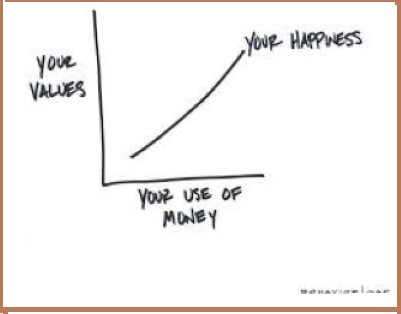
Whilst this may be an uncomfortable question to ask yourself, and it can certainly feel awkward when we ask it of our clients, it is a vital aspect of the planning we provide and helps you understand and define your significant ambitions in life. Our colleague Carl Richards explains more here
What’s important about money to you?
This is an uncomfortable question because we aren’t used to thinking about money in those terms. But it’s one of my favourite questions to ask.
The purpose of this question isn’t to think in terms of goals; it’s meant to go deeper than that or to get at the reason why we have certain goals.
The first answers people come up with are usually easy—things like security and freedom. But once we pause and really think, we can move even deeper still, or into what might be called the “why” of money.
This question gets uncomfortable because it forces us to get really clear about our underlying reason for doing things. It also forces us to face some inconsistencies in our lives.
Let’s say the first thing you come up with when you ask yourself the question, “What’s important about money?” is indeed freedom or security.
Then, the next question you should ask yourself is, “What’s so important to me about freedom and security?’” From there, keep asking questions until you get to the thing that is most important to you.
Let me give you an example of how this works.
My friend, who we’ll call Sara, was a hard-charging professional whose career required her to be super-competitive. She was “type A” to the hilt and worked long hours. So when I talked to Sara and her husband and asked her this question, I was curious what she would say was most important.
“Freedom,” Sara said, almost instantly.
When I asked her what freedom meant, she replied, “More time.”
So I said, “Okay, let’s pretend you’re there. Let’s say you have more time. What’s so important about being at that spot?”
With some emotion, she said, “I just want the time to raise a child.”
Bingo. There’s Sara’s money “why.”
Now, don’t get caught up on Sara’s specific value. Her values are hers; your values may be completely different. The thing to keep in mind is that, like Sara, once you identify what’s most important to you, things get clearer.
Being able to answer this question gives you a lens through which to view your financial decisions. And after you’ve identified what’s most important, you’ll have incredibly useful information to help you make decisions that match your values.
In fact, it can make it easy to say no to things that distract you from what’s important. Like the self-help author Stephen Covey said, “It’s easy to say ‘no!’ when there’s a deeper ‘yes!’ burning inside.”
For Sara, her answer became that “deeper yes.” The same can be true for you. You just have to ask the question.
Source: Behavior Gap www.behavior.com
SHARE THIS POST
Infrastructure Megatrends: The Clean Energy Transition
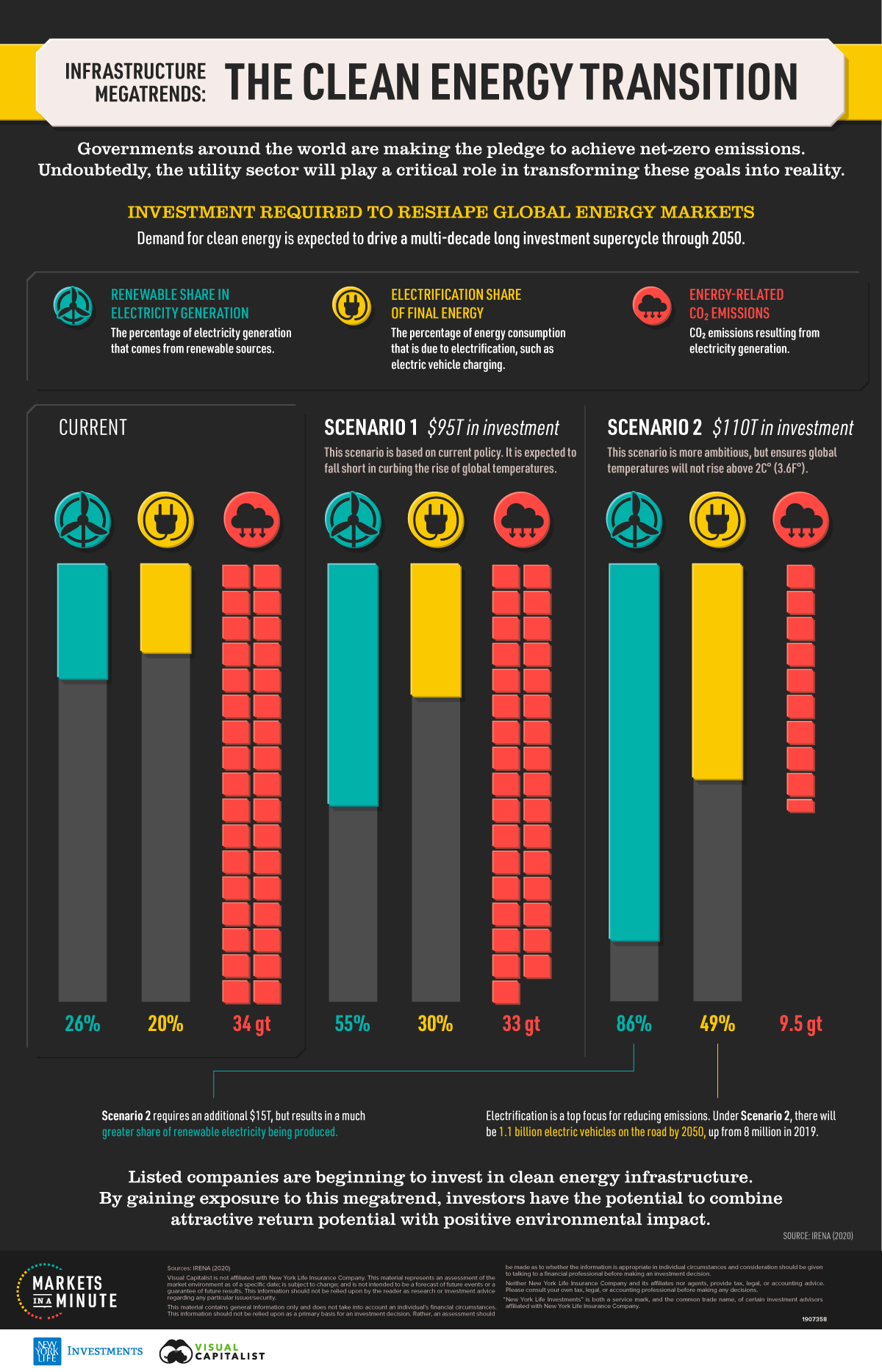
Demand for clean energy is ramping up as a majority of countries target 2050 as the year to achieve net-zero emissions. But how much will this all cost?
According to the International Renewable Energy Agency (IRENA), upwards of $100 trillion is needed to build a system capable of keeping global temperatures from rising above 2C° (3.6F°).
In the above chart from New York Life Investments and Visual Capitalist, we take a closer look at the outcomes of such a massive endeavor.
Investment Required to Reshape Global Energy Markets
The IRENA believes there are two scenarios for how the clean energy transition plays out by 2050.
Their first scenario involves a total investment of $95 trillion (112% of global GDP in 2020) and is based on current policies and targets. Despite the lofty amount, this scenario is expected to fall short in achieving the goals set by the Paris Agreement.
Their second scenario involves a more ambitious set of targets, as well as a 16% larger investment of $110 trillion. Thanks to economies of scale, this scenario will reduce carbon emissions much further and keep the global temperature rise below 2C° (3.6F°).
The estimates behind these two scenarios are outlined in the table below.
| Current Situation | Scenario 1 ($95T in investment) | Scenario 2 ($110T in investment) | |
|---|---|---|---|
| Renewable Share in Electricity Generation | 26% | 55% | 86% |
| Electrification Share of Final Energy | 20% | 30% | 49% |
| Energy-Related CO2 Emissions (gigatonnes) | 34gt | 33gt | 9.5gt |
How Do We Get There?
For scenario 2 to become reality, significant changes would need to be made across the entire economy.
For starters, the IRENA estimates that 1.1 billion electric vehicles will be on the road by 2050, up from 8 million in 2019. The resulting need for charging infrastructure is reflected by Scenario 2’s higher share of electrification (49% vs 30%).
Government subsidies around the world would also need to be adjusted, with much less money flowing to fossil fuels. The chart below provides a roadmap for these adjustments—on the left is the dollar value of subsidies, and on the right is each segment’s share of the total.
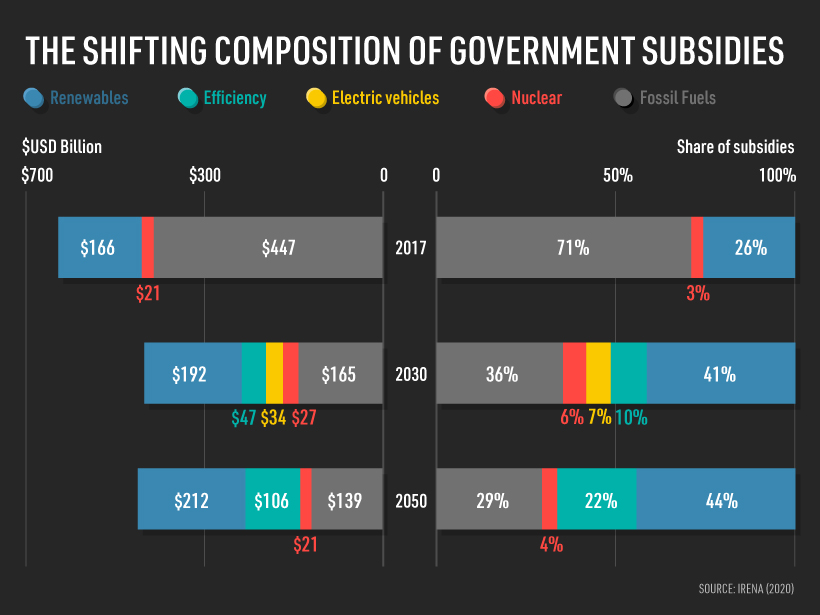
Fossil fuel subsidies in the U.S. are facilitated through tax cuts, and are estimated to be worth around $20 billion per year. This may change very soon, as the Biden administration has signaled its intention to eliminate these subsidies as part of its 2021 tax plan.
With Great Change Comes Great Opportunity
The demand for clean energy is expected to kick-off a monumental transformation of the world’s infrastructure.
For investors, gaining exposure to this megatrend may combine attractive return potential with positive environmental impact. In fact, many listed companies in the utilities sector are establishing themselves as leaders in this regard.
Consider Enel, an Italian multinational with activities in Europe and the U.S. The firm has directed capital towards renewable energy since 2015 and is now the world’s largest player in renewables with 46GW of installed capacity across solar, wind, and hydro.
Further developments are planned, and Enel expects to grow its earnings (represented by EBITDA) at a compound annual growth rate (CAGR) of 5%-6% over the next decade.
To learn more about the opportunities surrounding clean energy, consider this infographic on the global sustainable recovery.
Source: Advisor Channel
SHARE THIS POST
How do we ensure we achieve our financial ambitions in life

Well for sure, there are no guarantees involved with this question and when it comes to financial planning and investing for our futures, us humans do not fit into any kind of mathematical modelling tool, especially when it comes to managing our emotions around money.
As financial planners, we do use modelling algorithms, as this helps us guide our clients in what they need to be doing to have a successful future. However, whilst the modelling tells us what to do and why, when it comes to people and money, things can get a little messy and sometimes complex.
The best check on identifying the consequences of our actions when it comes to money, and anything for that matter, is of course hindsight. Also, our experiences and beliefs in life dictate how we feel about something going forward and therefore, how we are going to react. Challenging those belief systems is complex, and for us to just provide some simple formula to tell our clients what they need to do with their money, to be successful (whatever that means to them), is not always easy for the client.
The only way to navigate the complexity of managing money and investing, is through constant corrections of the course we travel and from our experience, the best way to do this is to assess someone’s situation, make the best guess of what needs to done, and when, then put some actions in place, before repeating this through regular monitoring.
Our ‘guess’ of course, is based upon our extensive knowledge and expertise, however, this cycle of assessing, guessing, acting and repeating is driven by the volatility and changes in the individual’s life. If their circumstances are relatively stable, we may only need to review plans every six or twelve months, or even longer, however, it is when things change or ‘blow up’ in their life, that they may need to revisit this cycle more regularly, and this is where we support their daily or monthly decisions.
The key is remaining flexible, especially as we know we do not fit into mathematical algorithms that financial modelling provides, so we don’t try to do this. In reality, we prefer to acknowledge that real life takes over, investment markets are volatile and money matters can be untidy, so making ourselves as adaptable as possible is the ‘way to go’.
Controlling what we can control and letting go of the things we cannot, whilst remaining flexible, is the crucial part of helping us achieve the things in life we value, and allowing our money decisions to support these.
Charlene Overell
G3 Financial Freedom Ltd
SHARE THIS POST
SPIVA: the surprising results and what it means for you

One of the most persistent debates in the investment industry is whether investors are better to use passive or active managed funds. With strong advocates on both sides of this debate, it may seem like an obscure discussion. However, for investors, long term performance data tells a conspicuous story.
Managed funds provide a very efficient investment mechanism. They enable investors to gain exposure to a wide range of underlying companies at a fraction of the cost of buying shares in each of those businesses directly.
What managed funds don’t do is to tell you the best strategy to follow.
At the two ends of the investment spectrum sit alternative philosophical approaches – active and passive. An active fund manager will typically allocate funds into only a handful of companies; these are usually the businesses they believe will perform better than average in the coming period. A passive fund manager does not allocate based on a subjective forecast, instead they usually follow a more systematic process to buy and hold all (or the vast majority of) the businesses in a particular market or segment.
Each year, ratings and index company Standard and Poor’s (S&P) publish a score card to determine if active investing or passive investing performed better, as a whole, over the previous year. The score card, S&P Index verses Active, or SPIVA, answers the question, how many active managers actually did better than a passive benchmark and, conversely, how many did worse.
If you believe that active management is superior to passive management, then you’d probably expect the majority of active managers would be able to beat a simple market index.
If you did believe that, you’d be disappointed to see S&P’s results.
Once again in 2020, the majority of active managers did worse than their respective benchmark index.
We say ‘once again’ because in the US at least, which is the biggest and deepest market for managed funds in the world, it’s the 7th consecutive year this has happened.
Below is a table with the results for every year since 2001.
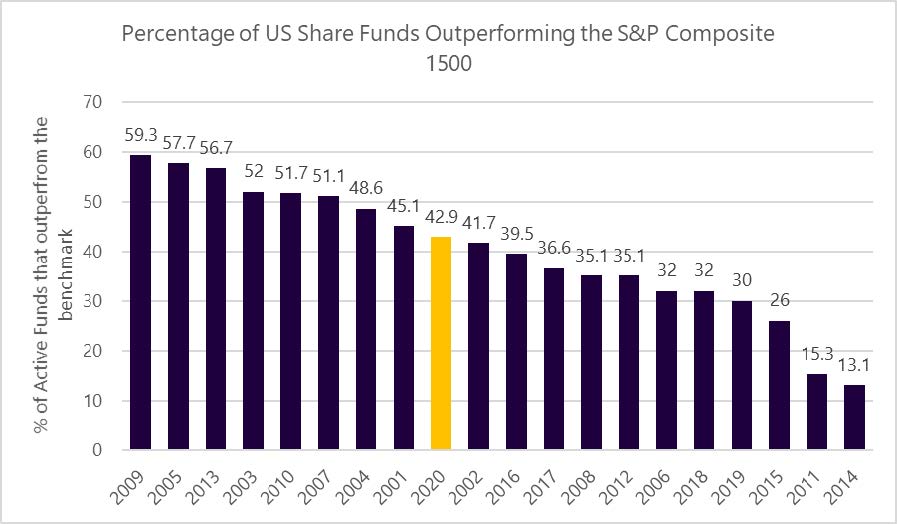
Source: S&P Dow Jones Indices LLC. Data as of Dec 31, 2020. Past performance is no guarantee of future results. Chart is provided for illustrative purposes.
As depicted by the yellow column, only 42.9% of active US funds beat their benchmark in 2020. This recent result is especially interesting because if there was a year that active managers had every opportunity to outperform, it would have been in 2020.
With the global pandemic causing significant market upheaval in February and March, a skilled active manager could, for example, have correctly anticipated the turbulence and decided to hold extra cash in their funds. They could have avoided investing in badly affected industries such as airlines and tourism. They could have instead invested into successful digital channels, firms such as Amazon and Google. Even getting just one of these calls right would have had a substantial impact on their relative performance, because 2020 was a year where returns were starkly different between Covid winners and Covid losers.
Yet, despite all of that, the majority of active managers still underperformed.
While 2020 is illustrative, the most important information for long-term investors is how active management compares to a passive alternative in time frames of 10 years or more. Fortunately, S&P collect this data and we are able to look across all global markets to see if active managers, as a group, are adding value in any country, or over any significant period of time.
The answer is a resounding no.
The table below shows the 10 year results for the percentage of active managers that perform better than a passive benchmark index. What’s notable is that none of these numbers are at 50% or higher. In other words, in every country or geographic zone, the majority of active funds have lost to the benchmark index over this longer timeframe.
| Fund category | Comparison Index | 10 Year (%) |
| United States General Equity | S&P 1500 | 17 |
| Australian Equity General | S&P/ASX 200 | 21 |
| Europe Equity | S&P Europe 350 | 14 |
| Eurozone Equity | S&P Eurozone BMI | 8 |
| Nordic Equity | S&P Nordic BMI | 17 |
| France Equity | S&P France BMI | 8 |
| Germany Equity | S&P Germany BMI | 20 |
| Italy Equity | S&P Italy BMI | 20 |
| Spain Equity | S&P Spain BMI | 17 |
| Netherlands Equity | S&P Netherlands BMI | 0 |
| UK Equity | S&P United Kingdom BMI | 35 |
| Denmark Equity | S&P Denmark BMI | 15 |
| Poland Equity | S&P Poland BMI | 37 |
| Switzerland Equity | S&P Switzerland BMI | 16 |
| Sweden Equity | S&P Sweden BMI | 19 |
| Indian Equity Large-Cap | S&P BSE 100 | 32 |
| All Japanese Equity | S&P Japan 500 | 33 |
| Brazil Equity Funds | S&P Brazil BMI | 14 |
| Chile Equity Funds | S&P Chile BMI | 2 |
| Mexico Equity Funds | S&P/BMV IRT | 18 |
| Simple Average | 18% |
Source: S&P Dow Jones Indices LLC, Morningstar. Data as of Dec. 31, 2020. Past performance is no guarantee of future results. Table is provided for illustrative purposes.
In fact, the simple average in the table above is only 18%. For the avoidance of any doubt, that means only 18% of active funds beat a passive benchmark over a 10 year period!
For those who might argue this is just a US phenomenon, and that smaller markets are more fertile markets for active managers to outperform, the graph below (including the same data as the table above) doesn’t back that up. In fact, it shows that the US is right in the middle of this wider distribution of countries. This shows that this active/passive story is not exclusive to the US.
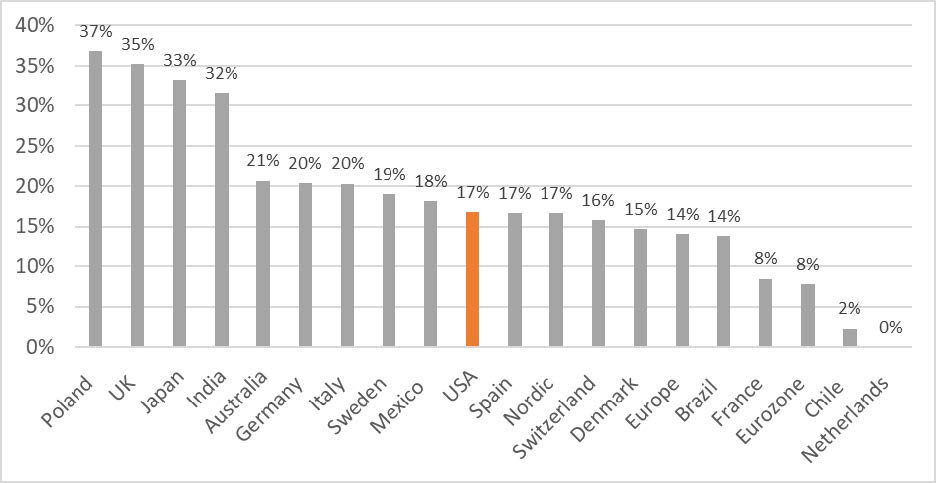
Source: S&P Dow Jones Indices LLC, Morningstar. Data as of Dec.31 2020. Past performance is no guarantee of future results. Table is provided for illustrative purposes.
Although this may be academic to many investors, this is data and information that we monitor regularly. The implications are clear. If we pay extra to allocate to an active manager, the evidence tells us we should expect to lose. Over a 10 year time horizon, we have, maybe a 20% chance of selecting a fund that beats its benchmark over the decade. We don’t like those odds and we don’t think you should like them either.
But let us make this more interesting and practical. Through our affiliation with Consilium and other likeminded advisers, we have secured access to the lowest cost New Zealand Portfolio Index Fund available to retail investors. We have also secured access to the lowest cost New Zealand SRI fund. The cost to invest in these funds is about 0.10% each. This is a substantial achievement. If we allocate to these funds then, based on the S&P data above, we are fairly certain to beat the majority of more expensive active funds over any considerable time period. Although its true to say that past performance is no guarantee of future results, the data supporting this assertion is compelling.
We’re equally sure that there will be about one out of five actively managed funds that do outperform their benchmark, over a 10 year time frame. Unfortunately, there is no reliable way of knowing who these few outperformers will be ahead of time, especially not the fund managers themselves (although their self-promotion might say otherwise).
So rather than spin the roulette wheel and hope for a lucky pick, we’ll take the known odds that are on offer. By allocating to the lowest cost available NZ managed fund tracking the portfolio index, we give you an excellent opportunity at well above average results.
While this data from S&P may seem academic, it’s incredibly practical. And, over the long term, it helps clarify the strategies that are more likely to help you achieve your long-term investment goals.
SHARE THIS POST
Timeless lessons from decades in finance

One of the major fund managers appearing within our client investment portfolios is Dimensional, and for very good reasons! Dimensional have recently had its 40th birthday and David Booth, founder, looks back on his decades in finance to share the lessons of investing that are wise and relevant, that our clients come to understand and appreciate. This article also has some great short videos that help explain the message. Click here for the article
SHARE THIS POST
Online trading? Check your overconfidence at the door

A question we’ve been asked quite a few times within the last year goes something like this,
“So my son is investing on Sharesies. What do you think of them…?”
It’s a great question and one we thought deserved an article of its own.
Sharesies, Hatch and other digital trading platforms easily accessible by smartphones have grown enormously popular in recent years. Sharesies claims to have 350,000 users which would be about 7% of the population of New Zealand. That’s a remarkable achievement.
There are a number of positive aspects to these digital trading platforms. Easy to access and requiring only a small amount of cash to begin investing, they appeal to younger investors, and we now see New Zealanders investing (and saving) at a younger age. The result will hopefully be an increase in financial literacy born out of experience.
However, it’s a more nuanced question as to whether or not these platforms are leading to successful investing outcomes. Successful compared to what? Compared to term deposits? Compared to the average return of the market? The answer depends on the basis of the comparison. Unfortunately, we don’t have data available from these New Zealand platforms so it’s hard to evaluate the average performance of their investors.
While online trading platforms have only recently gained popularity in New Zealand, they have been around internationally since the 1990s. In the United States, Ameritrade, E-trade, Scottrade and more recently Robinhood, are all examples of online trading platforms. Having access to this longer-term international data lets us assess performance by looking at the evidence.
The academic peer-reviewed evidence shows a fairly consistent pattern. Those who trade online, and especially those who trade frequently, typically do worse than the market return.
One of the first studies of online trading platforms was conducted in 2000 by Dr Brad Barber (University of California, Davis) and Dr Terrance Odean (University of California, Berkeley), titled “Online Investors: Do the Slow Die First? (1)
Easy to access and requiring only a small amount of cash to begin investing, they appeal to younger investors, and we now see New Zealanders investing (and saving) at a younger age.
Their general conclusion was that investors who switched to trading online traded “more actively, more speculatively, and less profitably than before – lagging the market by more than 3% annually.”
That raises the question; if investors are less successful, why do they do it? The authors say their findings can be explained by, “overconfidence, augmented by self-attribution bias, the illusion of knowledge, and the illusion of control.” In other words, investors do worse because they give themselves too much credit when they are just fortunate with their picks, and they have a strong self-belief whether or not they actually have stock picking ability. Lastly, they feel like they have more control over investing outcomes than they really do.
Sources: 66,465 households with accounts at a large discount broker during 1991 to 1996, Barber, Brad M. and Odean, Terrance, Trading is Hazardous to Your Wealth: The Common Stock Investment Performance of Individual Investors. Available at SSRN: https://ssrn.com/abstract=219228 or http://dx.doi.org/10.2139/ ssrn.219228
After the adoption of trading by smartphone, investors are also more likely to purchase risky and lottery-type assets and to chase hot investments on their non-smartphone trading platforms as well.
This result isn’t surprising. In 2002 the same authors published an article in the Journal of Finance called “Trading is Hazardous to Your Wealth: The Common Stock Investment Performance of Individual Investors. (2)
In this study they discovered that of 66,465 households that had an account with a discount share trading platform, the ones that traded shares most frequently underperformed the market by 6.5% per annum (i.e. an average high-trading return of 11.4% compared to a market return of 17.9%). The average household with a trading account underperformed by 1.5% (i.e. an average household return of 16.4% compared to a market return of 17.9%).
Perhaps more relevant is a recent European study on the impact of technology on individual investors. In February 2021, Drs Ankit Kalda, Benjamin Loos, Alessandro Previtero and Andreas Hackethal, published “Smart(Phone) Investing? A within Investor-Time Analysis of New Technologies and Trading Behavior.”3
The authors looked at the period from 2010 to 2017 and the results of two European banks that introduced online trading via mobile devices.
Below is a summary of a some of their key findings:
- Smartphone users were about 8 years younger and 13% more likely to be males compared to nonusers.
- Smartphones increased the purchasing of riskier and lottery-type assets and the chasing of past returns by 67%.
- Smartphone trades involved assets with higher volatility.
- Smartphones increased the probability by 71% of buying assets in the top decile of the past performance distribution.
- Smartphone investors chased performance evidenced by the fact that 68% of purchases involved assets that had earned above median returns in the recent past.
After the adoption of trading by smartphone, investors are also more likely to purchase risky and lottery-type assets and to chase hot investments on their non-smartphone trading platforms as well.
Perhaps this academic speak can be better understood in light of a recent headline grabbing story “GameStop stock price crashes as Robinhood app restricts trading. (4)
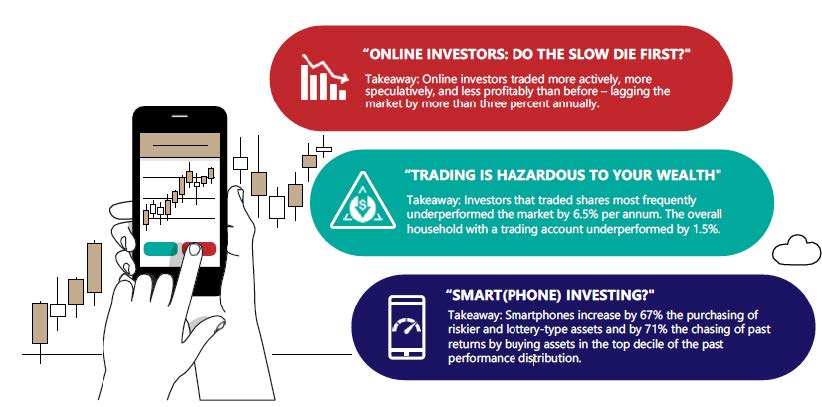
The idea that individual investors may be more inclined to buy a share after its price has gone up is behaviourally intuitive, but it’s not a particularly profitable strategy, at least according to most long-term measures.
Novice investors using the trading app/platform Robinhood bid up the value of a video game store called GameStop. The decision to invest in that business was not based on any careful evaluation of the business’s future prospects. Many investors piled in based on speculation alone. When it crashed some of those investors lost money.
This experience highlights a broader trend the authors of the Smart(Phone) Investing article bring to light. While smartphones offer convenience, that convenience sometimes comes with a cost of increased risk and reduced returns from lottery-like stocks which have historically produced worse than average subsequent returns.
The infographic above provides a snapshot of the three academic articles. These results are not particularly surprising. While in many ways Sharesies provides easier access to investing, we know from years of experience that investing isn’t easy. What feels intuitive is often misguided and can lead to poor long-term outcomes. The idea that individual investors may be more inclined to buy a share after its price has gone up is behaviourally intuitive, but it’s not a particularly profitable strategy, at least according to most long-term measures.
It’s no accident that advertisements for online trading platforms generally show the brands of some of the world’s most successful technology companies with good recent performance. But what young investors don’t realise is that those investments are also some of world’s most expensive companies based on earnings and prices. That doesn’t make them a bad investment. But a concentrated investment in those companies is far riskier than the ‘investing is easy’ advertising would lead you to believe.
In summary, if you have kids using online trading platforms in a casual way with small amounts invested, we believe this can result in many positive outcomes. It will increase their comfort with investing and likely lead to an increase in financial literacy. However, it may also lead to overconfidence, and the weight of evidence suggests you (and they) should expect outcomes lower than the market average.
When it comes to smart investing, the same principals always apply, regardless of age. If your kids are investing large amounts of assets they can’t afford to lose, they should probably seek a second opinion.
(1) Barber, Brad M. and Odean, Terrance, Online Investors: Do the Slow Die First? (December 1999). EFA 0335, Available at SSRN: https://ssrn.com/abstract=219242 or http://dx.doi.org/10.2139/ssrn.219242
(2) Barber, Brad M. and Odean, Terrance, Trading is Hazardous to Your Wealth: The Common Stock Investment Performance of Individual Investors. Available at SSRN: https://ssrn.com/abstract=219228 or http://dx.doi.org/10.2139/ssrn.219228
(3) Kalda, Ankit and Loos, Benjamin and Previtero, Alessandro and Hackethal, Andreas, Smart(Phone) Investing? A within Investor-Time Analysis of New Technologies and Trading Behavior (January 13, 2021). SAFE Working Paper No. 303, Available at SSRN: https://ssrn.com/abstract=3765652 or http://dx.doi.org/10.2139/ssrn.3765652
(4)https://www.abc.net.au/news/2021-01-29/gamestop-stock-price-crash-as-robinhood-restricts-buying-shares/13101670
SHARE THIS POST
Living with uncertainty

In this webcast, Jim Parker, Vice President communications at Dimensional, provides a fresh perspective on news and markets, as well as five key investor lessons for dealing with uncertainty.
SHARE THIS POST
The bumpy road to the market’s long-term average

Since 1980, the Australian stock market has rewarded investors with an average return of about 13%.
- Annual returns came within two percentage points of the market’s log-term average of 13% in just four of the past 41 years
- Yearly returns have ranged as high as up 67% and as low as 39%
- since 1980, annual returns have been positive 30 times and negative 11 times

Understanding the range of potential outcomes can help you stick with a plan and ride out the inevitable ups and downs
Past performance is no guarantee of future returns. Actual returns may be lower. Investing risks include loss of principle and fluctuating value. there is no guarantee an investment strategy will be successful. Indices are not available for direct investment. Index returns are not representative of actual portfolios and do not reflect costs and fees associated with an actual investment
In AUD. S&P/ASX data reproduced with the permission of S&P Index Services Australia.
AUSTRLAIA and NEW ZEALAND: This material is issued by DFA Australia Limited (AFS License Bi. 238093, ABN 46 065 937 671). This material is provided for information only. No account has been taken of the objectives, financial situation or needs of any particular person. Accordingly, to the extent this material constitutes general financial product advice, investors should, before acting on the advice, consider the appropriateness of the advice, having regard to the investor’s objectives, financial situation and needs. Any opinions expressed in this material reflect our judgement at the date of publication and are subject to change.
SHARE THIS POST
5 phrases to use to improve your emotional intelligence and relationships at work

This article is written by Bill Murphy Jr.
Many of us overuse “I’m sorry” when we should be using the phrase “Thanks for your understanding.”
- Having strong emotional intelligence is a self-improvement goal for many professionals.
- Author Bill Murphy Jr. says emotional intelligence starts with listening and being considerate of others.
- Use phrases like “tell me more” and “thanks for understanding” to shift the focus from yourself to others.
I’ve talked with a lot of readers about self-improvement in 2021. By far, the number one thing they want to work on is improving emotional intelligence.
Here are simple verbal habits that are designed to do exactly that. They’re adapted from my free e-book, Improving Emotional Intelligence 2021.
They’re easy changes really, just a matter of memorizing phrases. Let’s get started.
- “Tell me more.”
This is one of the most powerful phrases in the universe, and it’s my favorite one for improving emotional intelligence. It’s also nearly all-purpose. You can say, “Tell me more” in almost any situation, and you’ll do things like:
- Reassure the other person in a conversation that you’re interested and listening.
- Avoid the temptation of turning the focus of a conversation from the other person to yourself.
- Set yourself up for silence, which as we’ll see below is a powerful tool that emotionally intelligent people use.
Just imagine any conversation you’ve had — especially if it turned awkward or unsatisfying. Imagine replacing however you responded with this three-word phrase.
For example, imagine a friend tells you: “It’s hard to focus on work, since I’m stuck at home with the kids doing ‘virtual school’ on a computer all day.”
Most of us have been trained in that situation to say something like, “It’s hard at our house, too” or, “Can’t you just have your kids work downstairs while you work upstairs?”
But neither is really satisfying. Try replying instead with our three-word magic phrase, “Tell me more” and you reach a deeper level of conversation.
You’re giving the emotionally intelligent response, inviting your friend or colleague to share, explore, and maybe even find a solution.
- “Thanks for your understanding.”
We’re going to use this phrase as a replacement for something else: “Sorry.”
Not that you should never apologize. Of course you can, when you have wronged someone and you want to make amends. But many of us use that word too often, when we don’t truly mean to offer an apology.
Examples:
- “Sorry I missed the meeting.”
- “Sorry we can’t meet your deadline.”
- “Sorry I didn’t go to your party.”
So much about emotional intelligence involves shifting the focus of interactions from yourself to others. But the pseudo-apologies in these situations put the focus squarely on you.
Also, you were probably taught as a child that if you say you’re sorry for something, you should try never to do it again. But I’ll bet you’re probably going to miss more meetings in the future, right? There will be deadlines you won’t meet. You’ll skip parties once in a while.
Consider instead how the message changes if you phrase each of these examples like this:
- “My boss needed my help on something at the last minute, so I missed the meeting. Thanks for understanding.”
- “We have so many commitments right now, and shipments are delayed, so I don’t think we can meet your deadline. Thanks for understanding.”
- “I wanted to go to your party, but by the time I got home, it was so late. I realized I’d only be able to come by for 10 minutes. Thanks for understanding.”
It’s subtle, but this phrase combines gratitude, sympathy, and other-focus, all in one package. It’s very powerful.
- “Hello.”
Wait, you might say. “Hello”? Doesn’t everybody say hello?
Actually, no. Pay attention to how people open conversations, and you’ll see that they more often start with open-ended questions — questions that everyone knows they have no desire to know the answer to.
I’m talking about things like:
- “How are you doing?”
- “What’s going on?”
- “How are you?”
It’s the rare person who wants a truthful answer: “Well, I have a headache, and the check engine light is on in my car, but my daughter got some good news the other day about her college applications, and I…”
Uh-huh. I mean, if you’re truly a friend or truly interested, great, maybe you want to know.
But the vast majority of the time, we ask these conversation openers expecting rote replies — phrases uttered so quickly and automatically that the phrases become contracted words:
- “Good-n-you?”
- “Aw, nothing.”
- “Notsobad.”
At the very least, even if you do care about the person’s answer, everyone knows that your goal is to move past the answer and get to the point of your conversation: “Sorry to hear about your headache, but I need your help to…”
I know this sounds incredibly semantic, maybe even hair-splitting. But opening instead with a declaration — basically anything that doesn’t involve a disingenuous question that you don’t really want the answer to — is an improvement.
Examples:
- “Hello.”
- “Great to see you.”
- “Thanks for coming by.”
See what I mean? These are neutral/positive messages — neither particularly other-centered nor self-centered. Try them out, and I think you’ll notice an improvement.
- “Am I making sense?”
This is another super-powerful phrase, and you’re going to use it in place of two others: “Do you understand?” or, “Do you have any questions?”
I realized its power after studying the speaking phenomenon of “high rising terminal” or “uptalk.” This is the phenomenon that results in people speaking declarative sentences with a rising pitch that is more commonly applied to asking a question.
Some people say it’s a bad habit, or suggests a lack of confidence.
But I’ve come to realize it’s a very powerful, emotionally intelligent mechanism that enables people to make suggestions, tune in with their audiences, and pull the other people in a conversation along with them — even when they have less power than everyone else.
Let me put it a different way. Imagine I have to explain something complicated to you. At the end, I can ask three different things. What subtle message is contained in each phrasing?
First: “Do you have any questions?”
The default answer to this question is, “No, I don’t have any questions.” Thus, it requires a bit of bravery even to be the first to ask. Why do you want to create that hurdle for the other people in a conversation?
Second: “Do you understand?”
This is other-centered, of course, but it can put people on the defensive. The subtle message contained herein is that you’ve explained perfectly, perhaps we need to work on the other person’s remedial understanding. You can do better.
Finally: “Am I making sense?” or another similar question.
This is powerful in its humility. Here, we’re shifting the presumption so that if there’s been a breakdown in communication, it might be your fault (you haven’t made sense) as opposed to the other person’s (they just didn’t understand).
That makes it much easier for the other person to respond truthfully and completely.
You might have to overcome a bit of vanity — “I know I’m making sense. I’ve explained this to hundreds of people.” But the point isn’t to pump up your ego.
Instead, it’s to use an emotionally intelligent strategy to facilitate communication — and make it more likely as a result that you’ll get what you want and need.
- Absolutely nothing.
You know that old saying: “Don’t just stand there. Do something!”
People with high emotional intelligence prefer the opposite: “Don’t just do something. Stand there!”
Or its corollary: “Don’t just say anything. Keep quiet!”
Saying nothing means you’re not saying something stupid. It means you’re giving yourself time to think before replying.
It also means, since people are naturally inclined to fill silences, that you’re inviting others to say something — maybe something they haven’t thought out as well as you might.
This is a good time to point out a misunderstanding about improving emotional intelligence. Since it can lead to more conciliatory conversations and better relationships, there can be a tendency to think it’s about being nice.
But to be cold-eyed about it, being nice is a tactic, not a goal.
Imagine a negotiation, for example: You make an offer, and the other person makes a counteroffer. Instead of continuing, you simply stay quiet.
It’s your turn to talk and yet, you’re not saying anything.
As a result, you seize control of your emotions, and theirs. Maybe the other person wonders if he or she has killed the deal. Maybe they sweeten the counteroffer before you’ve said a thing.
I remember reading an article about how car dealerships used to use a two-word phrase to take advantage of people’s natural inclination to want to say something. It went like this:
- Dealer: “I’m sure we can find a great car for you. What’s your budget?”
- Customer: “My limit is $25,000.”
- Dealer: “Up to…”
Supposedly, a non-zero number of customers would take the bait, and reply with a higher number. “Maybe we could go to $29,000.”
Don’t be like those people in 2021. Use these kinds of phrases to work on your emotional intelligence. And if you don’t have something emotionally intelligent to say, say nothing at all.
Read the original article on Inc. Copyright 2021. Follow Inc on Twitter.
SHARE THIS POST
Significant tax changes in place for residential property investors

We have pleasure in linking you to an article provided by Belly Gully on the changes announced by the government to the way residential property is to be taxed, so click here for more details: https://www.bellgully.com/Pages/Significant-tax-changes-on-the-way-for-residential-property-investors.aspx
SHARE THIS POST
Time – it’s free, but it’s priceless!

Time is the one thing just about everyone I meet says they want more of….Imagine time as money…
Imagine that you won a prize where each morning your bank account was deposited with $86,400 for you to spend how you choose.
However, there are rules:
1. What you don’t spend each day is taken away from you.
2. You can’t save any of it.
3. You can’t transfer any of it.
4. The prize can be taken away without warning!
So knowing these rules what would you do?
Chances are you wouldn’t want to waste any of it. You would make sure you enjoy it. You would look after the people you love. You’d give to people you don’t even know.
You would spend every cent, every day!
This prize actually exists. Except instead of money, each day we are given a gift – TIME!
Each morning we awaken to receive 86,400 seconds as a gift of life. When we go to sleep at night, any remaining time is NOT credited to us. We can’t save any of it.
Source: Dean Lombardo, LinkedIn. regoslife.com
SHARE THIS POST
When The Magic Happens

It’s interesting that in times of adversity, innovation thrives! Media often shares negative stories that we call ‘noise’, playing on our concerns and emotions. However, this article, whilst long, is a good read to remind ourselves that 2020 may be another year of amazing advances in many areas of our lives, especially when we look back at history, and how the world coped and changed in times of crisis. Check more out here
SHARE THIS POST
Trust Act – are you ready for 31st January 2021?

SHARE THIS POST
Trust Act 2019 – In or Out?
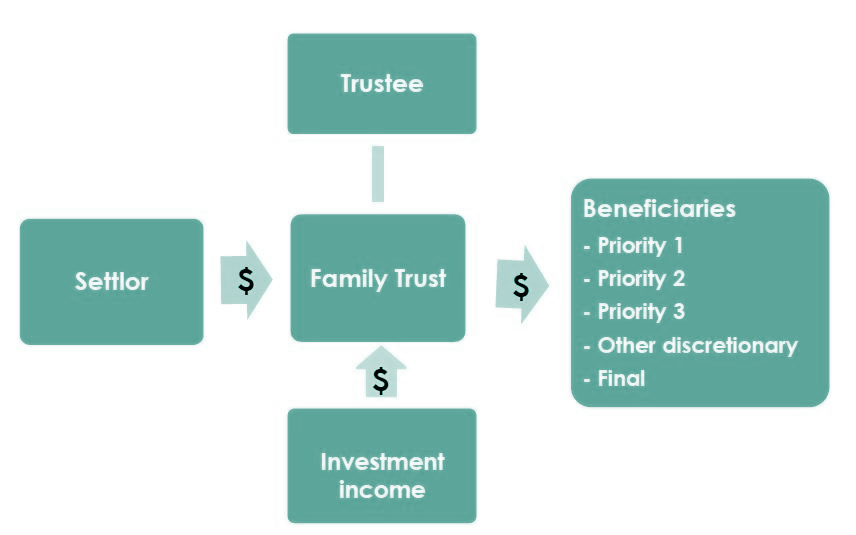
It really is decision time for professional trust service providers and many will already be ‘in the thick’ of supporting trust clients. However, in light of the change to the Trust Act that become effective from 30 January 2021, the window for trustees to decide how to position themselves and their trust services, is closing fast.
Source: Lindsay Pope https://www.lindsaypope.com
SHARE THIS POST
When It’s Time For A Tune-up

My dad was a mechanic – a pretty good one from all accounts. That’s him in the photo. He’s always liked fixing things.
As a kid, I recall hearing “a mechanic’s car is always the worst”. It may well have been mum who yelled it whenever my brothers and I were push-starting her 1964 Ford Cortina in a heavy Invercargill frost.
That recollection came back to me recently when I was eating breakfast. I was thinking about how my affairs were organised and I had one of those “oh shit” moments
It wasn’t so much that I didn’t have good plans in place. It was the sudden realisation that as a single person living alone, no one else knew what they were.
Did my adult children know what I own? Did they know I have a family trust, that they are beneficiaries, or that my brother is a trustee? How would my laptop be accessed? Who knew where I keep my original documents? Did anyone know what was important to me
It dawned on me that I hadn’t told anyone. That’s like owning that ’64 Cortina and hiding it in a shed.
I sat down and wrote a letter to my children and brother about how things worked, where things were and what was important to me. The positive response I received surprised me.
As I see it, it’s up to me to make sure my affairs are in order and to prepare my heirs. It just took a pending crisis to expose potential vulnerabilities and take the right action to tune things up.
From my experience, we get to choose the impact of our legacy on the people (or causes) we care most about. That impact can be positive or negative.
What will the impact of your legacy be?
Source: Lindsay Pope www.lindsaypope.com
SHARE THIS POST
Women Are Under Engaged With Financial Planning Despite Wealth Increase

Gender equality has yet to be achieved in terms of financial planning, even though women’s wealth has been growing rapidly in the last decade, according to a survey released by U.S. Bank on Wednesday.
Nearly half of women surveyed say they associate financial planning with negative words, such as fear, anxiety, inadequacy, and dread. By comparison, 31% of men express similar negative feelings toward financial planning. Conversely, 69% of men associate financial planning with positive words such as happiness, excitement, and pride, while only 53% of women respondents say so.
The data is from an online survey of 1,514 women and 1,486 men of all ages with minimum investable assets of $25,000. The survey is fielded between Oct. 23 to Nov. 15, 2019.
According to the survey, women are less engaged with personal finance than men. It showed that 52% of women talk about money with their friends, while 61% of men do; and 37% of women use a personal financial or budgeting app, compared to 48% of men.
While most women handle family finances, such as planning vacations, health care, and paying bills, they are still less confident about managing money. Just 23% of women say they feel very financially prepared, compared to 34% of men; 19% consider themselves financially savvy (vs. 33% of men); and 47% say they feel confident in their ability to manage their finances (vs. 61% of men), according to the survey.
“While we know that women have more money and power than ever before, the survey results tell us they aren’t getting the most out of it,” Gunjan Kedia, vice chair of wealth management and investment services at U.S. Bank, said in a news release.
In the U.S., women’s wealth has been growing significantly in the last decade. Between 2010 and 2015, private wealth held by women grew to $51 trillion from $34 trillion. By 2020, they are expected to hold $72 trillion, or 32% of the total wealth, according to a 2018 Boston Consulting Group report.
“Women today have unprecedented power to use money to influence our society, and by taking a few simple steps to engage more and earlier with money, we can get there,” Kedia said.
One crucial step is to start early, she said. “Whether it’s with a financial advisor, using a digital app, or just watching shows and listening to podcasts about money.”
Source Fang Block
SHARE THIS POST
Introducing The Financial Resilience Index

The Research
The Financial Resilience Index uses five key financial indicators to gain insight into how Kiwis feel and think about financial issues.
- Financial Confidence
- Financial Literacy
- Financial Preparedness
- Job Security
- Wellbeing
Standout pieces of the research include the relationship between financial concerns and mental health with over 40% of Kiwis worrying about money on a weekly basis at least, and the effect that COVID-19 has had on New Zealanders with 50% of Kiwis feeling an effect from the crisis on job security in April. As an industry we have invested in this landmark research to build a better picture and understanding of exactly how New Zealanders feel at this time and in coming months about money and other everyday financial concerns.
For more information please see the following link
https://www.fsc.org.nz/bulletin_display/x_blog_code/2108.html
SHARE THIS POST
Do NOTHING with your investments………ride the storm…

We have all heard of ‘walls of worry’ and in the investment world, the media and all the hype focus on the ‘reasons to sell’ investments when world news focuses on the negative. However, we need to also remind ourselves of the ‘reasons to buy’ and focus on what we CAN control, not what we cannot. Check out this article discussing exactly this :
SHARE THIS POST
Hindsight Is 20/20. Foresight Isn’t

Dec 19, 2019
EQUITY INVESTING INVESTMENT PRINCIPLES
The year 2019 served up many examples of the unpredictability of markets.
The RBA expected the cash rate to stay steady or rise, but it fell instead. Sentiment around the residential property market started the year at an eight-year low with the prospect of potential changes to negative gearing on the horizon.1 Australian consumers’ confidence weakened as the year began,2 and news headlines broadcast fears of an economic slowdown. But investors who moved onto the sidelines may have missed the big gains in the Australian stock market. As of the end of October, the S&P/ASX 300 Index was up more than 20% for the year on a total-return basis. That puts it on course for the best showing since 2009, should it hold through December. Australian housing prices also rallied and are on track to post a positive gain for the year following reductions in the RBA cash rate, no changes to negative gearing policies and a loosening in loan serviceability policies from APRA.3
Outside Australia, Greece—the site of an economic crisis so dire some expected the country to abandon the euro earlier this decade, and a country whose equity market lost nearly a third of its value last year—has had one of the most robust stock market performances in 2019. On top of that, Greece issued bonds at a negative nominal yield, which means investors paid for the privilege of lending the government cash.
Taken as a whole, it’s a reminder that the prediction game can be a losing one for investors.
Up or Down?
A closer look at interest rates and bond markets around the world shows just how unpredictable asset performance can be. Going into 2019, the RBA expected no near-term adjustment in monetary policy, with the next move likely to be an increase in the cash rate.4 Instead, the RBA cut the cash rate three times throughout the year. It was a similar story in the US, with Federal Reserve officials expecting to raise rates, but instead lowering them three times.
Globally, we have seen bond yields fall. In some markets, yield curves inverted (where long-term yields fall below short-term yields), including the US Treasuries market, which inverted for the first time in more than 10 years, as seen in Exhibit 1. Moreover, yields on medium- and long-term bonds were at historically low levels at the start of the year, but they fell even lower by the end of October. Investors who moved to cash based on the expectation yields would rise in 2019 may have been disappointed with how events ultimately transpired, with global bonds returning 7.71% for the year to 31 October 2019 while bank deposits earned less than 2% interest.5
EXHIBIT 1
Shifting Curves
Yields on US Treasuries of various maturities since the end of 2018
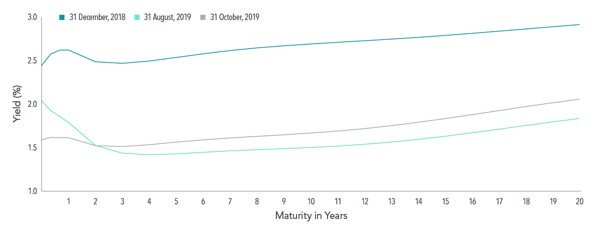
Trading Places
Events weren’t any
easier to anticipate in the global equity markets, where no evident link
appears between markets that performed well last year and those that have
excelled this year, as Exhibit 2 shows.
Among the 23 developed market countries,6 only one country was a Top 5 performer for
2018 and 2019: the US. Last year’s strongest performing market—Finland— ranked
22nd this year through the end of October. Among emerging markets, Greece
swung from a 30% decline last year to a 40% advance this year through the end
of October.
EXHIBIT 2
Changes in the Ranks
Performance of equity markets in 23 developed and 24 emerging economies

Perennial Wisdom
Careful research of historical returns has shown there’s no compelling or dependable way to forecast stock and bond movements, and 2019 was a case in point. Neither the mainstream prognostications nor recent hindsight predicted outcomes in 2019.
Rather than basing investment decisions on predictions of which way debt or equity markets are headed, a wiser strategy is to hold a range of investments that focus on systematic and robust drivers of returns. Investors who were broadly diversified across asset classes and around the globe were in a great position to enjoy the returns that the markets delivered in 2019. Last year, this year, next year—that approach is a timeless one.
FOOTNOTES
- 1Based on readings from the NAB Residential Property Index for Q4 2018.
- 2Based on readings from the Westpac-Melbourne Institute Index of Consumer Sentiment.
- 3Janda, M 2019, ‘Sydney, Melbourne house price surge accelerated in November’, ABC News, 2 Dec. 2019.
- 4Based on the December 2018 Minutes of the Monetary Policy Meeting of the Reserve Bank Board.
- 5Global bond returns measured by the Bloomberg Barclays Global Aggregate Bond Index (hedged to AUD). Bank deposit interest rates the average of interest rates between Jan. 2019 and Nov. 2019, sourced from RBA Statistical Table F4 – Retail deposit and investment rates; Savings accounts; Banks’ bonus savings accounts; $10,000.
- 6Markets designated as developed or emerging by MSCI.
DISCLOSURES
This material is issued by DFA Australia Limited (AFS License No. 238093, ABN 46 065 937 671). This material is provided for information only. No account has been taken of the objectives, financial situation or needs of any particular person. Accordingly, to the extent this material constitutes general financial product advice, investors should, before acting on the advice, consider the appropriateness of the advice, having regard to the investor’s objectives, financial situation and needs.
Indices are not available for direct investment. Their performance does not reflect the expenses associated with the management of an actual portfolio.
Past performance is not a guarantee of future results. Diversification does not eliminate the risk of market loss.
Source: Dimensional
SHARE THIS POST
The Chinese Coronavirus and its impact on Global Share Markets

In recent weeks, concerns have grown about the potential effect of a spreading coronavirus on the global economy and on share markets around the world. This coronavirus, a form of pneumonia (now labelled Covid-19), is a new disease that originated in China and still remains largely based in China. The disease, however, has begun to spread to other countries, most notably South Korea, Japan and Iran and it does appear to have some potential to slow economic growth, certainly in China, but also in economies reliant on China, including Australia.
In recent days some investors have taken fright, so that in the case of the all-important US stock market, the broad market (S&P500 index) fell 4.6% from its record peak on 14 February over the 10 days to 24 February. From 1 January this year though, net market movements have been more subdued, including a 0.1% decline for the broad US market, while the UK, German, French, Chinese and Indian markets fell respectively by 5%, 2%, 3%, 1% and 2%. On the other hand, over the same period this year, the Australian market (ASX200) rose by 4% and the technology-focused Nasdaq index in the US rose 3%.
In other words, market movements since the start of 2020 have been limited, despite an increased awareness and fear of the potential spread of this new coronavirus in recent days. Thus recent share market declines should be kept in perspective, as global share markets have been enjoying a bull run since early in 2019 and in many cases had run very strongly before this recent market correction. This recent pull-back means that most major stock markets are now more attractively priced than previously and most share markets continue to appear better value than most other investment opportunities, such as bond markets or cash holdings.
It should be kept in mind that share markets are inherently volatile, with periods of price rises following periods of decline. The overall trend of share markets though tends to be positive, as long as the economic fundamentals underpinning these markets remain favourable. This is because when we invest in the share market we are actually investing in the broader economy through the companies that make up that economy. If company earnings are on an upward trend, then share market prices are likely to follow this trend.
At present, despite the emergence in recent weeks of this coronavirus in China, global economic fundamentals continue to look reasonably positive. Although the International Monetary Fund (IMF) recently marginally revised down its global growth forecasts for 2020 and 2021 (from 3.4% to 3.3% in 2020 and from 3.5% to 3.4% in 2021), forecast growth rates remain on a par with the long-term trend (around 3.3%), led by a strong US economy. The US economy has been growing at a real (inflation-adjusted) rate of over 2% per annum and has seen the unemployment rate decline to a 50-year low. Despite this solid performance, however, the US central bank (the ‘Fed’) has maintained a relatively ‘loose’ monetary policy, lowering interest rates over the past year and increasing liquidity in the financial system (‘quantitative easing’ or ‘QE’) in recent months.
Also positive is the outlook for corporate earnings this year, not only in the US, where earnings are forecast to grow by around 8% this year and 12% in 2021 (Yardeni Research, 25 February) but also in other jurisdictions such as Europe (7% and 8%). Even better is the outlook for key emerging markets, such as India, where earnings are forecast to grow by 23% this year and 16% next year and even China, where despite the coronavirus hindering growth, earnings are nevertheless forecast to grow by 11% this year and 14% in 2021. The outlook for our own corporate sector is also positive (earnings growth of 4% and 3%). Overall, this bodes well for share market valuations. In most economies, monetary policy remains highly expansionary, with official interest rates now below 0% in Europe and in Japan and with ‘quantitative easing’ continuing in both regions, as well as in the US since last September. This is also positive news for both continuing economic recovery and for share market performance over time.
In the Australian context, of course, it’s economy tends to do well when the rest of the world is growing strongly. Our own share market tends to follow directional trends from the major overseas markets, especially the US, but has the added attraction of a high dividend yield.

Conclusion
Share market volatility is likely to remain high as long as the coronavirus continues to affect higher numbers of people and as long as it continues to spread to other countries. However, as the above graph demonstrates, there seem to be indications of success in containing the spread of the virus in China, while in Australia the virus still remains almost non-existent. As far as global share markets are concerned, this recent correction has pushed markets back to fairer valuation levels and further upside appears likely in time, given continuing solid growth in the US and ongoing recovery in Europe and Japan. In the case of China, the economy is likely to slow markedly over the March quarter and, on some forecasts, could even record close to 0% growth for this period. However, assuming that the virus can be further contained and assuming that the total number of those infected with the virus begins to decline significantly, the Chinese economy could be expected to begin to recover sooner rather than later. In turn, this would be positive for further global recovery and for share market performance over the rest of this year.
Our advice to investors is to stay well diversified across asset sectors………investing in growth assets is for investors who have a longer-term investment horizon, which allows time for markets to readjust to periods of negative volatility and, in time, resume their upwards trend. Certainly, now is not a time to panic, to sell out in haste and to potentially realise capital losses in some cases. Now is a time to stay invested and ride through the current period of market correction and to await a resolution of the Covid-19 coronavirus epidemic, after which share markets could potentially rebound in time.
Source: Conrad Burge, Fiducian Group Ltd
SHARE THIS POST
Living In Fear Of A Market Downturn?
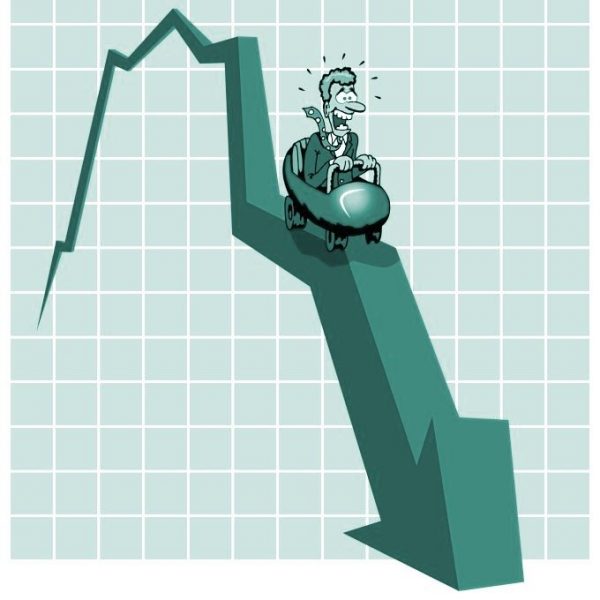
Maybe we will have a recession, maybe we won’t—but be wary of predictions on how markets will behave. It’s a losing game. The results of those who try to time markets or pick winners have been studied extensively, and there is no compelling evidence they do better than you would expect by chance. Check out this compelling read as reminder to us investors of what we need to focus on, rather than all the media ‘noise’ about whether there is going to be a market downturn or not. Click here
SHARE THIS POST
BOMAD

Our world in 2019 is full of acronyms. For a long while we have had SKI (Spending the Kids Inheritance) where retirees are no longer focussing on protecting assets for the children to inherit. Instead, now that 70 is the new 60, they are out there travelling further and having fun.
But as the property markets continue to rise and first home ownership becomes more and more of a struggle for our children, BOMAD is becoming ever popular. The Bank of Mum and Dad is often the only option they have to get enough of a deposit together to buy somewhere.
As families gather for Christmas and we take stock, looking back over what we may have achieved and make plans for the future, it is often the time the topic of helping the children into their own home gets discussed. Whilst this can be helpful if done properly, we are here to play devil’s advocate!
- None of us know what is around the corner: We might feel that we are sitting pretty with enough funds in the bank or our investment portfolio to see us through but we need to factor in the unexpected. When our clients ask us our advice on whether they should gift or even lend their children a deposit, we look at the bigger picture. What happens if one of you die? Are you relying on two NZ Superannuation payments and the money left in the bank to support you throughout? What happens when one of those payments stops? Can you survive financially? It is important that your own financial security is exactly that, secure, before you consider helping – unless the children will be happy to have you live with them in the future!
- Get it in writing: our children won’t ever let us down will they? We all believe our children will be our friends forever. Sadly relationships often break down for a myriad of reasons and any money you have lent needs to be protected through legal documentation. It is important that you get legal agreements in place.
- Without proper agreements your children’s partners, whether current or future, might become entitled to half of the money you have helped them with.
- Sometimes a loan can be an option, and often it is intended that the money given is in fact a loan. No documentation is put in place on occasions for this loan, as this may complicate and restrict any lending the bank is prepared to offer the children, as the loan repayments need to be factored in to the borrowing affordability when looking to the bank for other lending. However, with no signed agreements, there is no recourse for the parent, and if the children have relationship issues you can potentially say ‘goodbye’ to at least 50% of your money
- It is not unusual for some parents to take on loans themselves to help fund the children – this is a high risk scenario and could easily jeopardise the parent’s home ownership and security.
- Giving them money now might mean that you do not qualify for Residential Homecare Subsidies down the track if WINZ believe you have deprived yourself of that money. If your son or daughter cannot pay you back or subsidise any care home fees, you might find yourself in trouble and with limited options.
- Many perceive that the easiest option is to act as a guarantor for the loan as they do not have to part with any physical cash. However, these are far reaching agreements and you could find yourself responsible for the full loan repayments if your son or daughter defaults
- Can you help all of your children? If you gift one child the deposit for a home, are you going to be able to do the same or similar for their siblings? Inequality in how you treat them can be a sure-fire way to create family tensions
In an ideal world, we would all want to see our children financially settled however, we need to ensure that any help we give does not negatively impact our own long-term financial security.
It is important to take legal advice and have contractual agreements drawn up. Getting the children in front of a Financial Planner first is also a good idea, as perhaps they can work on a plan which doesn’t involve BOMAD and as parents, you can go SKI ing instead!
SHARE THIS POST
Happy 10th Birthday G3
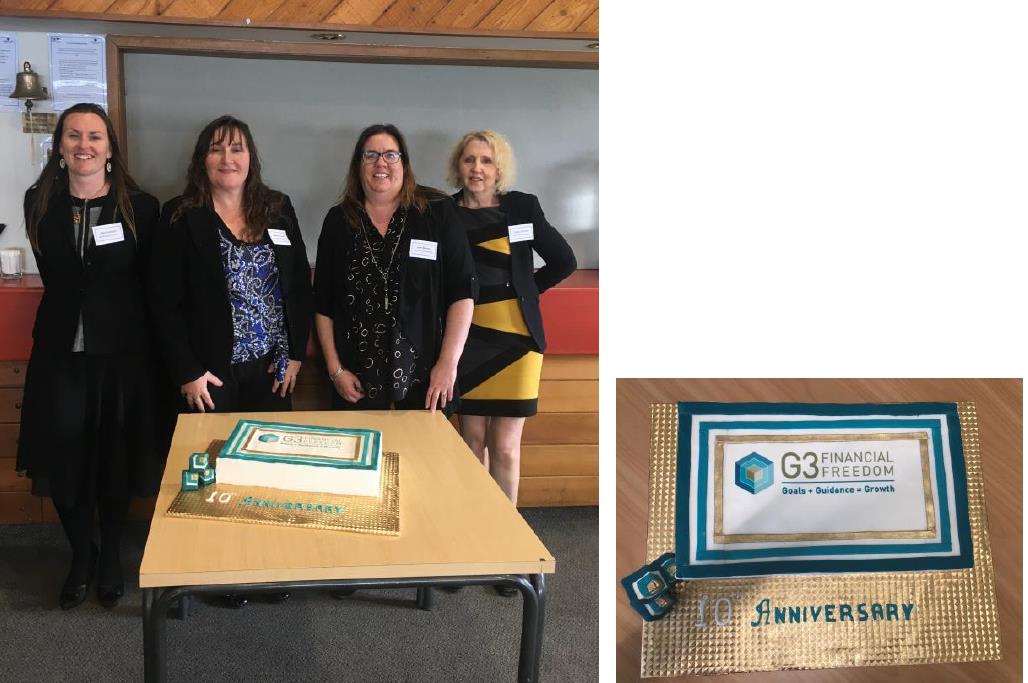
We are now into double digits of being in business and we would like to thank all our clients and professionals who have supported us in reaching this milestone – you are very much appreciated and part of our family in helping us get where we are today!
Some of you kindly joined us for our celebratory function in September, where we had speakers from Consilium and Dimensional share their insights about investing around the world. Consilium are the experts we choose to partner with for our investment expertise and support and Dimensional are one of the fund managers that appear in our client portfolios. Both travelled distances from Christchurch and Sydney to be with us for this special occasion. Two of the speakers, Ben Brinkerhoff and Jim Parker, shared their thoughts on how the media create so much negativity and hype around investing, and what investors need to do to achieve a successful investment experience, so check out this video interview here
SHARE THIS POST
The World Cup Of Investing

It’s been a banner year for New Zealand sport, with a world championship win in women’s netball, the narrowest of world cup losses in men’s cricket and an upcoming attempt by the All Blacks to win an historic third consecutive rugby world cup.
It’s fair to say that just as NZ punches above its weight in global sport, its share market has been an outperformer in recent years. But it’s also worth keeping a sense of perspective, both in terms of history and the size of
the opportunity.
In sport, the women’s netball team, the Silver Ferns, waited 16 years to win the world cup, and then defeated Australia by just a single goal. Even the All Blacks, historically the world’s best rugby team, took 24 years to
repeat their 1987 world cup triumph.
NZ shares aren’t world beaters every year either. It’s true the Kiwi share market has been the developed world’s second-best performer in four of the past 10 years. In fact, it has posted positive annual returns for every year since the GFC.
But you only have to cast your mind back a little bit further to find years when the Kiwi market was a relative struggler. In 2000, it was the worst performing developed market in the world. In 2005 and 2006, it was the third worst, albeit with positive returns.
If you go back even further, the NZ market was hit harder than most by the 1987 crash and its aftermath. The market, as measured by the S&P/NZX All Index fell by nearly 50% in 1987 and did not turn cumulatively positive
till nearly a decade later.
Such was the pain generated by the 1987 crash in New Zealand that an entire generation of investors was turned off equities. The tragedy is that so many sought solace instead in poorly performing and illiquid property
finance schemes.
There are a couple of lessons from all this for investors. Firstly, just as World Cup winners are hard to predict, there is no evidence that you can consistently outguess prices and pick which country will be the best market
performer from year to year.
The second lesson is you need to be mindful of how much your international portfolio is biased to your home market. Remember that NZ accounts for a tiny proportion of the global share market, at around 0.01% or one tenth of one per cent
Dimensional’s Jim Parker goes deep to investigate if the NZ stock market can maintain its All Blacks-like run – read the full story in the PDF
SHARE THIS POST
What Dropping 17,000 Wallets Around The Globe Can Teach Us About Honesty

So picture this: You’re a receptionist at, say, a hotel. Someone walks in and says they found a lost wallet but they’re in a hurry. They hand it to you. What would you do?
And would that answer be different if it was empty or full of cash?
Those are questions researchers have been exploring.
The experiment started small, with a research assistant in Finland turning in a few wallets with different amounts of money. He would walk up to the counter of a big public place, like a bank or a post office.
“Acting as a tourist, he mentioned that he found the wallet outside around the corner, and then he asked the employees to take care of it,” says Alain Cohn from the University of Michigan, the study’s lead author.
The researchers assumed that putting money in the wallet would make people less likely to return it, because the payoff would be bigger. A poll of 279 “top-performing academic economists” agreed.
But researchers saw the opposite.
“People were more likely to return a wallet when it contained a higher amount of money,” Cohn says. “At first we almost couldn’t believe it and told him to triple the amount of money in the wallet. But yet again we found the same puzzling finding.”
The researchers decided to do the experiment on a much larger scale. They put together a team that dropped off more than 17,000 “lost” wallets in 40 countries over the course of more than two years.
All the wallets were about the same — a small clear case holding a few business cards, a grocery list in the local language, and a key. Some contained no money and some held the equivalent of about $13. Research assistants turned them in at the kinds of places people would typically bring a wallet they found on the ground — police stations, hotels, post offices and theaters.
Such a large operation came with a few headaches, Cohn says. One of the researchers was detained in Kenya for suspicious behavior. And researchers worried that a backpack full of wallets might raise eyebrows when crossing borders.
It’s also worth noting that for logistical reasons, most of the wallets were not literally returned to the researchers. After people reported a wallet to its supposed owner over email, they were told that the owner had left town and didn’t need the wallet anymore.
As results rolled in from around the world, the researchers kept finding the same result. In 38 out of 40 countries, people were more likely to report receiving wallets with money than those without. And in the other two, the decrease in reporting rates for the wallets with money were not statistically significant.
What if the wallets contained far more money? The researchers did a “big money” test in the U.S., the U.K. and Poland. In that phase of the experiment, the staff dropped wallets containing nearly $100, instead of $13.
Cohn says the results there were even more dramatic. “The highest reporting rate was found in the condition where the wallet included $100,” he says. Forty-six percent of wallets with no money were reported, compared with 61% of those with about $13 and 72% of those with nearly $100.
What’s behind all this honesty? The researchers suggest two explanations.
First, just basic altruism — the person who reports receiving a lost wallet might care about the feelings of the stranger who lost it.
There’s some evidence for that. The same team ran a test where some wallets contained only a key — a thing valuable only to the person who lost it. Those wallets were about 10% more likely to be reported than those with no key.
Caring about strangers doesn’t explain everything, though. The researchers think their findings also have a lot to do with how people see themselves — and most people don’t want to see themselves as a thief. Cohn says they polled people who said that if there’s cash in the wallet, it just feels more like stealing.
And, he says, “the more money wallet contains, the more people say that it would feel like stealing if they do not return the wallet.”
Duke University economist Dan Ariely, who studies dishonesty, says this shows material benefits do not necessarily drive people’s decisions about whether to be honest.
The study “shows in a very natural, experimental way our decisions about dishonesty are not about a rational cost-benefit analysis but about what we feel comfortable with from a social norm perspective and how much we can rationalize our decisions,” Ariely says.
The rates at which people tried to return the wallets varied a lot by country, even though the presence of money in the wallet almost always increased the chances. In Denmark, for example, researchers saw more than 80% of wallets with money reported. Peru saw a little over 10%.
The researchers think wealth could be a factor, but there’s a lot more research needed to explain the differences. “Now the problem is that we don’t really know whether wealth affects honesty or it’s the other way around” — whether honesty contributes to a country’s relative wealth, says Cohn.
Countries with higher rates of primary education were also more likely to see high rates of lost wallets being reported.
“What this suggests is that what you learn in school is not just math and reading but also social skills, or just more generally how you treat each other,” Cohn adds.
The study’s results could help policymakers and businesses that want to figure out what motivates people to act for the good of others, rather than for their own enrichment.
“What our study suggests is that there might be a potential to promote honest behavior, first, by making the harm that your behavior can impose on other people more salient,” Cohn says.
Cohn says the results also suggest that to promote honest behavior, businesses or policymakers should make it more difficult for people to deceive themselves that they’re being honest when they are actually doing the opposite. For example, by having people sign a statement promising truthfulness before they report their car mileage, rather than after.
And sometimes, honesty does pay. Almost all of the people who reported a lost wallet got to keep the cash.
SHARE THIS POST
Getting A Pass Mark

Garrison Keillor is a US author who created a fictional town for a US radio show. The town was called Lake Wobegon, and was apparently situated in Minnesota, on the edge of the prairie. It was also described as “the little town that time forgot and the decades cannot improve”, and more famously a place “where all the women are strong, all the men are good-looking, and all the children are above average.”
The mathematically inclined will appreciate the humour in the line “all the children are above average”, as it is statistically impossible for this to occur. What was supposed to be an amusing turn of phrase actually described a cognitive bias called Illusory Superiority. It is a condition where a person overestimates their skill and abilities in relation to other people’s skills and abilities. The condition also has a few other names, such as the “above-average effect”, “superiority bias”, and the “Lake Wobegon effect”.
Studies have demonstrated this effect in various studies, such as a 2000 survey of Stanford MBA students, of whom 87% considered themselves above average. Similar results can also be found when surveying driving skills. Where this cognitive bias affects investors can be seen in share traders buying and selling shares between themselves, each believing they have made a good bargain.
A similar effect can be seen among active fund managers. The premise of active management is that, due to the skill of the manager, investors will receive above average returns. In some cases, this is accurate – there are fund managers who provide returns in excess of market returns. The converse also occurs – some fund managers provide below market returns.
Some people may consider this an investment opportunity – if you can identify the correct fund manager, you can receive above market returns. Admittedly there is a risk of choosing a poor fund manager, but you can rationalise this because all investments have some level of risk attached to it.
For investors, it is not enough to simply appreciate that there is a risk – you should know what level of risk you are exposing yourself to because not all risks are equal. Take the risk of capital loss (ie your investment is worth less than you put in) as an example. This risk is always present, even with “safer” investments like term deposits. That being said, it is safer to have a term deposit with a major New Zealand bank compared to a term deposit with a minor finance company. The reason some investors choose to place deposits with finance companies is that they provide a higher interest rate compared to the safer bank deposit. Simply put, the investor has judged that the higher return from the finance company is compensating the investor for accepting a higher level of risk.
You also need to assess the level of risk when looking at fund managers because not all risks are created equally. It is hard to assess the risk that your chosen active fund manager will have a below market return. Rating companies provide a lot of detail on fund managers, but they do not provide a guarantee of above market returns.
Instead of looking at individual fund managers, let’s look at the overall odds facing an active investor choosing a fund manager. Standard & Poors (S&P) reviewed the performance 860 Australian equity funds, 436 international equity funds and 116 Australian bond funds over a range of timeframes. Over longer time periods of 5, 10 and 15 years, they consistently observed underperformance in most categories.
Putting some numbers around this analysis, in the general Australian equity category, over the year to 31 December 2018, in excess of 86% of funds did not outperform the index. For the 10 and 15 year periods, over 83% of funds did not outperform the index. From this we can see that some funds did outperform the market, but they were massively outnumbered by the number of funds that failed to outperform the market. The odds were not in the investors’ favour.
This is not an uncommon scenario. S&P also reported on the performance of active funds around the world. Below are the percentage of active fund managers who were outperformed by their benchmarks.
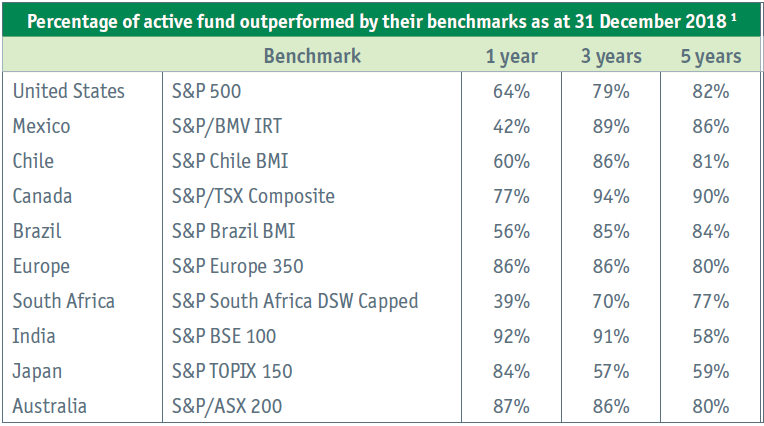
The conclusion is that most active fund managers are unable to beat their benchmarks. Some can manage it for a short period – as seen by the generally lower percentage in the 1 year column. Over longer time periods, over 80% of active fund managers cannot beat their benchmarks (with India and Japan being the main exceptions, and even then a majority of active fund managers are still beaten by their benchmarks).
If you want your investments to beat the market, choose carefully. The odds are not in your favour. The alternative is to focus on getting a market return. You may not be able to claim the best return, but beating 80% of the alternatives is a good starting point.
Technical, but necessary?
The problem with this sort of analysis is that it can seem a bit dry. What makes it relevant for investors, outside of bragging rights around the barbeque?
Most investors are saving for their retirement. The goal is not to be in retirement having won first prize in the stock picking competition. The goal is to ensure that you have enough money to fund the lifestyle you want in retirement.
Investors will only get one chance at their retirement. The risk for investors is that they will not have enough income to last them in retirement. This is a common concern, and the World Economic Forum** has produced the graph below which illustrates the size of the problem of retirees outliving their retirement savings.
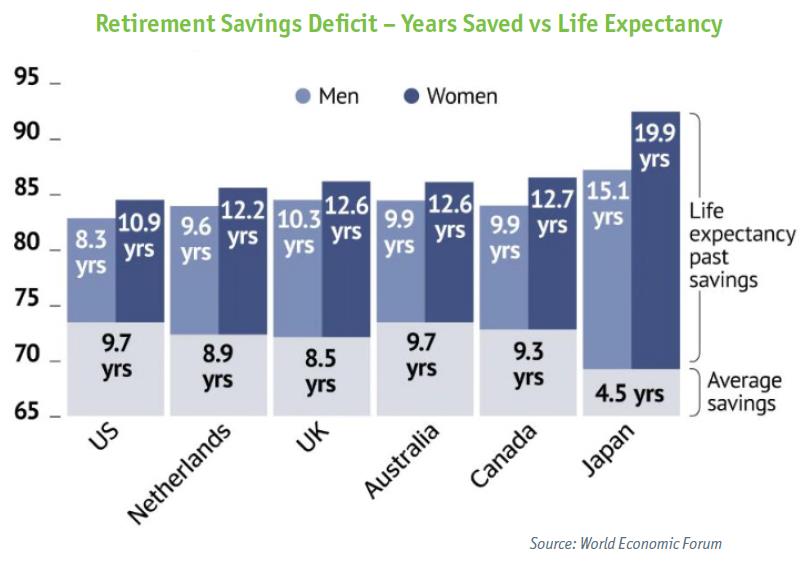
As a side note, you can see that Japanese retirees are expected to have the longest life expectancy past their savings. This partly reflects Japan’s longer life expectancy, but the primary driver is that the average investment is in defensive assets with low expected returns (such as cash), even for very young investors (eg 25 years old). As a result, their savings do not grow sufficiently to cover their retirement expenses. Choosing an inappropriate asset allocation can be as disadvantageous as choosing a poor active fund manager.
New Zealand is not included in this analysis, but the Financial Services Council reported*** in 2017 that “income from this accumulated wealth may run out for the majority of those aged 65+ within just 10 years after they stop work, leaving them with state pension income only for a decade or more”.
That would suggest New Zealand retirees are in a similar position to retirees worldwide.
The risk of outliving your retirement savings is real. It is complicated by uncertainty over the level of expenses you will face in retirement, and the level of income that will actually be generated to fund those expenses. Proper financial advice should consider both of these problems.
1 SPIVA Around the World, Standard & Poors
** Investing in (and for) Our Future, World Economic Forum White Paper, June 2019
*** Great Expectations, December 2017, Financial Services Council
Source: IOOF New Zealand – Portfolio Comment 30 June 2019
SHARE THIS POST
To Be More Productive, Manage Your Time Like An Athlete

How do you focus? Carving out time for quality work has become more challenging as the technology designed to help us increasingly gets in the way.
Phone calls, emails, ever-pinging notifications are all productivity killers – and if you work from home, you can add the doorbell, family and even pets to that list.
It will take some practice, but once you’ve developed this muscle, you can repeat it over and over to really increase your output.
Brad Stulberg recommends the professional’s version of High Intensity Training to get it all done – relatively short bursts of intense work, followed by a break. Then repeating.
To get better at managing your time, borrow a training strategy from elite athletes
Article by Brad Stulberg
In the 1930s, a German coach named Woldemar Gerschler came up with a novel idea to help runners better manage their time. He discovered that they could accomplish more in a given stretch if they broke it down into discrete chunks of running, followed by brief breaks. For instance, you’ll run faster, farther, and with better form if you run hard for six sets of seven minutes, each one followed by three easy minutes, than if you run for 60 minutes consecutively. Gerschler used this style of training to guide multiple runners to Olympic medals, and it wasn’t long before it spread throughout running and eventually into just about every other sport as well. By the 1960s, Gerschler’s method — what came to be known as “interval training” — was the predominant training system across elite sports, and it still is today.
Although this idea has shaped elite sports over the last century, it’s only in the past couple decades that it’s being lifted from the playing field and applied elsewhere. This is largely thanks to the behavioral scientist K. Anders Ericsson, who, in the 1990s, began to explore what separates great performers — musicians, artists, chess players, even physicians — from everyone else. Ericsson is best known for the 10,000-hour rule, or the idea that almost anyone can become an expert in almost anything with 10,000 hours of practice — but his actual findings were somewhat different. It’s not that the best performers put in more practice time than their peers (often, they don’t). Rather, it’s how they practice: with full attention, focused on high-quality work, and in chunks of 60 to 90 minutes separated by short breaks. In other words, interval training.
Ericsson’s work focused predominantly on creative and competitive pursuits, but in researching my new book, Peak Performance: Elevate Your Game, Avoid Burnout, and Thrive With the New Science of Success, I learned there is plenty of evidence to support adopting an interval-based approach for the workday, too. For example, consider the Draugiem Group, an international social-networking company that wanted to discover what habits distinguished its most productive workers from the rest of the pack. In 2014, Draugiem partnered with the makers of DeskTime, a time-tracking app sophisticated enough to determine when employees are working and when they aren’t. After monitoring workflows throughout a typical workday, the company discovered that its all-star workers adhered to a particular routine: They spent, on average, 52 minutes engrossed in their work, took a 17-minute break, and then returned to their work.
Other companies are also beginning to follow suit, analyzing and manipulating how their employees use time. Thus far, the conclusions have all been the same: Regardless of the industry or job type, repeating cycles of intense, highly focused work followed by short breaks seem to produce the best performance. This finding has been replicated in studies examining employees in a meat-processing plant (on average, 51 minutes on followed by 9 minutes off), agricultural workers (75 minutes on followed by 15 minutes off), and computer programmers (50 minutes on followed by 7 minutes off). Across these studies, researchers agree that the reason such work cycles are so effective is the same reason why they work in sports: Intervals stave off both physical and mental fatigue, allowing people to work better for longer over the course of a day.
Nearly all of the world-class performers I met in reporting on Peak Performance — ranging from internationally acclaimed sculptor Emil Alzamora to Taylor Swift drummer Matt Billingslea to Olympic cyclist Megan Gaurnier to renowned venture capitalist Bob Kocher — told me that they, too, work in discrete chunks followed by brief recovery periods. They also said that eliminating distractions and single-tasking during such chunks is paramount to their productivity — and for good reason. Although most people love multitasking because it makes them feel like they’re getting more out of their time, it turns out that the opposite is true.
Studies using fMRI technology to view brain activity have found that it’s impossible to do two things at once, even in individuals who claim to be exceptional multitaskers. What’s really happening is that your brain is either dividing and conquering, dedicated only half of its available horsepower to each task, or constantly switching between tasks. Either way, your output level suffers, as does the quality of your work.
In a summary of the recent research on multitasking, the American Psychological Association wrote that seemingly effective multitasking can cannibalize as much as 40 percent of someone’s productive time. To put it another way: You may feel like you’re getting twice as much done when you multitask, but you’re actually only getting close to half as much done. Of course, when you step back from the world of constant stimuli that so many of us inhabit, this makes tons of sense. A runner would never stop in the middle of a sprint to check her phone — doing so would ruin the quality of the interval.
Regardless of the task at hand, it seems that highly focused, single-task intervals allow you to exert and sustain the physical, cognitive, and emotional energy required to get the most out of what you’re doing. This ebb and flow — time on, time off — runs counter to the most common strategies we adopt to get through the workday: either perpetually working in an “in-between zone” of moderately hard work rife with multitasking, or working at the utmost intensity nonstop. Neither of these more traditional approaches is ideal. The former leads to underperformance, the latter to burnout. A far better way to manage — and get the most out of — your time is to take a decades-old lesson from athletics and work in intervals, alternating between blocks of hard, deep-focus work and brief periods of rest.
SHARE THIS POST
Amazing People Doing Amazing Things

We were honoured to be a sponsor again at this year’s Festival of Disability Sport in March and would like to share with you how amazing these athletes are.
Over two days in March, we saw competitions in wheelchair rugby, wheelchair basketball, powerchair football, sailing and blind lawn bowls. The Parafed Bay of Plenty Board have shared that there were 115 participants, 74+ volunteers and an average daily attendance of 375.
The Youth Programme was a first this year, where athletes between the ages of 8 to 21 years took part in Adaptive Table Tennis, SNAG (an adaptive golf game), Adaptive Indoor Rowing and Boccia.
The Awards Dinner held on the Saturday was an amazing evening, where nominations for awards were shared before winners announced.
This is such a worthwhile event to be part of and for those of you who haven’t been involved since it started last year, I hope we can encourage you to do so next year. Just going along to watch the sports is such a special experience and it helps put into perspective what is important in life – health, family, friends, being a good person and enjoying life to the full! These athletes overcome so many things in everyday life that the rest of us just take for granted, so we want to celebrate these people with you and encourage you to get involved in any way you can next year. Check out a short video kindly provided by Parafed BOP here
SHARE THIS POST
Visualising The Happiest Country In The World

Whatever our woes may or may not be, here in New Zealand, us Kiwis have come out with a pretty high rating on the happiness score around the world.
It always puts a different light on data when it’s viewed in picture form. So here are the results from the World Happiness Report 2019
This report ranks 156 countries by their happiness levels, which of course, is relative I guess, however, the report is interesting reading when it highlights that the “main forces that influence happiness is around the changing way in which communities and individuals interact with each other”.
SHARE THIS POST
Rental Property or Shares- Which to Invest In

We get asked quite a lot about whether to invest in a rental property for income and future capital gain, or invest in a share portfolio.
Although the answer depends on the client’s personal situation and in some cases, the answer may be “do both”, check out this video to help understand some differences to take into consideration: click here to watch
SHARE THIS POST
Our Need For Stories

When stock markets were falling sharply late last year, the media was full of analysis of why it was happening and what might happen next. In 2019, with stocks heading sharply upwards, many of the same people are equally wise after the fact.
Behavioural economics refers to a cognitive failing called the ‘narrative fallacy’. This refers to our in-built need to fit often random events into tidy narratives where cause and effect are clear. For investors, this can be a trap.
Check out the importance of understanding Narrative Vs Data and why we at G3, prefer to use the evidence approach to investing. Click here
SHARE THIS POST
Insurance – Is Cheapest and Easiest Best
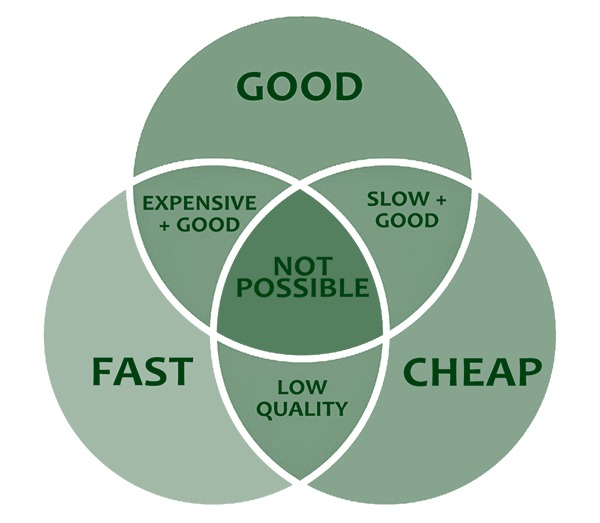
We all know that bad news sells and the media seems to love stories from dissatisfied customers when it comes to their insurance policies. We thought that providing some insight into what choices are out there would give some guidance to anyone considering taking out insurance or reviewing what they already have.
We are all able to purchase insurance online these days, without obtaining advice from an insurance adviser. We can buy insurance for funeral cover, life and trauma cover, car insurance and house and contents cover, all online or over the phone – but what are the pitfalls?
When we buy online or over the phone, effectively going direct and bypassing an expert insurance adviser, we are led to believe we are getting a good deal with cheaper premiums and can have cover put in place immediately, without having to complete application forms or provide medical information. This all sounds easy and very attractive to many however, we need to know what some of the traps are and how to avoid them.
- If we want the cheapest premium, we are potentially not getting the best policy. When we pay for insurance, although we don’t want a disaster to happen, if it does, we want to know that we are going to have our claim paid. If we’ve picked the cheapest policy with the worst policy wording, our expectations may not be met, and we could be very disappointed! Some companies have guaranteed policy wording which means they cannot make changes to the cover you have and make you worse off. On the other hand, other companies do not have that guarantee and can change their customers benefits without the customers approval for example, Southern Cross recently made changes to their covers for existing customers and not for the better.
- If we do not have to provide any medical history details upon application for personal cover, it is likely that any pre-existing conditions we have will be excluded for up to 2 years or permanently. The older we get, the more conditions we accumulate unfortunately, some major and some minor. If everything is excluded, the potential for a claim being accepted by the insurer becomes less likely
- When it comes to specialist types of cover, whether this be for personal covers, for business assets, liability cover, cover for shareholders and key people in a business, or maybe marine, aviation or carrier cover, going direct will just not ‘cut it’
- How do we know we’re getting the right amount of cover for the right reasons and at the right price? Insurance is about insuring the ‘big ticket’ items in life, those incidents that are going to cost us a lot financially. Surely we want to ensure that our policy has the best wording for such an event and that we have someone who is going to ‘fight our corner’ and look after us if a claim arises?
- This leads us on to explaining the role of the expert – the insurance adviser. They will of course initially have you sorted with the right policy, the right cover and with premiums that are affordable to you, however, it is when a claim arises that their other skills ‘kick-in’. They are there for you, supporting you, organising the paperwork, liaising with all parties involved and making everything as simple and understandable for you as possible – isn’t this what we really want when the problems crop up?! As well as experiencing claims processes ourselves first-hand we have dealt with many claims on behalf of clients, helping to manage and facilitate the process to help relieve the pressure at what is invariably an already highly stressful time.
If you really want peace of mind knowing that in an event you are covered, you need to engage a professional insurance expert. Insurance of any kind is about putting the right money, in the right hands at the right time – the insurance expert will know how to do this. The price of going direct, without expert advice, is not worth paying in our opinion!!
Article
by Charlene Overell, Authorised Financial Adviser
G3 Financial Freedom Ltd
SHARE THIS POST
Recent Market Volitility October 2018
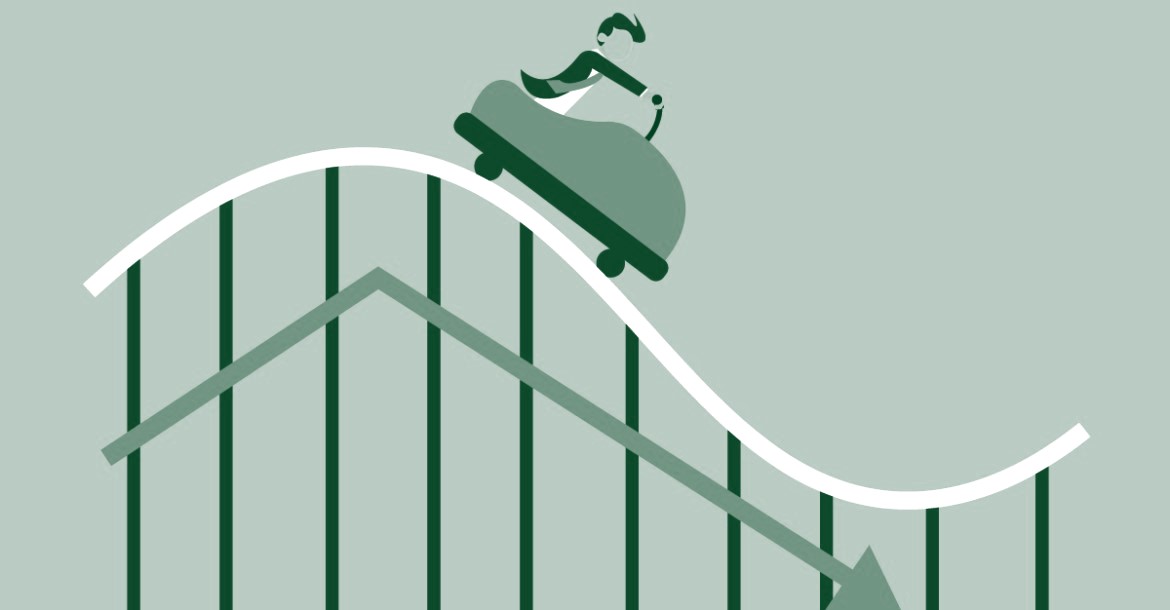
In the first three weeks of January 2018 alone the S&P 500 crossed ten new record closing highs in 13 days of trading. Then, in February, the index lost all its gains from 2018 in a few days. Over the next 7 months it built up gains again, and then lost all of them over the course of three weeks in October. What’s going on?
Let’s remind ourselves how markets work
Prices went down because someone was willing to buy at the discounted price. The buyer did not buy in order to lose money. The buyer bought because they felt that the discounted prices offered them enough return to justify the risk.
Markets bring optimists and pessimists together in equilibrium – they completely balance each other at a competitive price.
This is our shorthand way of saying at least half the market participants transacting in the last few days thought it was a good time to buy. Not everyone believes the sky is falling, even if the sensational headlines promote such a view.
But what about our investors?
For our clients with a 50/50 portfolio, we recommend a seven-year time horizon at a minimum, and most have a 20 or 30 year time horizon. In other words, any of our investors that are planning to spend money out of their portfolio this year or next year probably have that money sitting in bonds and cash, not in shares.
So, the portion of the portfolio suffering the most from this recent volatility is the portion that an investor has almost no chance of spending or using any time soon. That’s important, because it means that, whilst it’s not particularly comfortable to see volatility like this, it has little practical implication on their portfolio or current lifestyle. For most of our clients, we hope they’d look on this current situation with a level of disinterest.
For clients that are regularly purchasing assets in their portfolios or via KiwiSaver, this is actually a positive development, because they’ll be able to buy more shares with their same regular savings contribution and that will help grow their long-term wealth.
And let’s remember, when we signed up for shares, we accepted this would generally lead to more volatile returns. However, it’s volatility such as this that gives shares their wonderful return characteristics. Without temporary dips such as this most recent one, shares would have the returns of cash – which would not help us reach our financial goals.
The other point we need to make about the recent correction is that it’s not an unusual event. It is always extremely disappointing when markets go down, but as we’ve said many times, markets rarely go anywhere in a straight line. It is also the case that we cannot strive to achieve consistently higher returns than bank interest rates without assuming a higher risk that sometimes those returns will be lower than we would like; even negative.
The point is, what happened in the last quarter of 2018 is not new. It has happened before, and it will happen again. Having that knowledge is part of what makes a successful long-term strategic investor. It’s having an understanding and acceptance (at least a grudging one), that sometimes returns will be negative. We need to have this understanding, because otherwise our emotional response to difficult markets may prompt us to want to do the wrong thing at the wrong time. Quite often that can be far more damaging to a long-term investment plan than a temporary market correction.
We also need reminding because, as human beings, we are all prone to what is know as recency bias. We tend to overemphasise the most recent data and extrapolate that into the future (usually incorrectly) while at the same time undervaluing long-term trends.
Shares are volatile. The chart below shows the quarterly return of a 98% share portfolio. It goes up and down a lot; there’s no way around it.

The chart below, however, shows the growth of wealth this same portfolio has produced since 1991. While the volatility was uncomfortable, it produced large growth despite the Asian financial crisis, the tech wreck, the GFC and anything else you want to throw into the last 20 years or so.

The really critical point to remember in all this is the outcome that long term investors get to experience. It’s that share markets, on average, go up, and that consistent exposure to these markets is a key driver of long-term wealth creation. If there were no higher risk investment options available to us there would be no prospect of ever achieving a higher return.
In order to achieve higher long term expected returns and hopefully give yourself more retirement options you need to be exposed to a measured amount of higher investment risk consistent with your time horizon and your risk tolerance levels. Sound investment strategy doesn’t change just because market conditions do. Sound investment strategy includes a clear understanding and acceptance that changing market conditions are unavoidably part of the bargain in order to achieve your long-term goals.
We know the markets can be volatile in the short term, but this is already factored in to our long-term strategies. The worst decision investors can make is to react to short term volatility in a way that jeopardises the achievement of their long-term plans.
If you are still concerned, we want to talk to you. Give us a ring and let’s have a chat, so we can give you the confidence you need.
Source: Ben Brinkerhoff, Consilium
SHARE THIS POST
We Could All Learn Something From Jack Bogle

Jack Bogle, the legendary founder of Vanguard, passed away 16 January 2019 at age 89.
He may not be the most well-known investor but he’s had by far the biggest impact on the investing public.
Warren Buffett said it best in his 2016 annual report:
If a statue is ever erected to honor the person who has done the most for American investors, the hands-down choice should be Jack Bogle. For decades, Jack has urged investors to invest in ultra-low-cost index funds. In his crusade… Jack was frequently mocked by the investment management industry. Today, however, he has the satisfaction of knowing that he helped millions of investors realize far better returns on their savings than they otherwise would have earned. He is a hero to them and to me.
Here are some things I learned from this brilliant man:
Common sense is highly underrated. The Little Book of Common Sense Investing was the first book that completely changed the way I think about the world of finance (and beyond). Reading about his ideas on buy and hold, long-term thinking, simplicity, low costs, and how to view the stock market correctly was a light-bulb moment for me. Being included in the updated version is one of the highlights of my career. The name of this blog was inspired by this book and Bogle’s clear and concise thoughts about investing.
There’s no price you can put on principles. Nathan Most, the brilliant guy behind the idea to create the first ETF, approached Bogle about making it happen in the early-1990s. Bogle listened to his presentation and then told Most his idea had three or four design flaws, but even if he could fix them Vanguard wasn’t interested. Bogle didn’t want to attract short-term speculators to the firm. I love the fact that Bogle turned him down on principle alone, even though it could have bolstered Vanguard’s business at the time (they’ve since become quite successful in the space).
If you want to be heard to learn how to communicate effectively. Bogle’s books are chock-full of great ideas but the way in which he communicates those ideas is a big reason they’ve spread so far and wide. Each one of his books I’ve read contains a similar message but the way he communicates that message always resonates with me. It was the same thing any time I heard him give an interview. You basically knew what he was going to say but you still paid attention anyways because of how he said it.
Simple beats complex. For 12 years I worked in the endowments and foundations world of institutional investors. It took me a few years to figure it out, but this group was so focused on complex strategies, high-fee investments, peer performance, and short-term results that I was completely flummoxed by how that world operates.
Bogle helped me realize none of this made any sense. Not only did he explain the benefits of simplicity, but he also proved it using data to back up his arguments. He wrote, “Avoid complexity and rely on simplicity and parsimony, and your investments should flourish.”
Cost matters. This one is now obvious but there’s still an entire industry of people who are incentivized to avoid this principle. Bogle said, “Where returns are concerned, time is your friend. But where costs are concerned, time is your enemy.” He also said the following:
The way to wealth, I repeat one final time, is not only to capitalize on the magic of long-term compounding of returns, but to avoid the tyranny of long-term compounding of costs. Avoid the high-cost, high-turnover, opportunistic marketing modalities that characterize today’s financial services system. While the interests of Wall Street’s businesses are well served by the aphorism “Don’t just stand there—do something!,” the interests of Main Street’s investors are well served by an approach that is its diametrical opposite: “Don’t do something—just stand there!”
This is becoming harder and harder to do in the information age but keeping your trading activity in check is one of the most important aspects of a sound investment plan.
Perfect is the enemy of good. Bogle once wrote, “To repeat, while such an index-driven strategy may not be the best investment strategy ever devised, the number of investment strategies that are worse is infinite.” There will always be better strategies out there than simple indexing but your odds of choosing them in advance are slim and the odds of doing worse rises as you extend your time horizon.
Investing shouldn’t give you a rush. Bogle once said in an interview:
I look at indexing as being simple and, sad to say, boring. Be bored by the process but elated by the outcome. In Vegas, it’s the opposite. You’re elated by the process, by the moment, but you’re bored by the outcome because you know exactly what it’ll be. The more you bet, the more you lose. Investing shouldn’t give you a rush.
It’s hard to wrap your mind around the idea that boring is better but it’s true.
If you want a successful business you need to understand your customers. For many business owners and corporate management teams, the end user of their product or service is almost an after-thought. There are so many other details to cover — sales, marketing, HR, finance, compensation, quarterly results, etc. — that it becomes easy to forget why you created your product or service in the first place.
I always got the feeling Bogle truly cared about the investors who put their money with Vanguard and think that was a huge reason for their success. In his most recent book, he said he took 104 phone calls from terrified investors calling in during the Black Monday crash in 1987 and “periodically wandered through the ranks offering appreciation and optimism.”
How to think about the stock market. The idea of speculation versus investing is an important one and Bogle was constantly hammering this one home:
The expectations market is about speculation. The real market is about investing. The stock market, then, is a giant distraction to the business of investing.
That last quote on the business of investing is an all-timer and worth circling back to regularly.
Thinking long-term can lead to extraordinary results. Bogle rolled out the first index fund at one of the worst times in the past 50 years. It was a complete flop, bringing in just $11 million of a $150 million target. After its launch in 1976, index funds went on to trail 75% of actively managed funds from 1977-1982. He had to be extremely patient to get this idea off the ground. It took decades for Vanguard to become the behemoth it is today.
That patience has paid off to the tune of $5 trillion and counting in Vanguard’s coffers. Surprisingly, over 80% of Vanguard assets are in funds launched before 1997.
Long-term thinking is not only at the forefront of Vanguard’s business strategy, but Bogle’s investment strategy as well:
This is one of the most important rules of investing. If you never peek from the age of 20 to the age of 70, you’ll rip that first 401(k) statement open at age 70, and I recommend you have a doctor on hand because you’ll go into a dead faint. Your heart might even stop. You’re going to have an amount of money you can’t even imagine.
Saving is one of the most important investments you can make. Saving money and personal finance tend to get overlooked in the financial services industry because the markets are so much sexier and exciting. I love how Bogle always talked about the importance of saving money:
Everyone is looking for the Answer, and there really isn’t an answer except save. Save more. Invest for the long term, get cost out of the equation, and get diversified to the nth degree.
He also made the point that you have to invest in something, even in the face of irreducible uncertainty:
Well, you can only control what you can control. I think whatever your view of the world is, you have to invest. The alternative is – I mean, the only way to guarantee you will have nothing at retirement is to invest nothing along the way. So, you have to take your chances.
Money isn’t everything. Bogle died a wealthy man by any measure but he certainly left a lot of money on the table. It didn’t seem to bother him at all. The Bogleheads forum once wrote, “While some mutual fund founders chose to make billions, [Jack created Vanguard] to make a difference.”
Bogle wrote in his most recent book on the history of Vanguard, “Yes, mutualization was totally my idea, and I realized that a mutual company would never provide me with the personal fortune that so many denizens of Wall Street would earn. But it offered, I believed, my last, best chance to resume my career.”
Source:
https://awealthofcommonsense.com/2019/01/what-i-learned-from-jack-bogle/
Further Reading about Bogle’s ideas and principles:
The Little Book of Common Sense Investing
Stay The Course
This Man Will Make You Rich
SHARE THIS POST
The Importance Of Being Independent

Susan B Anthony, who led the fight for women’s suffrage in the United States, once said, “Independence is happiness”.
She was talking about the ability to choose – to choose your representatives in government, to set your own course as a free person.
The same is true today. The ability to independently choose without unnecessary constraint often leads to better and happier outcomes. Unfortunately, in the financial advisory industry, the ability to be independent and freely choose is often impeded.
As you may know, Australia’s banking, mortgage and insurance industry recently underwent a royal commission inquiry. Here in New Zealand we’ve followed this inquiry with great interest.
There have been a number of findings related to investment advice.
Vertical integration
Vertical integration is the combination, in one firm, of two or more stages of production; stages which are typically operated by separate firms. For example, if an adviser recommends a product owned by their employer, or recommends buying or selling a product where their employer gets paid to process the trade, they are vertically integrated.
The commission has found this behaviour to be rife in Australia, predominantly in major banks and institutions, and they’ve suggested it’s led to conflicted advice. For example, the Australian Securities and Investments Commission (ASIC) looked at ten vertically integrated advice offerings. They found that, while only 21% of the products on their respective approved products lists were manufactured in-house, these 21% of products received a whopping 75% of the money from new investors. You wouldn’t imagine this happens by chance. It’s more likely it happens because there is either pressure or inducement to put new money into investments manufactured in-house.
Fees for no service
Some organisations agree to purchase adviser businesses when the adviser retires. The clients are generally assigned to advisers within the new organisation, but some clients are ‘orphaned’. There were instances where an organisation had charged a client an advice fee where no service was being provided1, or even after they’d died2! To cap it off some organisations lied to regulators about the practice, because it was profitable3.
The commission has found other issues related to insurance and mortgage lending as well.
What does this mean for you?
We’re proud to tell you that we are a completely impartial firm, but what does that mean exactly?
It means that we are free to use practically any investment available to retail investors in New Zealand. It means that we only recommend those investments our research shows to be in our clients’ best interests. It is for this reason the investments we recommend are very low cost, in comparison to averages in New Zealand. The chart below shows the average cost of an allocation fund in New Zealand (data accessed from research firm Morningstar), compared to a 50% growth/50% income portfolio we recommend.


Perhaps now, more than ever, it’s clear why being impartial is so important.
When working with new clients, this can sometimes be seen as a disadvantage. This is because we don’t have the brand name and reputation of a large bank or institution. Who are we compared to them?
However, if we wanted to work for an institution such as a bank, we could. We don’t, though, because we want to be in a position where we can advocate for our clients’ best interests without any outside pressure. We want to be in a smaller business where we personally know our clients and, frankly, we know when one of them has passed away – there is no such thing as an orphaned client here! Being large isn’t necessarily an advantage in the advice business, because the advice business is, and will always be, a relationship business.
Although there have been lots of rumours about banks and larger corporates within the financial services industry, we prefer to ‘hang our hat’ on fact and focus on being committed to our business and our clients for the longer term. Change is opportunity and always provides a base for reviewing processes and systems, so we view any challenges in the industry worldwide as an opportunity to enhance the experience our clients receive from us. We are actively growing our business and have an independent, relationship driven business model, which we are proud of, with having the best interests of our clients at the core of everything we do.
We believe that greater adviser impartiality helps us provide perhaps the most important thing we can for our clients – their own financial independence.
- https://www.theguardian.com/australia-news/2018/apr/17/banking-royal-commission-amp-executive-says-company-put-profits-before-the-law
- https://www.theguardian.com/australia-news/2018/apr/19/commonwealth-bank-charged-fees-to-dead-clients-royal-commission-hears
- https://www.abc.net.au/news/2018-04-16/banking-royal-commission-financial-planners/9662166
SHARE THIS POST
Does your NZ family trust have UK tax obligations?

Does your NZ family trust have UK tax obligations?
If your family trust has a ‘UK tax connection’ the trust might now be obliged to register with H M Revenue and Customs (HMRC) in the UK. The UK has recently introduced a Trusts Register and there will be a significant number of New Zealand family trusts which will need to register. The following article by Martin Riley of Sterling Tax Services explains which family trusts might be affected.
The reason for the introduction of the Trusts Register in the UK is to ensure that the UK complies with the Common Reporting Standard which is the worldwide initiative to counter tax avoidance. All participating countries (including New Zealand) are now collecting information about taxpayers which will be exchanged between tax authorities in order to ensure that taxpayers receiving overseas income are correctly taxed on that income in their country of residence.
Although most trusts on the UK Trusts Register will be UK constituted trusts, there will be some New Zealand family trusts which will be obliged to register. These will, broadly speaking, fall into four categories:
1. Trusts which were established in New Zealand either before the settlor became resident here or within a period of 3 years after leaving the UK.
Many UK migrants will have established a family trust soon after arriving in New Zealand and these trusts could be subject to the UK inheritance tax (IHT) regime. If you established a family trust within 3 years of leaving the UK permanently, then you should seek advice.
Even if the trust was established after 3 years it may also be subject to the IHT regime if you are unable to show that you are no longer domiciled in the UK – and it should be noted that you can still be domiciled in the UK years after you have left the UK if you regularly visit and maintain a close connection with the UK.
It should be noted that IHT liabilities can arise (a) when the trust was established; (b) on a subsequent 10 year anniversary; or (c) when capital is withdrawn. In many cases the liability may be NIL but there is still a duty to report to HMRC. The obligation to register the trust only arises where there is a tax liability.
2. Trusts which have untaxed UK sourced income.
These trusts will have a UK tax liability on their UK sourced income.
3.Trusts which have UK interest and dividend income and a UK resident beneficiary.
Normally a New Zealand family trust with UK interest and dividend income would not be subject to UK tax on the interest/dividend income derived in the UK. However, this exemption does not apply where there is a UK resident beneficiary.
If you have set up a typical family trust with children and grandchildren as beneficiaries and one of your children/grandchildren is resident in the UK (either working in the UK or doing their ‘OE’) then this may trigger a UK tax liability if the trust is invested in a UK company. This will apply even where there is no distribution to the UK resident beneficiary.
Any trust with a diversified investment portfolio is likely to acquire some UK listed shares and this could trigger the obligation to (a) pay some UK tax; and (b) register the trust in the UK. Does your trust have UK listed shares or UK sourced interest?
4.Trusts which acquire UK listed shares (including UK investment trusts).
The purchase of UK listed shares triggers Stamp Duty Reserve Tax and this, in turn, triggers the obligation to register the trust in the UK. Therefore, it would be much easier from a tax compliance point of view if the trust’s investment adviser purchases shares in New Zealand or Australian unit trusts rather than investing directly into UK listed shares.
All of these tax issues are manageable – but some of them may be best avoided. We are urging all clients who think they might have an obligation to register their family trust in the UK to seek advice.
Martin is a chartered accountant and chartered tax adviser based in Christchurch who can be contacted on 03-374-3595 or via the website www.sterlingtax.co.nz.
G3 Financial Freedom provides investment solutions with Australian Unit Trusts and New Zealand Portfolio Investment Entities (PIE) and avoids UK Investment Trusts – this problem for UK IHT and registering a NZ Family Trust would therefore potentially not apply.
SHARE THIS POST
Learning from Johnny Depp

The 1980s television series “21 Jump Street” launched Johnny Depp’s acting career; “Edward Scissorhands,” director Tim Burton’s dark Gothic fairy tale, made him a movie star. But it was Disney’s “Pirates of the Caribbean” movies that made him rich. The original film and its sequels grossed about $4.5 billion in ticket sales. That franchise, along with other films, earned Depp an estimated $650 million, according to Rolling Stone.
If we are to believe the reports, most of it is gone.
Thus, we have yet another cautionary tale of what happens when too much money meets too little financial savvy. If it sounds familiar, well, that’s because it is. Lottery winners, pop performers, sports stars and other recipients of sudden wealth often fall into the same trap. They react emotionally to the windfall; they don’t think long-term or strategically. There is no plan for the future, only the unrealistic expectation that the firehose of earnings will last forever. These sorts of unforced errors leave a permanent mark on their emotional and financial well-being.
Depp is now suing his business manager and his firm for negligence, breach of fiduciary duty and fraud. I have no idea if the accusations have merit or not, but the mere existence of the lawsuit means financial mistakes were made and the suit will determine who made them. All of this could have been avoided, however, assuming one was willing to engage in some clear thinking and do a bit of work.
And so once again, I will lay out a simple set of rules that can help any recipient of new-found wealth avoid some of the most common errors, and maybe keep from going broke. Here goes:
1. Have a plan: I guess the mere fact that we are discussing a squandered $650 million fortune means I have to start with this one.
Anyone who comes into a pile of cash must think about ensuring it lasts a lifetime. Note this isn’t just about actors or athletes, but the 60 million people who stand on the precipice of a $30 trillion inter-generational wealth transfer. The beneficiaries and heirs of all that wealth need a plan to manage that money, even if it is in amounts somewhat shy of a half-billion dollars. Making whatever you have last as long as you need is the goal.
2. Delegate but be involved: Be aware of the details of your own finances. The most successful athletes and musicians have business managers who might handle the day-to-day chores while they are on the road working, but they must understand their own earnings, spending and investments. It’s your money, it’s your responsibility — if you do not know the specifics, then you are just asking for trouble. If Michael Jordan and Bruce Springsteen find time to be intimately involved in their personal finances, then you can too.
3. Understand your career cycle: We all begin as newbies, grow into our peak earnings years, then scale back the workload or retire. Those phases cover most of us. The first decade or so is when we become better, smarter, more skilled; the second phase is when we capitalize on those skills; the last is when we kick back. The mistake of assuming peak earning years will last much longer than they do is surprisingly common.
4. Friends and family entourage on the payroll: Buy Mum a modest house, if you’re so inclined, tell everyone you love them, then let them live their own lives. When they come around asking for financial help, politely sending them packing.
5. Avoid debt: Living within your means should get easier as earnings rise. Instead, people find more expensive ways to fritter away their cash. Access to credit all too often is the enabler of profligacy that can easily outstrip even multimillion-dollar salaries. It is one thing to use credit modestly to buy a home or manage cash flows, especially for someone who receives an annual bonus that makes up a substantial portion of total compensation; it is another thing to use debt to finance an ongoing lifestyle.
6. Keep your investments simple: This is especially important for anyone who is on the road or travels a lot for work. If you spend six months shooting a film in Malaysia, you probably lack the time to monitor how much risk your hedge-fund managers are putting on.
Better to keep it simple, hold down costs and limit tax liability. A portfolio of 60 percent stocks and 40 percent bonds will grow over the years with a minimum of volatility and headaches. Find an experienced pro other than your business manager — if you have one — to help manage this.
7. Understand what money is and what it isn’t: There is so much emotional baggage around money — especially the blind pursuit of it — that we often forget what it is. It isn’t a measuring stick or an end in itself but rather a means to an end. Money is a tool that lets you accomplish specific things, whether paying for good health care, ensuring financial security, freeing you from stress and worry, or covering the costs of leisure and philanthropy.
Depp would have been better served if he approached his money with the same gusto he applied to inhabiting his roles. That’s a lesson for all of us.
Source: https://www.bloomberg.com/view/articles/2018-06-29/how-to-avoid-going-broke-after-making-650-million
SHARE THIS POST
If you’re wondering why you’ve lost friends in adulthood, this is probably why

What a lot of people don’t appear to understand is that the single easiest way to make friends is to show up when it matters — and the single easiest way to lose friends is to, well, not.
That sounds obvious, but a pattern I’ve observed again and again among the people in my social circle (a social circle that skews young and urban, to be clear) is that they often don’t have close, meaningful friendships. They want them, but they aren’t willing to go out of their way to dedicate time and effort to developing these relationships.
Take this scenario. You met someone who seems really cool, and you immediately think you could be good friends. They invite you to hang out again — say, to have drinks with some of their friends you haven’t met. You say sure, you’ll be there. Then the day arrives. Maybe you’ve had a long week at work, or you’re just not in the mood to meet new people, or you have a few other invites for that night that look more fun. You text them, “Sorry, can’t make it tonight.” They tell you not to worry about it, they’ll see you next time. But days and then weeks and then months pass, and you never become more than acquaintances.
There’s nothing wrong with this scenario. You’re not going to be friends with everyone! You don’t have to be; that’s normal. But if you’re someone who wants to build deep friendships but consistently chooses to not show up when the opportunity is presented, then maybe it’s time to unpack why and to think about what you can do to change that.
The most extreme case of this phenomenon I’ve experienced happened when a distant acquaintance messaged me saying that she wanted to be friends. So we found a time to have dinner. She messaged me the day we were supposed to meet and said she couldn’t make it, and so we rescheduled for the next weekend. That happened six weekends in a row, and each time she bailed last minute. I saved six Saturday nights for this person, and she found reasons not to come to every single one.
What drives flakiness
Let’s talk about flakiness. In an increasingly connected, noisy world where infinite possibilities for how we could spend our time loom over us, flakiness abounds. I host a lot of events, and what I know now is that I should expect at least half of the people who explicitly RSVP’d “yes” to bail. It makes sense — the societal norms have changed, we’re busy, we have a lot of options for how to spend our time. But while a packed schedule explains why we can’t attend everything we’re invited to, I’m not sure it explains why we say we will and then … don’t
My theory is that flakiness is rooted in dishonesty with ourselves and others about what matters to us. It’s not that we’re malicious; it’s that we’re aspirational. And while that doesn’t negate the harm caused by flakiness, it might explain why it’s so common. At any given point in time, there are countless versions of our lives that we can see for ourselves, and we’re committed to maintaining that optionality. We could be a person who has that hobby or goes to that event or has that friend; we have that option, and we expect it’ll always be there.
But inevitably, we make choices, and slowly over time, the choices we have made, not the choices that we could make, are what, in the aggregate, decide who we are. When it comes to friends, it’s the relationships we’re invested in that count — not the relationships we could invest in if we ever made the time for them.
What defines a friendship? Can it be quantified? I’m inclined to think not, and yet I have a vague feeling after I’ve spent some amount of time or shared some number of experiences with someone that I can call them a friend. At some point, somewhere, a switch flips.
So then I have to think, what flips that switch in the other direction? How many canceled drinks and dinners and coffees does it take before we’re no longer friends with someone? How many big life events do we miss before we start saying we used to be friends? Probably fewer than we think. Flakiness has its costs, and we often don’t realize them until it’s too late.
Some steps on how to keep friendships going
With that in mind, now I have a few proposals for you, a person who seeks to build and sustain meaningful friendships:
1) Don’t be chill when it comes to making friends. Tell people you like or respect or value that they’re great and you want to hang out with them. If they signal that they’re not interested, that’s fine — but don’t miss the opportunity to get to know someone wonderful just because you don’t want to appear overly eager.
2) Be personal. Talk about your real problems, and ask people about theirs. Invite someone into your home instead of going to a bar or coffee shop. Give thoughtful gifts. A big part of friendship is understanding someone for who they are and having them understand you for who you are, and that’s not possible without some degree of vulnerability
3) Get comfortable saying no to people you don’t want to prioritize. That sounds harsh, but in the end, it will save your time and effort and theirs. It’s not a kindness to “perform” friendship without genuine support and commitment, and both of you have limited time to spend. Instead of saying you’ll grab lunch and then canceling yet again, you can just part ways and make friends who are better suited to each of you.
4) Remember to reciprocate. If your friend is always the initiator, invite them to do something with you. If you do have to cancel on someone — sometimes circumstances happen — you should be the one to make a plan for the future. And then make sure that it happens.
5) Show up for people who matter to you. Sometimes that means your physical presence; sometimes that just means your emotional support. There will always be reasons to not be there, but if you keep choosing other commitments over a friendship, that’s a signal to that person. Friendships aren’t static. They require work from both people.
None of my closest friendships were forged solely because we had so much in common or it was convenient. It was because we prioritized each other. When we had options — and there are always, always options — we chose each other more often than we didn’t. There have been times when people I didn’t think were close friends showed up for me when I didn’t expect it, and that’s what deepened our friendships.
It was in that vein that I developed a close-knit group of friends. When I met them, two of them had just ended long-term, serious relationships. A few of us were deeply conflicted about our jobs and our lives and whether our work would ever be fulfilling. There were days when someone would post in our group chat that everything was awful and terrible, and we’d organize immediately to cancel our plans and gather somewhere and listen to them vent over dinner and a bottle of wine. And that was everything — knowing we all had that support and knowing we had people who depended on us for that support.
These relationships are some of the most rewarding parts of my life, and they didn’t just happen. We built them. So the next time you’re faced with the question of whether to show up or not show up for someone, be conscious about how that choice impacts your relationship. Because, for better or worse, it will.
Source: link to this: https://www.vox.com/first-person/2018/8/16/17694356/how-to-make-friends-adulthood
SHARE THIS POST
You have to stop cancelling and rescheduling things. Really.

A friend recently returned to his parked car to find it had been sideswiped. Now, every time he calls the insurance company, he hears a message saying: “Can’t take your call right now. Leave a message. All calls will be returned by the end of the day.”
So far, he’s called over a dozen times; his calls have been returned only twice.
Why would an insurance adjuster have a voicemail message assuring callers that “all calls will be returned by the end of the day” and then return only 20% of the calls it committed to returning? Probably for the same reasons most of us promise “to write back to your email on Monday” but don’t, or promise “to send out that memo by Friday” but don’t.
Why do any of us say we will do things and then fail to do them?
We overcommit ourselves. We don’t like to disappoint people, so we tell them what we think they want to hear. We feel pressure in the moment and don’t stop to consider how much pressure we’ll feel later. We don’t think through how much time things will actually take — and we don’t leave enough slack time in our days to handle the (inevitable) emergencies and delays.
Up until a few years ago, I canceled or postponed meetings a lot. I would say yes to something (so much easier than saying no). As the commitment approached, I would feel overwhelmed and want to cancel. And often, I would cancel.
Then I read Stephen M.R. Covey’s book The Speed of Trust. It’s about being trustworthy. I had always thought that I was, but the author explains that when you make appointments and you cancel them, then trustworthy you aren’t. When you fail to fulfill commitments that you freely make, trust is not the result.
Since then I have realized that the temptation not to follow through is compounded by ease. Never has canceling, for example, been easier and less painful for us than it is in the age of the text message. We can cancel without ever having to speak with, much less meet, someone. We can cancel five minutes ahead and without explanation. Just tack on an emoticon to our message, and we can convince ourselves that it’s almost the same as if we’d met our obligation.
But the thought process still isn’t pain-free. We feel guilty about it. We waffle over what to do — and the indecision is draining. Finally, we cancel, and we undermine our confidence in ourselves. It reinforces our conviction that we can’t do it all — that we can’t control our schedule, or even our effort.
There are consequences for our personal lives, and there are certainly consequences in the workplace. Keeping commitments is a sign of maturity. Employees who don’t finish assignments, for instance, or finish them late or poorly, or are themselves routinely late, miss meetings, and cancel appointments, are an imposition on other team members and a liability to their employers.
Because these bad habits are nearly ubiquitous, they inevitably hitch a ride with some of us as we climb the ladder into leadership roles, where the workplace dysfunction they generate is magnified. It’s difficult to hold your subordinates accountable when you don’t hold yourself accountable. It’s hard to trust others when we know we can’t be counted on. How do we inspire commitment in those we lead when it’s obvious to them that commitment is a negotiable principle for us? It’s impossible to be a good leader if we don’t govern ourselves.
Last year I decided I would stop rescheduling my commitments and treat them as just that: commitments. And what I found is that when I committed to do the things I said I’d do, I actually felt much less stressed by them. As I kept more and more commitments, I got more and more confident. And I learned how long things really take, so I got better and better at giving estimates on when I could deliver.
If you really mean no when you say yes, then say no in the first place. We are all in the same boat — we have finite time and a seemingly infinite number of worthwhile things to do with it. Don’t know how to say no? Google “how to say no to a request” and then study up. Commit yourself to not agreeing to do things unless you’re going to follow through. Ask for time to think things over if you’re unsure. Don’t overschedule yourself. If you’re truly overextended, you may require a transition period to weed some things out; after that, once you say yes to something, stick to the yes. If the commitment seemed like a good idea at the time, it still is — even if the value is found not in the activity itself but in being trustworthy and following through.
Source: https://hbr.org/2018/09/you-have-to-stop-canceling-and-rescheduling-things-really
SHARE THIS POST
Wine Lovers Guide To Investing

Savouring a vintage wine is one of life’s great pleasures. But often overlooked in the joy of consumption is the carefully calibrated journey from grape to glass. Similar levels of care are critical to good investment outcomes.
A host of variables can determine whether a wine is great, good, mediocre or undrinkable. These include the quality of the grapes, the soil, the position of the vineyard, the weather, the irrigation and the timing of the harvest.
And picking the grapes isn’t the end of it. The harvest must be sorted, the grapes crushed and pressed, then fermented, clarified, aged and bottled. At any stage of the process, a lack of attention to detail can spoil the final outcome.
As in winemaking, investment management requires attention to detail—researching and identifying the dimensions of expected returns, designing strategies to capture the desired premiums, building diversified portfolios and implementing efficiently.
Just as winemakers don’t have any say over the weather, investment managers can’t control the markets. Not every harvest will produce an excellent vintage, but expert professionals can still maximise their chances of success by putting their greatest efforts into things they can influence.
For winemakers that may be taking extreme care in picking the grapes at a time that delivers the desired balance of acidity and sweetness. For investment managers, it can mean precisely targeting the desired premiums while ensuring sufficient diversification to lessen idiosyncratic risk in the portfolio.
Winemaking is as much an art as a science. While fermentation comes naturally, the winemaker must still guide the process, using a variety of techniques to ensure the wine is as close as possible in style and flavour to what he is seeking to achieve.
Similarly, in investment, real world frictions mean that basing one’s approach purely on a theoretical model is unlikely to be successful. For instance, trade-offs must continually be made between the expected benefits of buying particular securities and the expected costs of the transactions. Managing the effects of momentum and being mindful of tax considerations are among the other issues to be balanced.
Just as in viticulture, investment outcomes can also be affected by any number of external events—such as the imposition of capital controls in an emerging market, or changes in regulation, a severe financial crisis, or a major geopolitical event.
Dealing with uncertainty and navigating the “unknown unknowns” are part of the job. So investment managers must build into their processes a level of resilience, through diversification for instance, so they have sufficient flexibility to work around unforeseen events.
Ultimately, the benefits of discipline and attention to detail are easy to overlook. Great ideas count for a lot, of course. But great ideas, without efficient implementation can mean even the best grapes in the world go to waste.
Source: Jim Parker, Vice President, DFA Australia Limited Win
SHARE THIS POST
7 Keys to a successful transition to retirement

1. Have a positive attitude towards your future
If you have the ability to ‘roll with the punches’, you will be able to dictate how you approach most areas of your life. There are changes that you can expect in retirement which are both positive and challenging and for many, the retirement years will see various ongoing transitions too. Seeing yourself change is a challenge, however, forgetting your age and focussing on your ability, passions and drive to continue to achieve things in life, whatever your age, can keep you strong and loving life.
2. Have a clear vision of this next phase of your life
The foundation of a successful transition is to have a clear idea of the destination that you have – that is the difference between a ‘wish’ and a ‘goal’. Also, you want to be clear about the values that will guide your life in the future because that understanding will let you devote more time to the things in life that are important to you.
3. Understand and practice healthy aging principles
Your life enjoyment of your new life will be influenced by how you feel. In fact, the life transitions that you will go through will likely be driven by changes in your health. Healthy aging is both mental and physical – keeping your mind and your body as fit as you can will go a long way towards creating the quality of life you want.
4. Consider the work opportunities that fit your life
Your work is the thing that you do to contribute your experience, skills, time and knowledge to society in some way. It is also a way to create positive stress in your life. Even when you leave the traditional workplace, you may still have a need to share your strengths and transfer your skills to others. Work doesn’t have to be full-time or paid for, and it doesn’t have to be something that you don’t like to do. Remember the saying “if you love what you do, you never have work again!”. Many retirees use their skills for the greater good, by volunteering with organisations and causes they have a passion for, and now have more time for too.
5. Develop and strengthen your family and social support network
In your retirement, you will depend on your family and friends to nurture and support you through all of your life stages. Not only are your personal and family relationships important to your happiness, but the depth of your social network will also play a key role. Remember that many of your fulfilling activities will likely come from your involvement with family and friends.
6. Take a balanced approach to leisure
The enjoyment that you get out of life will in most part come from how you spend your time. Leisure can be many different things to you. As you think about your retirement, you want to ensure that you are taking advantage of all of the things that you could do to truly live a fulfilling life. There is a big difference between ‘time filling’ and ‘fulfilling’ activities. Every day doesn’t have to be filled with meaningful pursuits. Successful retirees keep themselves more engaged and involved in activities they find stimulating.
7. Maintaining financial comfort
Some people feel that a happy retirement is guaranteed by financial security. There is no price however, on a successful retirement. Financial comfort refers to being able to manage your life in a satisfying and fulfilling way, using the financial resources that you have. If financial discomfort contributes to retirement stress, then your financial plan becomes a negative rather than a positive experience. The keys to achieving financial comfort are to have a clear understanding of the financial resources that you have and the demands on your money that will come from the life you lead, now and in the future. One option to consider your own situation, would be to think about what you have for the ‘essentials’ in life, which pay for your basic needs and fixed costs, what you have for your ‘lifestyle’ choices – the fun things in life you would like to do in retirement, and finally, any ‘nest egg’, which is for emergencies in challenging times and any legacy you may wish to ultimately leave.
Source: Barry LaValley, Retirement Lifestyle Center / Charlene Overell, G3 Financial Freedom
SHARE THIS POST
So why do I need Enduring Powers of Attorney?

Many New Zealanders don’t have a Will in place, and of those that do, we find fewer have established Enduring Powers of Attorney. These are vital to support our loved ones in a crisis, when they are unable to act for themselves through injury, illness, or maybe just being overseas and needing someone they trust to sign documents on their behalf.
The Brown Family
Charlie and Carol are in their mid-50s and have two children – Jake age 22 and Rebecca age 20. Jake and Rebecca are taking time out from their study to travel overseas together for 3-4 months, to see a bit of the world before returning to further study and work. Whilst in Europe, Jake has a serious accident and is hospitalised. Through Rebecca, Charlie and Carol find out Jake is unconscious, with traumatic internal injuries as well as broken bones. The doctors in the hospital are wanting to talk with an adult who has legal power to speak on Jake’s behalf, as they have treatment options they wish to discuss so decisions about ‘what next’ for Jake can be made. Jake is an adult and has not established any power of attorney to appoint anyone to do this ‘talking’ for him, about what he would want to happen for himself. Through a lot of emotional angst, Charlie and Carol find out from their lawyer that they have to apply to the courts to have them appointed as Jake’s attorney, which costs money and takes time – both of which they do not have in abundance.
As parents, no-one wants to hear of such an accident with our children, let alone go through the stress and delays of having to apply to the courts to obtain a power of attorney, before being able to agree a treatment plan with medical staff.
A simple solution is to ensure anyone over the age of 18, who may be in a position of needing someone to act on their behalf, to establish Enduring Powers of Attorney – one to delegate signing powers over bank accounts and other property matters, and another to assist with care and welfare decisions in the event of medical support being needed.
Jack and Vera White
Jack and Vera have recently retired and are enjoying life together. They travel, see family, volunteer for local organisations they are passionate about and socialise regularly with friends. They both own their home jointly and have a joint bank account too. Jack inherited some money a few years back from when his mother died, and he has this invested in a portfolio of shares and bonds in his own name. Vera has some cash in the bank in her own name, a legacy of savings she built up herself during her working life. They do receive the New Zealand State Superannuation however, they use money from Jack’s investment portfolio to top-up their lifestyle expenses, so Jack dips into this when they need it.
During a sunny day gardening together, Jack unfortunately suffered a stroke and lost the use of the right side of his body. Jack is right handed.
Jack is unable to sign anything and he may never recover sufficiently to do this with his right hand.
In the meantime however, they need to access money from Jack’s investment to help with this treatment, and to continue to top-up other expenses they incur. Jack and Vera never established Enduring Powers of Attorney, so Vera is unable to access any of the money in Jack’s portfolio to support their financial needs. Vera now has to visit their lawyer who will arrange to apply to the courts to try to have Vera appointed as Jack’s power of attorney – this takes time and money!
Conclusion
Enduring Powers of Attorney are for every adult, for many unfortunate situations. There are two types – one for Property and one for Care & Welfare; both are needed.
It is important that you consider the costs, time and stress involved in NOT having these in place and organise them sooner rather than later – protecting yourself and your family is such a worthwhile thing to do NOW.
Charlene Overell, G3 Financial Freedom Ltd
SHARE THIS POST
10 Tips for empowering children to be money smart

- Encourage your children to work for their pocket money. When they are old enough, possibly around fourteen, encourage them to work for someone other than you. This gives them a taste of the real world
- Teach your kids to budget. The Sorted website is very useful for this – learning about income, expenses and creating surplus income from an early age will stand them in good stead for their future
- If your children like to spend, say on clothes and personal items – things they want rather than need, consider giving them an allowance each month so that pretty much all their ‘wants’ can come from this. Once it’s gone, it’s gone. Things that are needed, such as school uniforms, shoes, books and trips can of course be bought by parents, but treats, they can be funded from the child’s own allowance
- Consider setting up a ‘3 pots of money’ system with their earnings or pocket money. One pot is for their own saving, another is for their own spending and the third could be a ‘family treat’ pot, where everyone contributes and can benefit from a family day out, a special meal – any treat for those who participate and save for it Encourage your children to save at least 10% of everything they earn, more if possible whilst they are young and living at home
- Inform your children that if they wish to go to University or experience a student exchange, you will expect some effort from them. This could mean that they save a portion of their money towards this or being clear that that they are expected to work part time while they study. Let’s face it, many of us parents study whilst working full time, running a business and home life
- Sign your children up for KiwiSaver when they start work and encourage them to contribute to this. This can be done via their employer and they can manually contribute. This is especially important when they reach 18 as they then start to receive the government tax credit which is $521 p.a. for every $1,042 p.a. contributed.
- Don’t buy your children designer labels or treats to show them you love them. Spend quality time with them instead and start teaching them about the value of money in conversations. Tell them how mortgages and loans work, what interest rates for savings and debt mean, how debit and credit cards work, what bills are part of our household, the cost of utilities and a shopping basket of food. Talk about how many hours are needed to be worked at $x per hour to pay for those things. Teach them to sew or look for bargains through ‘op shopping’
- Don’t lend your kids money without a plan for repayment. All you are doing is teaching them how to accrue debt. Ideally, they need to have earned and saved the money before spending it however, sometimes they need help with buying their first car. Agree a monthly repayment plan and stick to it. Ensure they buy the fuel, pay for the insurance and their AA cover too. It will mean more to them if they’ve used their own hard earned
- When your kids start working fulltime and still live at home, charge them board. It doesn’t have to be a lot but it does need to be something. They will be paying for rent or mortgage or at some stage when they move out, unless you still really want them living at home at thirty?!!
- Encourage your children to purchase household items for when they are ready to leave the nest. When I was young we called it preparing your glory box and it was something only girls did. I have no idea why it was called a glory box and nor do I have the faintest idea why boys weren’t encouraged to do the same! Ridiculous!
Finally, one of the best investments you could make in your child’s life when they get to the stage of needing financial support, is to buy them a few hours of time with an expert financial planner. Getting them on the right track with their mindset around money early in life will empower them greatly as they get older.
By Charlene Overell – G3 Financial Freedom Ltd
SHARE THIS POST
Picking Winners

The media locks in on a particular ‘hot’ sector.
In the late 1990s, it was technology. In the mid-2000s it was mining. Writing about fashional sectors is one thing. Building sustainable investment strategies around them is another. Finance journalists tend to write lots of articles about particular industries or sectors because these stories fit into a current narrative. In the tech stock boom, it was the information revolution. In the mining boom, it was the rise of China.
Of course, the changes in the global economy brought about by innovations in digital technology and communication is a real story, as is the impact of China due to its rapid industrialisation and global integration of the past 15 years.
The big question for investors is what information about those trends can you act on that is not already reflected in share prices? Too often, people end up trying to jump on a train that has already left the station.
In the Australian share market, for instance, mining stocks boomed last decade amid voracious demand for coking coal and iron ore from steelmakers in China, the world’s largest producer and consumer of steel.1
The performance of stocks like Fortescue Metals Group mirrored what was going on in commodity markets. From mid-2003 to mid-2011, the Reserve Bank of Australia’s index of commodity prices roughly quadrupled in value. (Chart 1)
By 2012, new iron ore supply was coming online just as China’s expansion started to slow and steelmakers’ demand moderated. Spot iron ore prices fell by nearly 80% from a record $US180 a tonne in 2011 to around $40 by late 2015. (Chart 2)
The market prices of mining stocks followed suit. On the Australian market over the four years from 2012-2015, many of the worst performing stocks were either iron ore miners or companies that serviced that market.
While iron prices recovered a little since then to near $80 as at March 2017, bringing mining stocks with them, many of these stocks still lagged the wider market’s performance over the past six years. (See Table 1)
This story is a powerful argument for the virtues of diversification. The more concentrated the portfolio, the more it is exposed to these idiosyncratic events beyond the control of an individual investor. Diversification involves spreading risk and diluting the influence of sector-specific themes. Just as materials stocks struggled from 2012-15, other sectors such as healthcare and telecoms and financials did well. Resources bounced back in 2016, while healthcare, telecoms and financials lagged.
The fact is that trying to forecast the best performing sector or industry from year to year is a mug’s game. Observing that commodity prices are rising again is not useful information for you as an investor because that’s already reflected in the market.
But diversification does not just apply to sectors. We can also manage it by using all the information about expected returns that is available to us. Academic research has identified certain dimensions that point to differences in expected returns. To meet this definition, they must be shown to be sensible, persistent across different periods, pervasive across markets and capable of being cost-effectively captured.
The four dimensions are the degree to which the portfolio is exposed to stocks versus bonds, to small companies versus large companies, to low relative price stocks versus high relative price and to high versus low profitability firms.
In the small cap end of the Australian market, we can manage company specific idiosyncratic risk by holding a well-diversified portfolio. Furthermore, we can improve expected returns by overweighting stocks with higher profitability.
Of course, this does not mean a portfolio will be completely immunised against idiosyncratic risk. But it is a way of diluting those influences and ensuring a balance between improving expected returns and achieving appropriate diversification.
So, we’ve learnt that chasing ‘hot’ sectors and industries is a good way of getting your fingers burnt. But through diversification, discipline and maintaining a level of flexibility, we can help ensure that a single sector doesn’t have a disproportionate influence on your investment outcome.
Jim Parker – Dimensional Vice President, Outside the Flags May 9, 2017
SHARE THIS POST
Pension Flexibility at 55

In 2015 the UK government introduced a rule that anyone with a UK personal pension could access their whole fund at age 55 – this is known as ‘pension flexibility’. Prior to this, only a 25% tax free lump sum could have been taken and the balance of the fund had to provide some form of income, either by way of purchasing an annuity or taking drawdowns from the fund. The 2015 legislation means that 100% can now be withdrawn as a lump sum. However, 75% of it is taxable at the member’s marginal rate.
Those of us providing expert advice on the pros and cons of transferring UK pensions, have been patiently waiting since then for this rule apply to Recognised Overseas Pensions Schemes (ROPS), where UK pension fund money has already been transferred to a ROPS.
On 9th March 2017, the UK Chancellor announced this rule can now apply to ROPS and so providers and advisers have been gearing up to provide the advice clients need.
So, what does this mean for anyone with a ROPS who is aged 55 and over?
It means that we can now look to potentially withdraw your total ROPS fund. There are a few caveats to this of course, so we will attempt to explain the detail.
Up until now, anyone with UK pension funds in a ROPS, has been able to take between 25%-30% of their fund at age 55, with the balance having to provide an ‘income for life’ – like the old UK rules before 2015.
For clients who have already transferred their UK pension funds to a ROPS, we can now check if the ROPS provider has amended the Superannuation Scheme Trust Deed, to allow full access to the member’s fund from age 55. Some have amended their Deed whilst others have set up a new ROPS, to allow this ‘pension flexibility’ option.
The ROPS may have penalties for withdrawing the whole fund at age 55, particularly if the transferred funds have only just arrived from the UK, and this is understandable. It takes a lot of time, effort and expertise to set-up, run and monitor a ROPS from a provider’s perspective. It is therefore not fair if a client were to use the provider’s scheme just as a conduit to transfer their UK pension funds to the scheme, only to immediately cash it in, when there is a lot of administration, costs and compliance involved. Penalties differ between providers and so it is important that these are considered.
It does mean however, that for those over age 55 access to the whole fund will allow the release of funds previously tied in for life, to be used for other retirement planning goals and to help reduce a layer of costs that are part of the ROPS process.
Encashing your UK Pension at age 55 – instead of transferring to a ROPS
One area of advice we provide, is to consider whether someone who is already aged 55 and over would be best to encash their UK pension whilst it is still in the UK, rather than transfer to a ROPS.
The advice is purely on a client by client basis as everyone’s circumstances are different. However, from a general perspective, if the client is a non-UK tax resident and is living and residing here in New Zealand for example, it is important to weigh up the process of encashing the pension in the UK, potentially paying any emergency tax (40%) on the 75% balance of the fund (after the 25% tax free lump sum), and then reclaim or offsett the tax paid against any tax liability due here.
With this process, the money is no longer in a pension product so the cash balance can provide flexibility going forward depending on the individual’s circumstances
If a transfer were to proceed without this advice, the client would potentially be setting up a ROPS here in New Zealand, paying some advisers up to 5% of the transfer value for just organising the transfer (some without advice I might add!) and paying fees associated with the ROPS product.
The client’s tax position also needs to be taken in consideration. For example, if they are a transitional resident in New Zealand for tax purposes, there would be no tax to pay in New Zealand on worldwide income for their first 4 years of residing in NZ. Criteria applies to meeting the transitional residency test which I won’t go into here, however, advice on encashing or transfer during or after this 4 year period is very worthwhile obtaining.
Important Points
- It is vital that anyone, especially those 55 years and over, with a UK pension still in the UKor anyone with a ROPS which has been established from a previous pension transfer, seek independent advice. Ideally your personal financial situation should be taken in consideration and advice tailored to what is in your longer term best interest sought
- Remember, the pension ‘pot’ was established to help build wealth for your retirement years, to provide a passive income when you choose to stop earning through work. If the ‘pot’ is encashed and spent, nothing will be left to support the retirement years and you will need to ask yourself “how am I going to replace what I have just spent, especially now I am getting closer to those retirement years?”
- When it is in a client’s best interest to fully encash the pension from age 55 onwards, we encourage our clients to still ‘earmark’ the funds as their retirement ‘pot’ and reinvest the money. Reinvesting it just means placing the funds into an appropriate investment portfolio (that may match what they had in the ROPS), but outside of the ROPS product itself. This means the money is no-longer subject to UK HMRC legislation and is no longer a Superannuation fund here in NZ, saving on fees and protecting it from any future legislation rulings – it is now a totally separate investment fund
- Of course, some clients may wish to use some of the encashed funds to repay mortgages early and this may be best advice. If the client is still working however, the advantages and disadvantages need to be considered. Perhaps redirecting the monthly mortgage payments that are no longer needed, to a regular savings plan would be a smart move to continue to build wealth
This new ‘pension flexibility’ rule does NOT mean that one size fits all and every angle needs to be considered. It is important to understand your choices and learn whatever is going to be in your best interest. Therefore, although we are bias of course, we believe professional independent financial planning advice is crucial, so that you can make an informed decision having been presented with all the facts and options.
Please do be prepared to pay for this expert advice. Just like we engage medical specialists, architects, engineers, lawyers, accountants and any business whose services we require, quality impartial financial planning and UK pension advice should be paid for too.
Charlene Overell – G3 Financial Freedom Ltd
SHARE THIS POST
Don’t Get Beaten Up!

Everyone wants to beat the market, but the fact is most people who set out to do so end up getting beaten up by the market. Even one of the world’s most famous hedge fund managers reckons the best advice for most people is to diversify, across asset classes, within asset classes and across markets, countries and currencies.
Tony Robbins talks about his new book “Unshakeable” where he interviewed some of the most brilliant investment minds to uncover how best to invest in the markets. Check out this article in Business Insider Australia:Click here
SHARE THIS POST
Ten Misconceptions about Retirement

Transitioning to retirement is not just about ensuring we have enough money to last, understanding the emotions we’ll experience and being prepared with the right mindset and behaviours are arguably just as important. For many, their jobs and careers define who they are. When they stop work what is left? The stress of the unknown creeps in – who are they? what do they do? do they add value to anyone anymore? Check out these misconceptions and take action to being prepared
- Retirement is a destination rather than a transition. Many New Zealanders are clear about what they are retiring from, but not clear about what they are retiring to. They often feel that retirement is this new life phase that is an extended holiday or a 30-year-long weekend.
- Retirement could be the longest single phase of your life. People believe retirement is a new life, the Third Age. In fact, you will go through six to eight distinct phases in your retirement, driven by either your health or the health of those you care about (spouse or partner). It is a multi-phase journey. Also, remember that time isn’t always your friend—getting older means doing as much as you can as quickly as you can. (Never put anything off!)
- Retirement happiness is directly tied to how much money you have. In fact, good health is probably the biggest key to a successful retirement. Happiness in retirement is a function of having a positive outlook, engagement in life, nurturing relationships, life meaning and a sense of accomplishment.
- Retirement spending will be the same throughout retirement . Some tend to spend like “drunken sailors” in the first few years of retirement before settling into a pattern. As time goes forward, spending tends to move more to family and health. Travel patterns tend to move toward less stressful travel and almost no travel in later years.
- Three hundred rounds of golf a year are always a good thing (if you like to golf). In retirement, as in all phases of life, too much of a good thing is often too much of a good thing.
- A life full of leisure must also be a good thing. We like our holidays and weekends when we are working, so imagine if that were now our lives. Consider the paradox of leisure: we like leisure because it is a break from work. If we had leisure seven days a week for 30 years, where is the break?
- Retirement is a ‘couples’ issue. In fact, it is more likely to be a single woman’s issue. The average age that a woman first becomes a widow in Canada, the US and Australia(if she is going to be a widow) is 59. Sixty per cent of Kiwi women over age 65 are single, widowed or divorced.
- The goal of financial planning for retirement is to “reach your number.” There are issues that you will have to deal with during retirement such as income, tax and estate. Financial planning doesn’t stop at retirement. Just because you have financial security doesn’t guarantee retirement success. You still have relationship problems, health issues, happiness and sadness.
- You can put things off in retirement. In fact, you want to do as much as you can as quickly as you can. You never put anything off in retirement. Do it now and hope that you can do it for 30-plus years!
- Retirement is a time to do new things. It is, but as we age we actually have increased difficulty doing new things. Remember that you are who you are and that generally if you didn’t do something before retirement, you will be less likely to do it after retirement. Since the retired “you” is no different than the working “you,” ask yourself whether you are comfortable doing new things now. If not, you will have to create the positive strategies to do new things rather than assuming that time is the only variable.
Source: Barry LaValley, Retirement Lifestyle Center
SHARE THIS POST
Investors Beware!
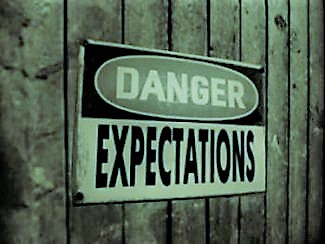
How many times do investors think that they or their advisers know which funds or stocks to pick and when to pick them? This is known as the active approach to investing however, it doesn’t work over the longer term. Why pay unnecessary fees for ‘active’ when they don’t add value? Check out this proof showing how many of these active funds have been outperformed by benchmarks. Click here
SHARE THIS POST
How to avoid money problems in our middle years

Spending more money than we earn
It is often during our middle years, that we are nearing, or are at, our highest earning ability where we bring in more money to the household and feel we have the freedom to enjoy our hard-earned cash, spending more on travel, newer vehicles, a boat and a bigger home to accommodate a growing family. It’s important not to be caught by instant gratification and take a step back to think before we buy. For a 40 year old who can save an extra $400 per month and have this invested into a good quality investment portfolio, this could grow to around $300,000 by the time they retire, based upon a return of approximately 7% p.a.
Not taking care of the emergencies
When we are young, in our 20’s and single, a few thousand dollars was able to pay for the financial ‘curve balls’ that came our way. With a family and more responsibility on our shoulders, we need to adjust our emergency fund and look to have around 6 months’ expenditure at least, tucked away in a bank cash account, that is readily accessible for unforeseen ad-hoc expenses. Emergency funds also help fund any excesses on personal medical cover and home and contents cover, helping to keep these premiums affordable
Using the mortgage account as a bank account
As the value of our homes increase, instead of using credit cards or personal loans (in themselves not a great idea) there is a temptation to top-up our mortgage when we want money for other things such as a family holiday, buy a new car or even leverage it to buy an investment property. Short term gratification of cars and travel are effectively spending tomorrow’s dollars today, so although it may seem to make sense to make use of the low mortgage interest rates, all we are doing is increasing our debt. Leveraging to buy an investment property may be gearing to buy a growth asset, however, whatever the money is being used for, other implications come into play, such as do we have enough life, trauma and disability income insurance to cover the increased repayments if we are unable to work due to illness or injury or if we die prematurely – leaving our young family with such a financial catastrophe will add stress, anxiety and potentially repossession of the family home. Just don’t do it, unless you have all the ‘what ifs’ covered.
Not taking the value your home and contents seriously
Many people sigh when the renewal of the house and contents insurance comes around, wishing the premiums hadn’t increased. The tendency is to just pay whatever is due without giving a second thought to the actual value of our personal belongings or the structure of our home, should we lose everything in a fire, flood or as is common in New Zealand, an earthquake. If you take the time to consider what it would cost to replace everything you own – your furniture, clothes, kitchen equipment, computers, paintings and picture frames, everything in our garages and workshops, valuable heirlooms and jewelry, most of us would not have enough cover in place. To add to that, should we lose our home to an earthquake and need to rebuild, the cost of not only rebuilding the property is needed, but the clearing of the site, rebuilding any retaining walls, and looking at the costs involved by the construction company to access your property is wise too. Getting a structural valuation every few years to check on the rebuild costs is worth it, as if you think about it, paying what is effectively a small cost each year to receive hundreds of thousands of dollars in insurance cover, is great peace of mind and enables us to sleep well at night knowing we will always have a home for our family.
Expecting the government to support us in old age
We are fortunate in New Zealand, to have a government superannuation fund however, it will not provide enough for most of us to live in retirement, especially not covering the luxuries of life. KiwiSaver has been great to get into the habit of investing for our futures, however, for most of us in our middle years now, what will be available when we retire, will just not ‘cut it’. Albert Einstein was reported to have said that “compound interest is the eighth wonder of the world” so making our money grow and work for us, needs to be one of our financial planning goals in our middle years. Paying ourselves first is one way to look at trying to budget well, to try to create surplus over our income versus expenses and investing this money in robust investment portfolios, where dividends and interest are reinvested for growth. Starting now means we have a good 15-25 years ahead of us before we need to access the money for a passive income in retirement. The question is whether we want to be in control of our financial future and live the life we choose, or be at the mercy of whatever government support is available at the time (if any) and just exist financially.
Spending our retirement funds on the kids
This is more common these days, when we find most of our children wishing to go to university and as they get a little older, wanting financial assistance to buy a house. Our children have a long time horizon to build their own financial futures and repay student loans, so we must not neglect our own retirement needs for theirs, as it will be much more difficult to make up any money we have gifted away and be harder to catch-up. We must factor these goals into our own retirement planning goals and ensure we take our own futures seriously and not feel guilty about putting ourselves first in this regard.
Putting all our eggs in one basket
Of course, we’ve heard this before – another phrase for diversification. Owning a broad spectrum of growth and defensive assets is much less risky and likely to produce more consistent returns over the longer, especially if we diversify in assets worldwide. Owning 3 finance company stocks, or owning one or two rental properties solely (which is based in one city and in one country) is not diversification!
Don’t panic when share markets fall
Seeing our investment portfolio and funds in KiwiSaver fall, gives some of us an empty feeling and we panic about what to do. It is important to effectively do nothing! Once invested in a good quality robust portfolio, staying disciplined is the key – jumping in and out of shares and trying to time the market is fruitless and will potentially do more harm. Moving out of the share market when markets fall will only find us missing out on the upturn when it happens and there’s plenty of evidence to support this. We just need to make sure we have the best type of investment portfolio in the first place and importantly have an adviser who will educate us, helps us stay focused on our longer-term goals, and be there to coach us when the going gets tough. When share markets fall, this is the best time to buy – just like anything else we want to purchase in life – buy when the sales are on, when prices are cheap. Remember Warren Buffet’s words – “be fearful when others are greedy and greedy when others are fearful”.
Being too cautious with our investments
Just think about it – when we are 50 years of age, we could have another 30-40 years of life ahead of us based upon the modern mortality rates. If we have an investment portfolio that is overly conservative, we won’t achieve the growth we need to keep pace with inflation and grow by more than the rate of cash interest. Having a combination of various assets, for growth whilst we don’t need the money to live on, and then a mixture of growth and defensive assets, will give us the best shot to help us grow our wealth. Our investment time horizon should not stop when we give up work to retire, as we then have the longest holiday of our lives to look forward to. Having an investment portfolio that can fund our retirement goals for passive income and ad-hoc financial ‘treats’ is the way to go.
Being forgetful about our health
We all know that medical treatments and operations are becoming less invasive with the advances in medical science however, the cost of these continue to increase far greater than inflation and as we grow older, the need for medical assistance of some kind increases too. We focus so much on running our businesses, working long hours at our jobs, spending time with our families and generally getting on with the day to day hustle and bustle of life, that some of us forget to invest in ourselves with a good diet and exercise regime. Looking after our physical health, alongside our financial health, can help to have our mind, body and soul on the same page. We all know the saying “the mind is willing but the body isn’t” don’t we!
SHARE THIS POST
Is the Kiwi love affair with Trusts over?

We regularly get asked “Is it worth me having a Trust anymore?”
As you would expect from a Lawyer, the answer is “Well that depends”.
There is no doubt that the baby boom generation have loved Trusts. The love affair has changed the previous use of Trusts away from the intergenerational protection and transfer of assets, to one of the protection of assets for the individual.
About twenty years ago Trusts exploded into use. The use of Trusts blossomed at the time of the ill‑fated attempt to means test what is now National Superannuation. Trusts were used to turn income into capital. At the same time they became popular to protect against rest home subsidies. Trusts suddenly became popular to massage marginal tax rates, manage creditor obligations, and avoid relationship responsibility. Without a Trust you were somehow unworthy.
Many liked the idea of a Trust but didn’t like the cost of formation and management. Trusts then became a bit like do it yourself Will kits. Anyone with a computer could produce one. Like do it yourself Wills, poorly constructed Trusts can be a disaster.
Trusts became like Japanese motor vehicle imports; they were everywhere and of dubious quality.
Recently, the “Empire” has been “striking back” and eroding some of the previous gains achieved. First, in the rest home space, there was the decision in B v Chief Executive of Ministry of Social Welfare [2013] NZCA 410. This adjusted the gifting clawback in cases where assets had been sold to a Trust and progressively gifted off. Unexpected clawbacks have resulted by use of the Deprivation of Income and Assets provisions in the legislation. While there is still value in a Trust in this area, there is also now a distinct disadvantage for a couple where only one needs care when the home is owned in Trust. It would be dangerous to assume the rest home protection with Trust scenario will continue. The concept that one should be able to divert assets to a Trust to pass care costs onto the taxpayer, will not be acceptable for much longer.
The Penny v Hooper [2011] NZSC 95 case addressed the use of Trusts to arbitrage income tax rates through use of a Trust. This decision has gone on to create considerable uncertainty in the tax avoidance area.
Regal Castings v Lightbody [2008] NZSC 87, involved the use of a Trust for creditor protection. The decision resulted in a movement of the goal posts in terms of protection. The transfer of assets to Trust now has to satisfy both an intent to defeat (the accepted position until that case) to also having the effect of defeating creditors.
More recently, Clayton v Clayton [2016] NZSC 30, (a bitter and prolonged argument about whether the use of a Trust created separate property in a relationship property context) was a body blow to many Trust purists.
In each of these cases, there appears to be in the exercise of judicial discretion, a presiding sense of a need to introduce ‘fairness’.
In our view, the Clayton case has been a body blow to Trusts. A decision to right the wrongs in a relationship property situation by adjusting long held Trust principles can be expected to flow over into other areas of law.
The difficulty with many of these decisions and others like them, is that the law has made decisions where the boundaries of perceived fairness may have been pushed arising from poor drafting in the first place.
So, to answer the opening question, the answer is YES, it is still worth having a Trust, but some basic principles need to be followed:
- Check what the Trust Deed actually says. Our review of a number of Trust Deeds recently has identified a number of defects, both from a legal and practical perspective. These are often due to poor drafting and poor understanding on the part of both client and advisor. Poor drafting can lead to unintended consequences.
Excessive control is a risk. Clayton’s case was a “cake and eat it too” matter. A Trust is called a Trust, because you have to trust someone else with your assets. It does not mean to almost trust and using drafting mechanisms to retain control. Clayton has made it clear this circular control process is not acceptable.
- Management and supervision. The rules are not overly onerous in terms of management and governance, but there does need to be some simple and clear separation between personal and Trust assets. Because, quite properly, there are more onerous requirements with respect to the management of Trusts and because many people don’t really want to trust their assets to someone else, the practice of using an Independent Trustees has fallen away. However, an Independent Trustee can be extremely valuable if they properly discharge their responsibilities arising out of the role.
For good and sensible reasons, we suspect the number of Trusts now being created is reducing. Trusts do, however, remain a key tool in any business protection and the management of intergenerational asset transfer when operated in the right hands.
However, if you are not prepared to invest in the ongoing cost of running the Trust properly, you really cannot afford to have one.
Poorly managing a Trust is like having an expensive car and never servicing it. It will breakdown eventually and usually at the most inconvenient time.
If you have a Trust, and many of you do, we strongly suggest that you get an objective review of the Trust Deed by someone with expertise to see if it remains “fit for purpose”. Check who will end up with the keys when you are no longer able to drive it. Make sure your Wills and Trust are properly integrated and work together. Have regular formal meetings to discuss the beneficiaries’ requirements and expectations and make sure these are documented.
Most Trusts hold significant assets. It is worth looking after them properly.
This article was kindly provided by local firm, Mackenzie Elvin – find out more here
SHARE THIS POST
Is your Family Trust still relevant?

Has your family trust passed its use by date? After all, there have been some big ones challenged through the courts where everything has fallen apart. You might be thinking that it’s not worth the hassle any more.
The problem isn’t that your family trust don’t work. More likely is that your family trust is misused, misunderstood and not properly maintained. Trusts have been around for hundreds of years because they offer protection that can’t be achieved through any other structure.
It is important to know why you would set up a family trust in the first place.
Trusts are particularly useful for;
Ensuring inheritance is passed onto your children, not their partners
Protecting assets from a future partner/spouse
Protecting assets from a former partner/spouse
Protecting the family home from the potential failure of a business venture
Making special provision for someone who is incapacitated or unable to manage their own affairs
When looking to protect your assets in a relationship, it is wise to seek advice from an expert lawyer, as you will potentially benefit from arranging relationship property agreements too.
For a Trust to work effectively, it is crucial everyone involved understands their role and responsibility.
Settlor – the person/s or company that creates the trust.
Trustees – the people who manage the trust. The Settlor can also be trustee. It is good practice to appoint an independent trustee like a lawyer, accountant or a professional trustee company.
Beneficiaries – the people who benefit from the assets of the trust.
One of the most common reasons trusts fail is a lack of discipline, for example:
No annual meetings
No recorded minutes or record of decisions
Mixing of personal assets with Trust assets
Spouses acting as sole trustees
A lack of understanding of the Trust deed
Making a memorandum of wishes is a good idea to ensure that the trustees understand how the trust is to be managed once you have gone. It is like a Will for your trust. The memorandum might state who the funds are to go to and when. A clear memorandum of wishes helps everyone to know what you want to happen, including your children.
If you are still wondering if your family trust is relevant seek some professional advice to discuss it objectively and sort through and resolve why you set it up and how to operate it going forward. There is also a cost in dismantling a Trust.
SHARE THIS POST
Low/No inflation & negative interest rates

Low/No inflation and negative interest rates sound like good news (especially if you are a bank borrower) but things may not be as they seem. This could create a whole new topsy-turvy world.
The European Central bank, as well as central banks in Japan, Switzerland, Sweden and Denmark, have all given negative interest rates on the money deposited with them by commercial banks in recent times. This means banks are paying to deposit their money there overnight. How does a central bank actually impose the negative rate? It simply makes the electronic balances in those accounts shrink. A deposit of €10,000 at the European Central Bank today is €9,999.92 tomorrow, for example. The idea is to disincentivise savings and encourage spending which in turn should lift inflation expectations.
Surely all banks will do is pass on the cost to us their customers you might be thinking. Borrowers on one side and depositors on the other. It seems that banks have been reluctant to force negative rates on to their depositors so the banks have been absorbing this cost themselves. After all, if you were being charged to keep your money in the bank why would you keep it there? Why not simply stash it under the mattress? There are of course many who are so focused on keeping the capital safe rather than getting a return on their money that they are indeed willing to pay a bank to look after it. But for most of us, a term deposit where you are paying the bank just does not sound right. Consequently it is not hard to envisage a return to a cash environment rather than the electronic one we are so used to.
As well as the negative interest rates from some central banks, government bond yields in a few countries have also been below zero. Again, any demand for a negative bond yield tends to reflect the investor emphasis on capital preservation rather than growth.
So what does this mean for our investors? Well certainly global diversity is again proved to be the prudent key to investing – there are many countries where rates are positive including USA, UK, Canada and NZ with Australia having cash rates among the highest in the world at present.
Regardless of the interest rate cycle, bonds and fixed interest investments still play a diversification role in a portfolio composed of multiple asset classes, i.e. cash, bonds, equities and property, because they behave differently to other assets. Within our portfolios we see the fixed interest and cash allocations representing the wings on an aeroplane – providing stability and smoothing the bumpiness of the ride during turbulence (this being volatility in the context of share markets).
On the day to day front, the lower interest rate environment we are experiencing now means that those with debt can benefit from any mortgage overpayments making more of a dent in the balanced owed. For those with cash in the bank, it can be said that low interest rates coupled with low inflation rates is not such a bad thing. However, we are all aware that prices on some things always seem to go up, regardless of inflation rates! The difficulty in a low interest environment is when the income you need to live on from your cash balances is coming more from the capital than any income generated, resulting in your capital being used up quicker than you had planned.
Having a well-diversified portfolio optimises the long term returns from all the asset classes – and as our clients are aware, this can be achieved without any risk of permanent loss of your money.
SHARE THIS POST
Rollercoasters also go down (the reality of investing)

If you want to get really high returns from investing, you have to find the best stocks – well, that’s the theory at least. For the sake of argument, let’s assume that you were considering holding a concentrated investment portfolio – just a handful of truly elite companies. Perhaps you would look at ones like Apple Inc, whose share price rocketed up from US$10 to over $100 in just 10 years. Maybe you’d look to local superstars like Xero, whose share price rose from $1 to over $40 within seven years.
The company you select may perform well, and hopefully it will. However you have to acknowledge the chance that it won’t. The question is what can a badly performing share look like? If a well diversified fund returning 5% less than the market can be considered a poor result, what about a single share?
Looking at 2015, some of the worst performing shares were in the energy sector. Given the low oil price, this is quite logical. An example is Chesapeake Energy, one of the largest oil and natural gas producers in the US: at the start of 2015 you could buy a share for roughly NZ$25. By the end of 2015, that share would be worth NZ$6, a decline of three-quarters.
Another example could be Wynn Resorts, a hotel and casino operator. A Chinese crackdown on gambling affected Wynn’s Macau casinos, and its share price fell from nearly NZ$200 at the start of the year to around NZ$100.
While holding a concentrated position in these companies would be bad enough, there are worse scenarios – consider how companies like Bear Sterns, Lehman Brothers and Enron no longer exist.
This is just a function of the relationship between risk and reward – if you can potentially earn high returns, there is usually a high possibility of loss. You may be willing to accept the potential for high returns in exchange for the possibility of loss, but should you?
The first point to note is people react differently to winning and losing money. In general, losses hurt twice as much as gains.
Secondly, consider how a significant gain affects an investor compared to a catastrophic loss, especially if they are saving for their retirement. If that investor’s portfolio doubles in size, it will be highly appreciated and will probably allow the investor to significantly improve their lifestyle. Maybe this would take the form of a better car, a larger house and/or longer holidays.
If that investor has the misfortune to suffer a catastrophic loss instead, the investor will be facing a very bleak retirement. It could be the inability to own their own house, pay for suitable medical care or help their family.
The upside of such an investment (e.g. a better car or house, which could be classed as a “nice to have”) is not comparable to the downside (e.g. losing their house or being unable to afford medical care, which could be described as an essential goal). What investors need to focus on is their ability to achieve their essential or primary goals, and only then look at other goals that have a lower priority.
So if this being the case, are you focused on your goals? Do you know if you can achieve them? If not, you should be talking to your financial adviser.
SHARE THIS POST
5 common investing myths

There are many myths surrounding investing. Below are 5 of the most common ones we encounter at G3: (more…)
SHARE THIS POST
Buyer Beware, use an adviser for insurance

We seem to be hearing more and more in the media these days, of dissatisfied customers when it comes (more…)
SHARE THIS POST
A lesson in listening to the so called experts & picking hot stocks

On April 6, 2015, CNBC host and best-selling author Jim Cramer wrote an article: “Jim Cramer’s Picks — (more…)
SHARE THIS POST
A long term lesson in residential property as an investment

Download the pdf to read:
A Long Term Lesson in Residential Property as an Investment
SHARE THIS POST
The Hierarchy of Investor Needs

One step at a time.
One summer in college I interned at an investment bank. It was the worst job I ever had. A co-worker and I survived our days by bonding over a mutual interest in the stock market.
My co-worker was brilliant. Scary brilliant. The kind of guy you feel bad hanging out with because he makes you realize how dumb you are. He could dissect a company’s balance sheet and analyse business strategies like no one else I knew or have known since. He was the smartest investor I ever met.
He went to an Ivy League school, and after college he landed a high-paying gig at an investment firm. He went on to produce some of the worst investment results you can imagine, with an uncanny ability to pile into whatever asset was about to lose half its value.
This guy is a genius on paper. But he didn’t have the disposition to be a successful investor. He had a gambling mentality and couldn’t grasp that his book intelligence didn’t translate into investing intelligence, which made him wildly overconfident. His textbook investing brilliance didn’t matter. His emotional faults led him to be a terrible investor.
He’s a great example of a powerful investing truth: You can be brilliant on one hand but still fail miserably because of what you lack on the other.
There is a hierarchy of investor needs, in other words. Some investing skills have to be mastered before any other skills matter at all.
Here’s a pyramid I made to show what I mean. The most important investing topic is at the bottom. Each topic has to be mastered before the one above it matters:
Every one of these topics is incredibly important. None should be belittled.
But you can be the best stock-picker in the world, yet if you buy high and sell low – the epitome of bad investing behavior – none of it will matter. You will fail as an investor.
You can be a great stock-picker, but if you only have 20% of your assets in stocks – a poor asset allocation for most investors – you’re not going to move the needle.
You can be a super-tax-efficient investor. But if your stock selection is poor, you’re not going to have many capital gains to pay taxes on in the first place. And if you’re paying too much for advice, tax savings can be irrelevant.
A common problem for any investor to stumble on is the temptation to solve one problem without first mastering a more fundamental one. It can drive you crazy, because if you’ve gotten the hang of an advanced topic, you might think that you’re on the road to success, but something more basic like investor behavior or asset allocation could still put you on a road to ruin. Just like my old co-worker.
Morgan Housel
http://www.fool.com/investing/general/2015/07/09/needs.aspx
SHARE THIS POST
Investing for success

A recent article I read reminded me of the importance of investors understanding the crucial factors (more…)
SHARE THIS POST
How do I choose my advisory team?

“The best time to make friends is before you need them”. Ethel Barrymore.
Your advisory team will include some or all of the following people:
- Accountant
- Lawyer
- Financial Planner
- Life Coach
- Business Mentor
- Budget Coach
When choosing your Advisory team you will be looking for people who can demonstrate the following:
- Are trustworthy
- You enjoy working with them
- You are not afraid to ask for explanations that you can understand
- They do what they say they will do
- Work in your best interests not their own
- Are suitably qualified
- Can work together when required
- Provide you with accurate advice
- Provide you with timely advice
- Charge appropriately
Take your time to choose your professional team and interview a few candidates. Be honest that you are shopping around. Each may allow you a complimentary half hour to an hour of their time to allow you to determine if you can work together.
SHARE THIS POST
Why plan for your retirement now?

“I am living so far beyond my income that we may almost be said to be living apart”. E.E.Cummings.
Why do you think we save for retirement and particularly when it seems so far away? When we first start in the work force, still wet behind the ears, is this something we should be thinking about? Obviously in most cases we do not think of this first.
We face two main risks in life. The first is that we may not make retirement so we take life cover out to protect our families against this possibility. We may also reach retirement in poor health or have suffered a major illness, which has impacted upon our ability to earn an income before then. Again, we insure to minimise the impact of this.
The other risk we face is that we retire and live too long! That is, we outlive our savings. As none of us know when we will die, we must guess and begin planning to save for our retirement income as soon as possible. It is not very likely we will all win Lotto. The odds of winning Powerball are less than 1 in 38 million. You could be waiting 730 years before it’s your turn. As far as us getting a pension in retirement goes, how likely do you think this is? We have what is known as an ageing population so there will be less people in the work force in twenty years time than there are now, per retired person. We need these people paying taxes which will provide for our healthcare and government pensions in the future. The government determines the age of eligibility for such pensions (currently 65) and who is eligible to receive them. At present the retirement income for a couple is approximately $25,000 p.a. after tax. Do you think you would like to manage on this? Why not plan for the sort of retirement you want rather than the sort you are dished out?
It makes sense to start investing as early as possible to take maximum advantage of the time effect – Right? Yes, that’s right. Below is an example of the effect of investing $10,000 per year for ten years, twenty years and thirty years. We have assumed a real rate of return of 6%. This assumes no adjustment for inflation is made.
Ten years investing $10,000 p.a. at 6% = $139,716
Twenty years investing $10,000 p.a. at 6% = $389,927
Thirty years investing $10,000 p.a. at 6% = $838,016
Obviously, every ten years you are investing a further $100,000 but the effect of compounding cannot be ignored.
SHARE THIS POST
Common Beliefs about insurance

- I never claim so why do I need cover? If you never claim then you are one of the lucky ones. Insurance is effectively a group of people who each pay a little to provide for the unlucky few who may suffer a large loss.
- I like having Doctor’s cover in my medical so that I can claim back all my premiums each year? How sustainable do you think this modus operandi is? Why do you require insurance for something you can afford? This merely becomes a dollar swapping exercise between you and the insurer. The cost in administration will be taken into account when premiums are reviewed!
- Insurance companies don’t want to pay claims – This is simply not true. Unfortunately the cases we all hear about on TV are often cases where claimants may have not fully disclosed all information about their health or circumstances initially, or they may have believed they were covered for something they weren’t. It is extremely important to ensure you read your policy documents. Your Adviser will familiarise you with the terms of your policy.
- It’s too expensive – Compare the cost of the premiums to the cost of replacing the assets you should cover. It is important to prioritise your insurance needs and use larger excesses where possible to keep the costs down but DON’T risk a lot for a little and use those emergency funds to self-insure as much of the smaller risks as possible.
- Why should I cover my income when I pay ACC levies? ACC only covers you for accidents and not illnesses. You are more likely to suffer an illness which will interrupt your ability to work, than you are to have an accident.
- I have house cover and that’s all I need – You don’t question insuring your house which is potentially a lot less valuable than your income. See the example:Let’s say the average house is worth $500,000.00. Now, you are 30 years old and earn an income of $70,000.00 p.a. and you think you will retire at age 65. Without any adjustments for inflation your income is potentially worth $2.1 million until you retire.





